|
PLearn 0.1
|
|
PLearn 0.1
|
Feedforward neural network for language modeling. More...
#include <NeuralProbabilisticLanguageModel.h>
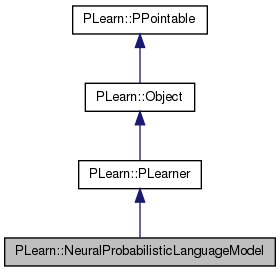
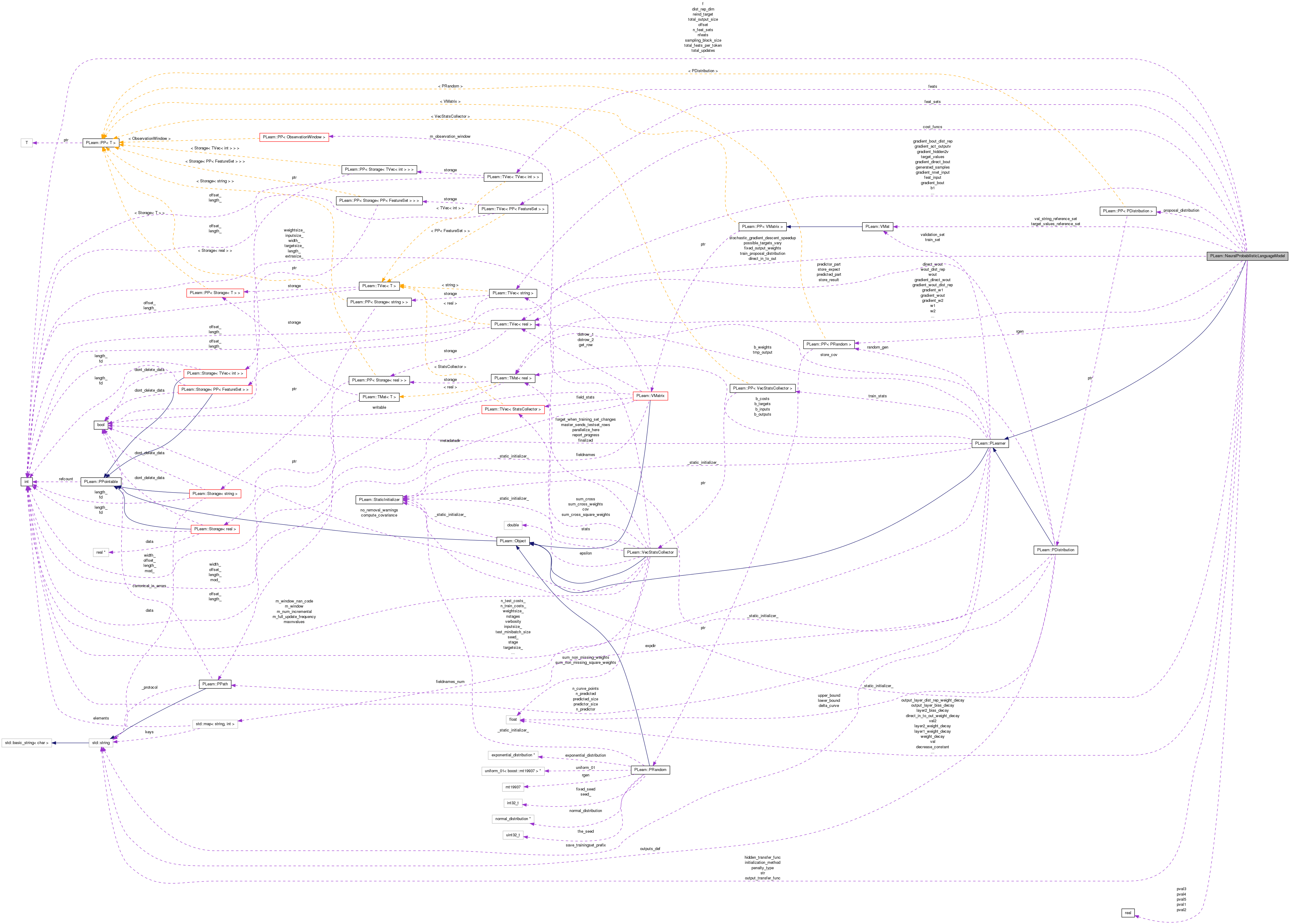
Public Member Functions | |
| NeuralProbabilisticLanguageModel () | |
| virtual | ~NeuralProbabilisticLanguageModel () |
| virtual string | classname () const |
| virtual OptionList & | getOptionList () const |
| virtual OptionMap & | getOptionMap () const |
| virtual RemoteMethodMap & | getRemoteMethodMap () const |
| virtual NeuralProbabilisticLanguageModel * | deepCopy (CopiesMap &copies) const |
| virtual void | build () |
| Finish building the object; just call inherited::build followed by build_() | |
| virtual void | forget () |
| *** SUBCLASS WRITING: *** | |
| virtual int | outputsize () const |
| SUBCLASS WRITING: override this so that it returns the size of this learner's output, as a function of its inputsize(), targetsize() and set options. | |
| virtual TVec< string > | getTrainCostNames () const |
| *** SUBCLASS WRITING: *** | |
| virtual TVec< string > | getTestCostNames () const |
| *** SUBCLASS WRITING: *** | |
| virtual void | train () |
| *** SUBCLASS WRITING: *** | |
| virtual void | computeOutput (const Vec &input, Vec &output) const |
| *** SUBCLASS WRITING: *** | |
| virtual void | computeOutputAndCosts (const Vec &input, const Vec &target, Vec &output, Vec &costs) const |
| Default calls computeOutput and computeCostsFromOutputs. | |
| virtual void | computeCostsFromOutputs (const Vec &input, const Vec &output, const Vec &target, Vec &costs) const |
| *** SUBCLASS WRITING: *** | |
| virtual void | makeDeepCopyFromShallowCopy (CopiesMap &copies) |
| Transforms a shallow copy into a deep copy. | |
Static Public Member Functions | |
| static string | _classname_ () |
| static OptionList & | _getOptionList_ () |
| static RemoteMethodMap & | _getRemoteMethodMap_ () |
| static Object * | _new_instance_for_typemap_ () |
| static bool | _isa_ (const Object *o) |
| static void | _static_initialize_ () |
| static const PPath & | declaringFile () |
Public Attributes | |
| Mat | w1 |
| Weights of first hidden layer. | |
| Mat | gradient_w1 |
| Gradient on weights of first hidden layer. | |
| Vec | b1 |
| Bias of first hidden layer. | |
| Vec | gradient_b1 |
| Gradient on bias of first hidden layer. | |
| Mat | w2 |
| Weights of second hidden layer. | |
| Mat | gradient_w2 |
| gradient on weights of second hidden layer | |
| Vec | b2 |
| Bias of second hidden layer. | |
| Vec | gradient_b2 |
| Gradient on bias of second hidden layer. | |
| Mat | wout |
| Weights of output layer. | |
| Mat | gradient_wout |
| Gradient on weights of output layer. | |
| Vec | bout |
| Bias of output layer. | |
| Vec | gradient_bout |
| Gradient on bias of output layer. | |
| Mat | direct_wout |
| Direct input to output weights. | |
| Mat | gradient_direct_wout |
| Gradient on direct input to output weights. | |
| Vec | direct_bout |
| Direct input to output bias (empty, since no bias is used) | |
| Vec | gradient_direct_bout |
| Gradient on direct input to output bias (empty, since no bias is used) | |
| Mat | wout_dist_rep |
| Weights of output layer for distributed representation predictor. | |
| Mat | gradient_wout_dist_rep |
| Gradient on weights of output layer for distributed representation predictor. | |
| Vec | bout_dist_rep |
| Bias of output layer for distributed representation predictor. | |
| Vec | gradient_bout_dist_rep |
| Gradient on bias of output layer for distributed representation predictor. | |
| int | nhidden |
| Number of hidden nunits in first hidden layer (default:0) | |
| int | nhidden2 |
| Number of hidden units in second hidden layer (default:0) | |
| real | weight_decay |
| Weight decay (default:0) | |
| real | bias_decay |
| Bias decay (default:0) | |
| real | layer1_weight_decay |
| Weight decay for weights from input layer to first hidden layer (default:0) | |
| real | layer1_bias_decay |
| Bias decay for weights from input layer to first hidden layer (default:0) | |
| real | layer2_weight_decay |
| Weight decay for weights from first hidden layer to second hidden layer (default:0) | |
| real | layer2_bias_decay |
| Bias decay for weights from first hidden layer to second hidden layer (default:0) | |
| real | output_layer_weight_decay |
| Weight decay for weights from last hidden layer to output layer (default:0) | |
| real | output_layer_bias_decay |
| Bias decay for weights from last hidden layer to output layer (default:0) | |
| real | direct_in_to_out_weight_decay |
| Weight decay for weights from input directly to output layer (default:0) | |
| real | output_layer_dist_rep_weight_decay |
| Weight decay for weights from last hidden layer to output layer of distributed representation predictor (default:0) | |
| real | output_layer_dist_rep_bias_decay |
| Bias decay for weights from last hidden layer to output layer of distributed representation predictor (default:0) | |
| real | margin |
| Margin requirement, used only with the margin_perceptron_cost cost function (default:1) | |
| bool | fixed_output_weights |
| If true then the output weights are not learned. | |
| bool | direct_in_to_out |
| If true then direct input to output weights will be added (if nhidden > 0) | |
| string | penalty_type |
| Penalty to use on the weights (for weight and bias decay) (default:"L2_square") | |
| string | output_transfer_func |
| Transfer function to use for ouput layer (default:"") | |
| string | hidden_transfer_func |
| Transfer function to use for hidden units (default:"tanh") tanh, sigmoid, softplus, softmax, etc... | |
| TVec< string > | cost_funcs |
| Cost functions. | |
| real | start_learning_rate |
| Start learning rate of gradient descent. | |
| real | decrease_constant |
| Decrease constant of gradietn descent. | |
| int | batch_size |
| Number of samples to use to estimate gradient before an update. | |
| bool | stochastic_gradient_descent_speedup |
| Indication that a trick to speedup stochastic gradient descent should be used. | |
| string | initialization_method |
| Method of initialization for neural network's weights. | |
| int | dist_rep_dim |
| Dimensionality (number of components) of distributed representations If <= 0, than distributed representations will not be used. | |
| bool | possible_targets_vary |
| Indication that the set of possible targets vary from one input vector to another. | |
| TVec< PP< FeatureSet > > | feat_sets |
| FeatureSets to apply on input. | |
| PP< PDistribution > | proposal_distribution |
| Proposal distribution for importance sampling speedup method (Bengio and Senecal 2006). | |
| bool | train_proposal_distribution |
| Indication that the proposal distribution must be trained (using train_set). | |
| int | sampling_block_size |
| Size of the sampling blocks. | |
| int | minimum_effective_sample_size |
| Minimum effective sample size. | |
Static Public Attributes | |
| static StaticInitializer | _static_initializer_ |
Protected Member Functions | |
| void | fprop (const Vec &inputv, Vec &outputv, const Vec &targetv, Vec &costsv, real sampleweight=1) const |
| Forward propagation in the network. | |
| void | fpropOutput (const Vec &inputv, Vec &outputv) const |
| Forward propagation to compute the output. | |
| void | fpropBeforeOutputWeights (const Vec &inputv) const |
| Forward propagation until output weights are reached (called by fpropOutput(...) and importance_sampling_gradient_update(...) | |
| void | fpropCostsFromOutput (const Vec &inputv, const Vec &outputv, const Vec &targetv, Vec &costsv, real sampleweight=1) const |
| Forward propagation to compute the costs from the output. | |
| void | bprop (Vec &inputv, Vec &outputv, Vec &targetv, Vec &costsv, real learning_rate, real sampleweight=1) |
| Backward propagation in the network, which assumes that a forward propagation has been done before. | |
| void | update () |
| Update network's parameters. | |
| void | update_affine_transform (Vec input, Mat weights, Vec bias, Mat gweights, Vec gbias, bool input_is_sparse, bool output_is_sparse, Vec output_indices) |
| Update affine transformation's parameters. | |
| void | clearProppathGradient () |
| Clear network's propagation path gradient fields Assumes fprop and bprop have been called before. | |
| virtual void | initializeParams (bool set_seed=true) |
| Initialize the parameters. | |
| void | add_transfer_func (const Vec &input, string transfer_func="default") const |
| Computes the result of the application of the given transfer function on the input vector. | |
| void | gradient_transfer_func (Vec &output, Vec &gradient_input, Vec &gradient_output, string transfer_func="default", int nll_softmax_speed_up_target=-1) |
| Computes the gradient through the given activation function, the output value and the initial gradient on that output (i.e. | |
| void | add_affine_transform (Vec input, Mat weights, Vec bias, Vec output, bool input_is_sparse, bool output_is_sparse, Vec output_indices=Vec(0)) const |
| Applies affine transform on input using provided weights and bias. | |
| void | gradient_affine_transform (Vec input, Mat weights, Vec bias, Vec ginput, Mat gweights, Vec gbias, Vec goutput, bool input_is_sparse, bool output_is_sparse, real learning_rate, real weight_decay, real bias_decay, Vec output_indices=Vec(0)) |
| Propagate gradient through affine transform on input using provided weights and bias. | |
| void | gradient_penalty (Vec input, Mat weights, Vec bias, Mat gweights, Vec gbias, bool input_is_sparse, bool output_is_sparse, real learning_rate, real weight_decay, real bias_decay, Vec output_indices=Vec(0)) |
| Propagate penalty gradient through weights and bias, scaled by -learning rate. | |
| void | importance_sampling_gradient_update (Vec &inputv, Vec &targetv, real learning_rate, int n_samples, real train_sample_weight=1) |
| Update the neural network parameters using the importance sampling estimate of the gradient, based on n_samples of the proposal distribution. | |
| void | getNegativeEnergyValues (Vec samples, Vec neg_energies) |
| Gives scalar negative energy values for some samples (words). | |
| void | fillWeights (const Mat &weights) |
| Fill a matrix of weights according to the 'initialization_method' specified. | |
| void | verify_gradient (Vec &input, Vec target, real step) |
| Verify gradient of propagation path. | |
| void | verify_gradient_affine_transform (Vec global_input, Vec &global_output, Vec &global_targetv, Vec &global_costs, real sampleweight, Vec input, Mat weights, Vec bias, Mat est_gweights, Vec est_gbias, bool input_is_sparse, bool output_is_sparse, real step, Vec output_indices=Vec(0)) const |
| Verify gradient of affine_transform parameters. | |
| void | output_gradient_verification (Vec grad, Vec est_grad) |
| void | batchComputeOutputAndConfidence (VMat inputs, real probability, VMat outputs_and_confidence) const |
| Changes the reference_set and then calls the parent's class method. | |
| virtual void | use (VMat testset, VMat outputs) const |
| Changes the reference_set and then calls the parent's class method. | |
| virtual void | test (VMat testset, PP< VecStatsCollector > test_stats, VMat testoutputs=0, VMat testcosts=0) const |
| Changes the reference_set and then calls the parent's class method. | |
| virtual VMat | processDataSet (VMat dataset) const |
| Changes the reference_set and then calls the parent's class method. | |
Static Protected Member Functions | |
| static void | declareOptions (OptionList &ol) |
| Declares this class' options. | |
Protected Attributes | |
| int | total_output_size |
| Total output size. | |
| int | total_updates |
| Total updates so far;. | |
| int | n_feat_sets |
| Number of feature sets. | |
| int | total_feats_per_token |
| Number of features per input token for which a distributed representation is computed. | |
| int | reind_target |
| Reindexed target. | |
| Vec | feat_input |
| Feature input;. | |
| Vec | gradient_feat_input |
| Gradient on feature input (useless for now) | |
| Vec | nnet_input |
| Input vector to NNet (after mapping into distributed representations) | |
| Vec | gradient_nnet_input |
| Gradient for vector to NNet. | |
| Vec | hiddenv |
| First hidden layer value. | |
| Vec | gradient_hiddenv |
| Gradient of first hidden layer. | |
| Vec | gradient_act_hiddenv |
| Gradient through first hidden layer activation. | |
| Vec | hidden2v |
| Second hidden layer value. | |
| Vec | gradient_hidden2v |
| Gradient of second hidden layer. | |
| Vec | gradient_act_hidden2v |
| Gradient through second hidden layer activation. | |
| Vec | gradient_outputv |
| Gradient on output. | |
| Vec | gradient_act_outputv |
| Gradient throught output layer activation. | |
| PP< PRandom > | rgen |
| Random number generator for parameters initialization. | |
| Vec | feats_since_last_update |
| Features seen in input since last update. | |
| Vec | target_values_since_last_update |
| Possible target values seen since last update. | |
| VMat | val_string_reference_set |
| VMatrix used to get values to string mapping for input tokens. | |
| VMat | target_values_reference_set |
| Possible target values mapping. | |
| Vec | importance_sampling_ratios |
| Importance sampling ratios of the samples. | |
| Vec | sample |
| Generated sample from proposal distribution. | |
| Vec | generated_samples |
| Set of generated samples from the proposal distribution. | |
Private Types | |
| typedef PLearner | inherited |
Private Member Functions | |
| void | build_ () |
| **** SUBCLASS WRITING: **** | |
| void | compute_softmax (const Vec &x, const Vec &y) const |
| Softmax vector y obtained on x This implementation is such that compute_softmax(x,x) is such that x becomes its softmax value. | |
| real | nll (const Vec &outputv, int target) const |
| Negative log-likelihood loss. | |
| real | classification_loss (const Vec &outputv, int target) const |
| Classification loss. | |
| int | my_argmax (const Vec &vec, int default_compare=0) const |
| Argmax function that lets you define the default (first) component used for comparisons. | |
Private Attributes | |
| Vec | target_values |
| Vector of possible target values. | |
| Vec | output_comp |
| Vector for output computations. | |
| Vec | row |
| Row vector. | |
| Vec | last_layer |
| Last layer of network (pointer to either nnet_input, vnhidden or vnhidden2) | |
| Vec | gradient_last_layer |
| Gradient of last layer in back propagation. | |
| TVec< TVec< int > > | feats |
| Features for each token. | |
| Vec | gradient |
| Temporary computations variable, used in fprop() and bprop() Care must be taken when using these variables, since they are used by many different functions. | |
| Vec | neg_energies |
| Vec | densities |
| string | str |
| real * | pval1 |
| real * | pval2 |
| real * | pval3 |
| real * | pval4 |
| real * | pval5 |
| real | val |
| real | val2 |
| real | grad |
| int | offset |
| int | ni |
| int | nj |
| int | nk |
| int | id |
| int | nfeats |
| int | ifeats |
| int * | f |
Feedforward neural network for language modeling.
Implementation of the Neural Probabilistic Language Model proposed by Bengio, Ducharme, Vincent and Jauvin (JMLR 2003), with extentensions to speedup the model (Bengio and SÚnÚcal, AISTATS 2003) and to include prior information about the distributed representation and permit generalization of these distributed representations to out-of-vocabulary words using features (Larochelle and Bengio, Tech Report 2006).
Definition at line 58 of file NeuralProbabilisticLanguageModel.h.
typedef PLearner PLearn::NeuralProbabilisticLanguageModel::inherited [private] |
Reimplemented from PLearn::PLearner.
Definition at line 63 of file NeuralProbabilisticLanguageModel.h.
| PLearn::NeuralProbabilisticLanguageModel::NeuralProbabilisticLanguageModel | ( | ) |
Definition at line 62 of file NeuralProbabilisticLanguageModel.cc.
: rgen(new PRandom()), nhidden(0), nhidden2(0), weight_decay(0), bias_decay(0), layer1_weight_decay(0), layer1_bias_decay(0), layer2_weight_decay(0), layer2_bias_decay(0), output_layer_weight_decay(0), output_layer_bias_decay(0), direct_in_to_out_weight_decay(0), output_layer_dist_rep_weight_decay(0), output_layer_dist_rep_bias_decay(0), fixed_output_weights(0), direct_in_to_out(0), penalty_type("L2_square"), output_transfer_func(""), hidden_transfer_func("tanh"), start_learning_rate(0.01), decrease_constant(0), batch_size(1), stochastic_gradient_descent_speedup(true), initialization_method("uniform_linear"), dist_rep_dim(-1), possible_targets_vary(false), train_proposal_distribution(true), sampling_block_size(50), minimum_effective_sample_size(100) {}
| PLearn::NeuralProbabilisticLanguageModel::~NeuralProbabilisticLanguageModel | ( | ) | [virtual] |
Definition at line 96 of file NeuralProbabilisticLanguageModel.cc.
{
}
| string PLearn::NeuralProbabilisticLanguageModel::_classname_ | ( | ) | [static] |
Reimplemented from PLearn::PLearner.
Definition at line 60 of file NeuralProbabilisticLanguageModel.cc.
| OptionList & PLearn::NeuralProbabilisticLanguageModel::_getOptionList_ | ( | ) | [static] |
Reimplemented from PLearn::PLearner.
Definition at line 60 of file NeuralProbabilisticLanguageModel.cc.
| RemoteMethodMap & PLearn::NeuralProbabilisticLanguageModel::_getRemoteMethodMap_ | ( | ) | [static] |
Reimplemented from PLearn::PLearner.
Definition at line 60 of file NeuralProbabilisticLanguageModel.cc.
Reimplemented from PLearn::PLearner.
Definition at line 60 of file NeuralProbabilisticLanguageModel.cc.
| Object * PLearn::NeuralProbabilisticLanguageModel::_new_instance_for_typemap_ | ( | ) | [static] |
Reimplemented from PLearn::Object.
Definition at line 60 of file NeuralProbabilisticLanguageModel.cc.
| StaticInitializer NeuralProbabilisticLanguageModel::_static_initializer_ & PLearn::NeuralProbabilisticLanguageModel::_static_initialize_ | ( | ) | [static] |
Reimplemented from PLearn::PLearner.
Definition at line 60 of file NeuralProbabilisticLanguageModel.cc.
| void PLearn::NeuralProbabilisticLanguageModel::add_affine_transform | ( | Vec | input, |
| Mat | weights, | ||
| Vec | bias, | ||
| Vec | output, | ||
| bool | input_is_sparse, | ||
| bool | output_is_sparse, | ||
| Vec | output_indices = Vec(0) |
||
| ) | const [protected] |
Applies affine transform on input using provided weights and bias.
Information about the nature of the input and output need to be provided. If bias.length() == 0, then output initial value is used as the bias.
Definition at line 1202 of file NeuralProbabilisticLanguageModel.cc.
References PLearn::TVec< T >::data(), i, j, PLearn::TVec< T >::length(), ni, nj, pval1, pval2, pval3, and PLearn::transposeProductAcc().
Referenced by fpropBeforeOutputWeights(), fpropOutput(), and getNegativeEnergyValues().
{
// Bias
if(bias.length() != 0)
{
if(output_is_sparse)
{
pval1 = output.data();
pval2 = bias.data();
pval3 = output_indices.data();
ni = output.length();
for(int i=0; i<ni; i++)
*pval1++ = pval2[(int)*pval3++];
}
else
{
pval1 = output.data();
pval2 = bias.data();
ni = output.length();
for(int i=0; i<ni; i++)
*pval1++ = *pval2++;
}
}
// Weights
if(!input_is_sparse && !output_is_sparse)
{
transposeProductAcc(output,weights,input);
}
else if(!input_is_sparse && output_is_sparse)
{
ni = output.length();
nj = input.length();
pval1 = output.data();
pval3 = output_indices.data();
for(int i=0; i<ni; i++)
{
pval2 = input.data();
for(int j=0; j<nj; j++)
*pval1 += (*pval2++)*weights(j,(int)*pval3);
pval1++;
pval3++;
}
}
else if(input_is_sparse && !output_is_sparse)
{
ni = input.length();
nj = output.length();
if(ni != 0)
{
pval3 = input.data();
for(int i=0; i<ni; i++)
{
pval1 = output.data();
pval2 = weights[(int)(*pval3++)];
for(int j=0; j<nj;j++)
*pval1++ += *pval2++;
}
}
}
else if(input_is_sparse && output_is_sparse)
{
// Weights
ni = input.length();
nj = output.length();
if(ni != 0)
{
pval2 = input.data();
for(int i=0; i<ni; i++)
{
pval1 = output.data();
pval3 = output_indices.data();
for(int j=0; j<nj; j++)
*pval1++ += weights((int)(*pval2),(int)*pval3++);
pval2++;
}
}
}
}
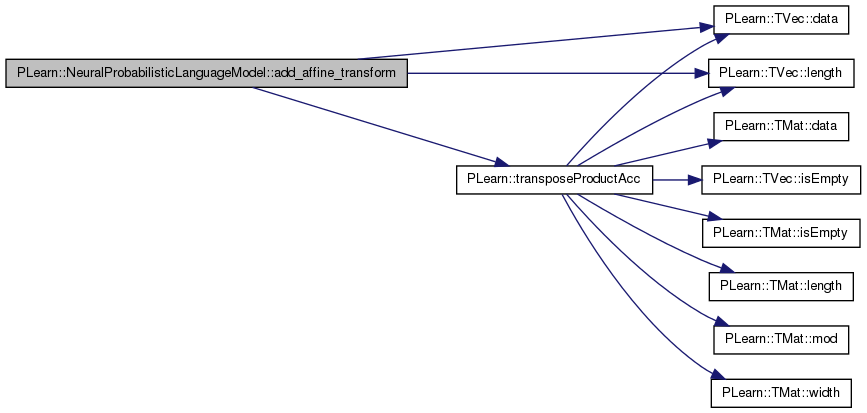

| void PLearn::NeuralProbabilisticLanguageModel::add_transfer_func | ( | const Vec & | input, |
| string | transfer_func = "default" |
||
| ) | const [protected] |
Computes the result of the application of the given transfer function on the input vector.
Definition at line 1083 of file NeuralProbabilisticLanguageModel.cc.
References PLearn::compute_sigmoid(), compute_softmax(), PLearn::compute_tanh(), hidden_transfer_func, and PLERROR.
Referenced by fpropBeforeOutputWeights(), and fpropOutput().
{
if (transfer_func == "default")
transfer_func = hidden_transfer_func;
if(transfer_func=="linear")
return;
else if(transfer_func=="tanh")
{
compute_tanh(input,input);
return;
}
else if(transfer_func=="sigmoid")
{
compute_sigmoid(input,input);
return;
}
else if(transfer_func=="softmax")
{
compute_softmax(input,input);
return;
}
else PLERROR("In NeuralProbabilisticLanguageModel::add_transfer_func(): "
"Unknown value for transfer_func: %s",transfer_func.c_str());
}
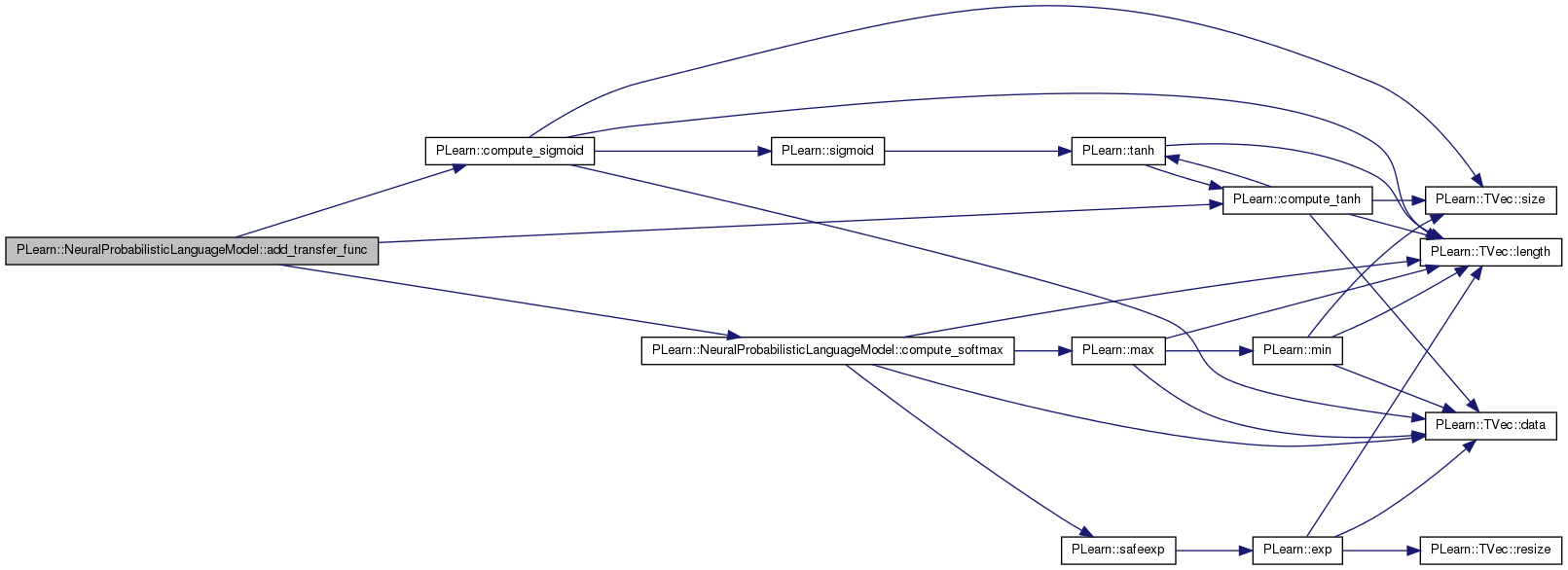

| void PLearn::NeuralProbabilisticLanguageModel::batchComputeOutputAndConfidence | ( | VMat | inputs, |
| real | probability, | ||
| VMat | outputs_and_confidence | ||
| ) | const [protected, virtual] |
Changes the reference_set and then calls the parent's class method.
Reimplemented from PLearn::PLearner.
Definition at line 3082 of file NeuralProbabilisticLanguageModel.cc.
References PLearn::PLearner::batchComputeOutputAndConfidence(), PLearn::PLearner::train_set, and val_string_reference_set.
{
val_string_reference_set = inputs;
inherited::batchComputeOutputAndConfidence(inputs,
probability,
outputs_and_confidence);
val_string_reference_set = train_set;
}

| void PLearn::NeuralProbabilisticLanguageModel::bprop | ( | Vec & | inputv, |
| Vec & | outputv, | ||
| Vec & | targetv, | ||
| Vec & | costsv, | ||
| real | learning_rate, | ||
| real | sampleweight = 1 |
||
| ) | [protected] |
Backward propagation in the network, which assumes that a forward propagation has been done before.
A learning rate needs to be provided because it is -learning_rate * gradient that is propagated, not just the gradient.
Definition at line 624 of file NeuralProbabilisticLanguageModel.cc.
References PLearn::TVec< T >::append(), b1, b2, bias_decay, bout, bout_dist_rep, clearProppathGradient(), cost_funcs, direct_bout, direct_in_to_out, direct_in_to_out_weight_decay, direct_wout, dist_rep_dim, feat_input, feats, feats_since_last_update, gradient_act_hidden2v, gradient_act_hiddenv, gradient_act_outputv, gradient_affine_transform(), gradient_b1, gradient_b2, gradient_bout, gradient_bout_dist_rep, gradient_direct_bout, gradient_direct_wout, gradient_feat_input, gradient_hidden2v, gradient_hiddenv, gradient_last_layer, gradient_nnet_input, gradient_outputv, gradient_transfer_func(), gradient_w1, gradient_w2, gradient_wout, gradient_wout_dist_rep, hidden2v, hiddenv, i, ifeats, PLearn::PLearner::inputsize_, j, layer1_bias_decay, layer1_weight_decay, layer2_bias_decay, layer2_weight_decay, PLearn::TVec< T >::length(), n_feat_sets, nfeats, nhidden, nhidden2, nnet_input, output_layer_bias_decay, output_layer_dist_rep_bias_decay, output_layer_dist_rep_weight_decay, output_layer_weight_decay, output_transfer_func, PLERROR, possible_targets_vary, reind_target, PLearn::TVec< T >::resize(), stochastic_gradient_descent_speedup, PLearn::TVec< T >::subVec(), target_values, target_values_since_last_update, w1, w2, weight_decay, wout, and wout_dist_rep.
Referenced by train(), and verify_gradient().
{
if(possible_targets_vary)
{
gradient_outputv.resize(target_values.length());
gradient_act_outputv.resize(target_values.length());
if(!stochastic_gradient_descent_speedup)
target_values_since_last_update.append(target_values);
}
if(!stochastic_gradient_descent_speedup)
feats_since_last_update.append(feat_input);
// Gradient through cost
if(cost_funcs[0]=="NLL")
{
// Permits to avoid numerical precision errors
if(output_transfer_func == "softmax")
gradient_outputv[reind_target] = learning_rate*sampleweight;
else
gradient_outputv[reind_target] = learning_rate*sampleweight/(outputv[reind_target]);
}
else if(cost_funcs[0]=="class_error")
{
PLERROR("NeuralProbabilisticLanguageModel::bprop(): gradient "
"cannot be computed for \"class_error\" cost");
}
// Gradient through output transfer function
if(output_transfer_func != "linear")
{
if(cost_funcs[0]=="NLL" && output_transfer_func == "softmax")
gradient_transfer_func(outputv,gradient_act_outputv, gradient_outputv,
output_transfer_func, reind_target);
else
gradient_transfer_func(outputv,gradient_act_outputv, gradient_outputv,
output_transfer_func);
gradient_last_layer = gradient_act_outputv;
}
else
gradient_last_layer = gradient_act_outputv;
// Gradient through output affine transform
if(nhidden2 > 0) {
gradient_affine_transform(hidden2v, wout, bout, gradient_hidden2v,
gradient_wout, gradient_bout,
gradient_last_layer,
false, possible_targets_vary,
learning_rate*sampleweight,
weight_decay+output_layer_weight_decay,
bias_decay+output_layer_bias_decay,
target_values);
}
else if(nhidden > 0)
{
gradient_affine_transform(hiddenv, wout, bout, gradient_hiddenv,
gradient_wout, gradient_bout,
gradient_last_layer,
false, possible_targets_vary,
learning_rate*sampleweight,
weight_decay+output_layer_weight_decay,
bias_decay+output_layer_bias_decay,
target_values);
}
else
{
gradient_affine_transform(nnet_input, wout, bout, gradient_nnet_input,
gradient_wout, gradient_bout,
gradient_last_layer,
(dist_rep_dim <= 0), possible_targets_vary,
learning_rate*sampleweight,
weight_decay+output_layer_weight_decay,
bias_decay+output_layer_bias_decay,
target_values);
}
if(nhidden>0 && direct_in_to_out)
{
gradient_affine_transform(nnet_input, direct_wout, direct_bout,
gradient_nnet_input,
gradient_direct_wout, gradient_direct_bout,
gradient_last_layer,
dist_rep_dim<=0, possible_targets_vary,
learning_rate*sampleweight,
weight_decay+direct_in_to_out_weight_decay,
0,
target_values);
}
if(nhidden2 > 0)
{
gradient_transfer_func(hidden2v,gradient_act_hidden2v,gradient_hidden2v);
gradient_affine_transform(hiddenv, w2, b2, gradient_hiddenv,
gradient_w2, gradient_b2, gradient_act_hidden2v,
false, false,learning_rate*sampleweight,
weight_decay+layer2_weight_decay,
bias_decay+layer2_bias_decay);
}
if(nhidden > 0)
{
gradient_transfer_func(hiddenv,gradient_act_hiddenv,gradient_hiddenv);
gradient_affine_transform(nnet_input, w1, b1, gradient_nnet_input,
gradient_w1, gradient_b1, gradient_act_hiddenv,
dist_rep_dim<=0, false,learning_rate*sampleweight,
weight_decay+layer1_weight_decay,
bias_decay+layer1_bias_decay);
}
if(dist_rep_dim > 0)
{
nfeats = 0;
id = 0;
for(int i=0; i<inputsize_; )
{
ifeats = 0;
for(int j=0; j<n_feat_sets; j++,i++)
ifeats += feats[i].length();
gradient_affine_transform(feat_input.subVec(nfeats,ifeats),
wout_dist_rep, bout_dist_rep,
//gradient_feat_input.subVec(nfeats,feats[i].length()),
gradient_feat_input,// Useless anyways...
gradient_wout_dist_rep,
gradient_bout_dist_rep,
gradient_nnet_input.subVec(
id*dist_rep_dim,dist_rep_dim),
true, false, learning_rate*sampleweight,
weight_decay+
output_layer_dist_rep_weight_decay,
bias_decay+output_layer_dist_rep_bias_decay);
nfeats += ifeats;
id++;
}
}
clearProppathGradient();
}
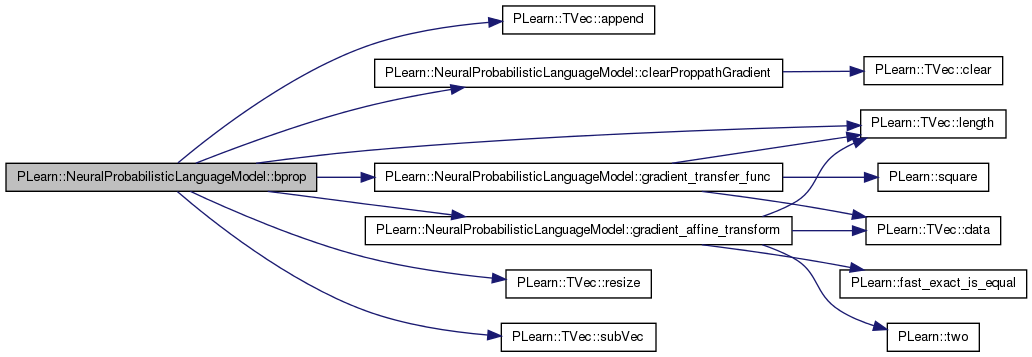

| void PLearn::NeuralProbabilisticLanguageModel::build | ( | ) | [virtual] |
Finish building the object; just call inherited::build followed by build_()
Reimplemented from PLearn::PLearner.
Definition at line 357 of file NeuralProbabilisticLanguageModel.cc.
References PLearn::PLearner::build(), and build_().
Referenced by forget().
{
inherited::build();
build_();
}
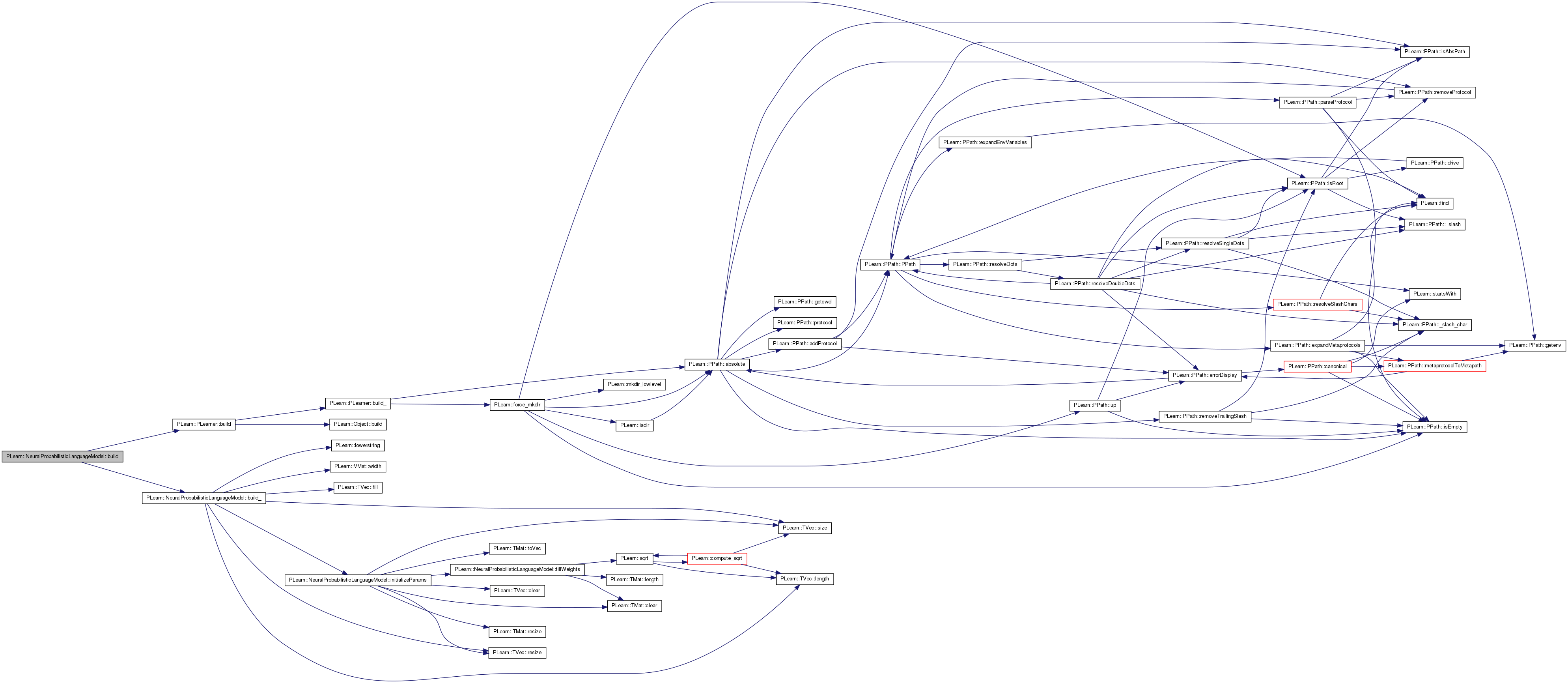

| void PLearn::NeuralProbabilisticLanguageModel::build_ | ( | ) | [private] |
**** SUBCLASS WRITING: ****
This method should finish building of the object, according to set 'options', in *any* situation.
Typical situations include:
You can assume that the parent class' build_() has already been called.
A typical build method will want to know the inputsize(), targetsize() and outputsize(), and may also want to check whether train_set->hasWeights(). All these methods require a train_set to be set, so the first thing you may want to do, is check if(train_set), before doing any heavy building...
Note: build() is always called by setTrainingSet.
Reimplemented from PLearn::PLearner.
Definition at line 367 of file NeuralProbabilisticLanguageModel.cc.
References batch_size, cost_funcs, feat_sets, feats, PLearn::TVec< T >::fill(), fixed_output_weights, i, initializeParams(), PLearn::PLearner::inputsize_, PLearn::TVec< T >::length(), PLearn::lowerstring(), MISSING_VALUE, n_feat_sets, output_comp, penalty_type, PLERROR, PLWARNING, proposal_distribution, PLearn::TVec< T >::resize(), row, sample, PLearn::TVec< T >::size(), PLearn::PLearner::stage, stochastic_gradient_descent_speedup, target_values_reference_set, PLearn::PLearner::targetsize_, total_output_size, train_proposal_distribution, PLearn::PLearner::train_set, val_string_reference_set, PLearn::PLearner::weightsize_, and PLearn::VMat::width().
Referenced by build().
{
// Don't do anything if we don't have a train_set
// It's the only one who knows the inputsize, targetsize and weightsize
if(inputsize_>=0 && targetsize_>=0 && weightsize_>=0)
{
if(targetsize_ != 1)
PLERROR("In NeuralProbabilisticLanguageModel::build_(): "
"targetsize_ must be 1, not %d",targetsize_);
n_feat_sets = feat_sets.length();
if(n_feat_sets == 0)
PLERROR("In NeuralProbabilisticLanguageModel::build_(): "
"at least one FeatureSet must be provided\n");
if(inputsize_ % n_feat_sets != 0)
PLERROR("In NeuralProbabilisticLanguageModel::build_(): "
"feat_sets.length() must be a divisor of inputsize()");
// Process penalty type option
string pt = lowerstring( penalty_type );
if( pt == "l1" )
penalty_type = "L1";
else if( pt == "l2_square" || pt == "l2 square" || pt == "l2square" )
penalty_type = "L2_square";
else if( pt == "l2" )
{
PLWARNING("In NeuralProbabilisticLanguageModel::build_(): "
"L2 penalty not supported, assuming you want L2 square");
penalty_type = "L2_square";
}
else
PLERROR("In NeuralProbabilisticLanguageModel::build_(): "
"penalty_type \"%s\" not supported", penalty_type.c_str());
int ncosts = cost_funcs.size();
if(ncosts<=0)
PLERROR("In NeuralProbabilisticLanguageModel::build_(): "
"Empty cost_funcs : must at least specify the cost "
"function to optimize!");
if(stage <= 0 ) // Training hasn't started
{
// Initialize parameters
initializeParams();
}
output_comp.resize(total_output_size);
row.resize(train_set->width());
row.fill(MISSING_VALUE);
feats.resize(inputsize_);
// Making sure that all feats[i] have non null storage...
for(int i=0; i<feats.length(); i++)
{
feats[i].resize(1);
feats[i].resize(0);
}
if(fixed_output_weights && stochastic_gradient_descent_speedup)
PLERROR("In NeuralProbabilisticLanguageModel::build_(): "
"cannot use stochastic gradient descent speedup with "
"fixed output weights");
val_string_reference_set = train_set;
target_values_reference_set = train_set;
if(proposal_distribution)
{
if(batch_size != 1)
PLERROR("In NeuralProbabilisticLanguageModel::build_(): "
"importance sampling speedup is not implemented for"
"batch size != 1");
sample.resize(1);
if(train_proposal_distribution)
{
proposal_distribution->setTrainingSet(train_set);
proposal_distribution->train();
}
}
}
}
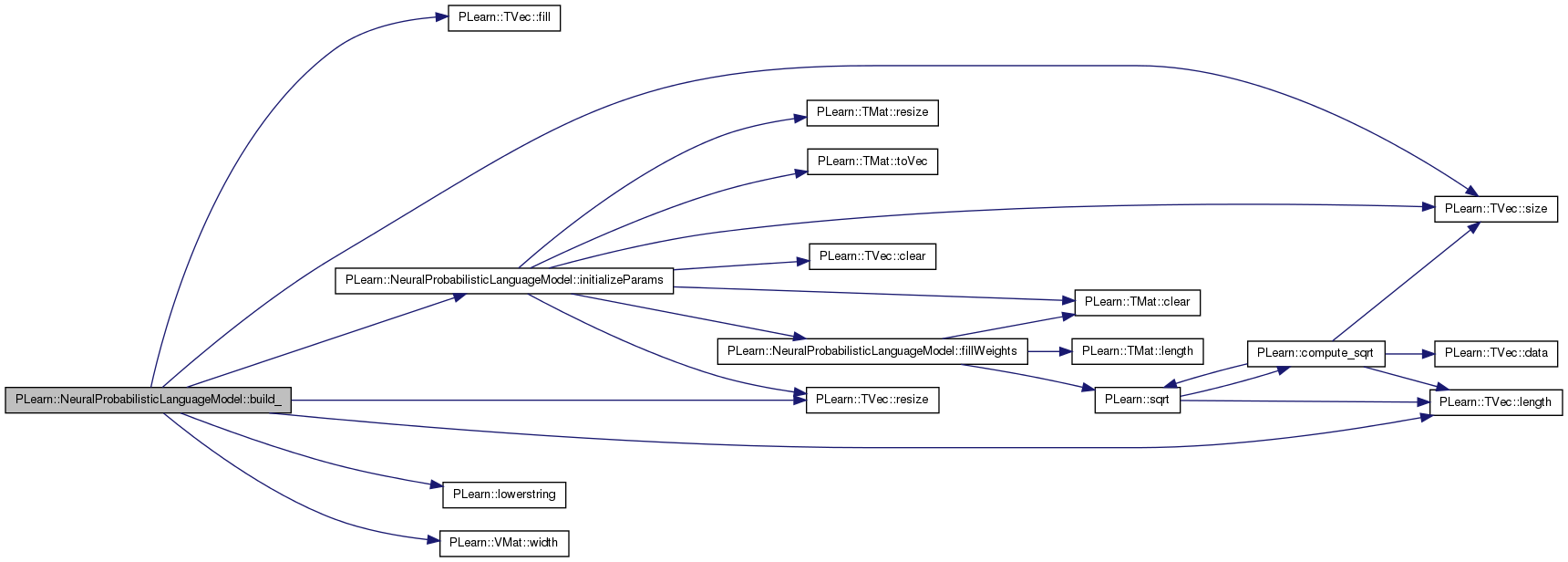

| real PLearn::NeuralProbabilisticLanguageModel::classification_loss | ( | const Vec & | outputv, |
| int | target | ||
| ) | const [private] |
Classification loss.
Definition at line 2174 of file NeuralProbabilisticLanguageModel.cc.
References PLearn::argmax().
Referenced by fpropCostsFromOutput().
{
return (argmax(outputv) == target ? 0 : 1);
}


| string PLearn::NeuralProbabilisticLanguageModel::classname | ( | ) | const [virtual] |
Reimplemented from PLearn::Object.
Definition at line 60 of file NeuralProbabilisticLanguageModel.cc.
Referenced by train().

| void PLearn::NeuralProbabilisticLanguageModel::clearProppathGradient | ( | ) | [protected] |
Clear network's propagation path gradient fields Assumes fprop and bprop have been called before.
Clear network's gradient fields.
Definition at line 937 of file NeuralProbabilisticLanguageModel.cc.
References PLearn::TVec< T >::clear(), cost_funcs, dist_rep_dim, gradient_act_hidden2v, gradient_act_hiddenv, gradient_act_outputv, gradient_hidden2v, gradient_hiddenv, gradient_nnet_input, gradient_outputv, nhidden, nhidden2, and reind_target.
Referenced by bprop(), importance_sampling_gradient_update(), and verify_gradient().
{
// Trick to make clearProppathGradient faster...
if(cost_funcs[0]=="NLL")
gradient_outputv[reind_target] = 0;
else
gradient_outputv.clear();
gradient_act_outputv.clear();
if(dist_rep_dim>0)
gradient_nnet_input.clear();
if(nhidden>0)
{
gradient_hiddenv.clear();
gradient_act_hiddenv.clear();
if(nhidden2>0)
{
gradient_hidden2v.clear();
gradient_act_hidden2v.clear();
}
}
}


| void PLearn::NeuralProbabilisticLanguageModel::compute_softmax | ( | const Vec & | x, |
| const Vec & | y | ||
| ) | const [private] |
Softmax vector y obtained on x This implementation is such that compute_softmax(x,x) is such that x becomes its softmax value.
Definition at line 2140 of file NeuralProbabilisticLanguageModel.cc.
References PLearn::TVec< T >::data(), i, PLearn::TVec< T >::length(), PLearn::max(), n, PLERROR, and PLearn::safeexp().
Referenced by add_transfer_func().
{
int n = x.length();
// real* yp = y.data();
// real* xp = x.data();
// for(int i=0; i<n; i++)
// {
// *yp++ = *xp > 1e-5 ? *xp : 1e-5;
// xp++;
// }
if (n>0)
{
real* yp = y.data();
real* xp = x.data();
real maxx = max(x);
real s = 0;
for (int i=0;i<n;i++)
s += (*yp++ = safeexp(*xp++-maxx));
if (s == 0) PLERROR("trying to divide by 0 in softmax");
s = 1.0 / s;
yp = y.data();
for (int i=0;i<n;i++)
*yp++ *= s;
}
}


| void PLearn::NeuralProbabilisticLanguageModel::computeCostsFromOutputs | ( | const Vec & | input, |
| const Vec & | output, | ||
| const Vec & | target, | ||
| Vec & | costs | ||
| ) | const [virtual] |
*** SUBCLASS WRITING: ***
This should be defined in subclasses to compute the weighted costs from already computed output. The costs should correspond to the cost names returned by getTestCostNames().
NOTE: In exotic cases, the cost may also depend on some info in the input, that's why the method also gets so see it.
Implements PLearn::PLearner.
Definition at line 965 of file NeuralProbabilisticLanguageModel.cc.
References PLERROR.
{
PLERROR("In NeuralProbabilisticLanguageModel::computeCostsFromOutputs():"
"output is not enough to compute costs");
}
| void PLearn::NeuralProbabilisticLanguageModel::computeOutput | ( | const Vec & | input, |
| Vec & | output | ||
| ) | const [virtual] |
*** SUBCLASS WRITING: ***
This should be defined in subclasses to compute the output from the input.
Reimplemented from PLearn::PLearner.
Definition at line 996 of file NeuralProbabilisticLanguageModel.cc.
References PLearn::argmax(), fpropOutput(), PLearn::TVec< T >::length(), my_argmax(), output_comp, possible_targets_vary, rgen, and target_values.
{
fpropOutput(inputv, output_comp);
if(possible_targets_vary)
{
//row.subVec(0,inputsize_) << inputv;
//target_values_reference_set->getValues(row,inputsize_,target_values);
outputv[0] = target_values[
my_argmax(output_comp,rgen->uniform_multinomial_sample(
output_comp.length()))];
}
else
outputv[0] = argmax(output_comp);
}
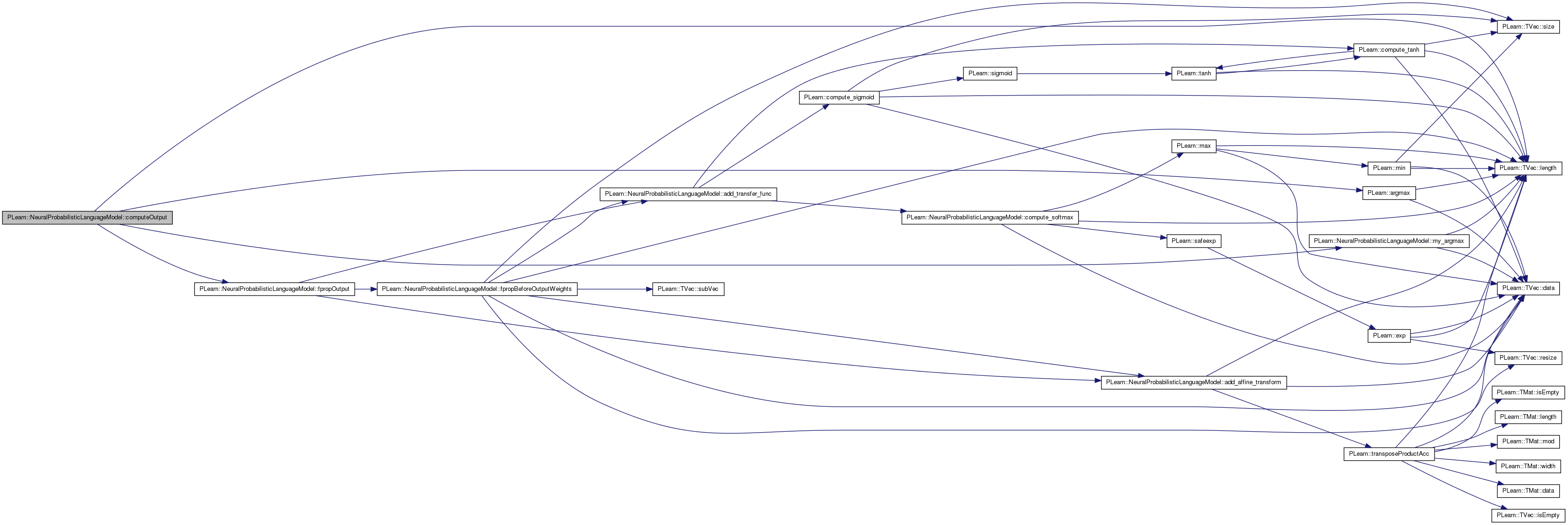
| void PLearn::NeuralProbabilisticLanguageModel::computeOutputAndCosts | ( | const Vec & | input, |
| const Vec & | target, | ||
| Vec & | output, | ||
| Vec & | costs | ||
| ) | const [virtual] |
Default calls computeOutput and computeCostsFromOutputs.
You may override this if you have a more efficient way to compute both output and weighted costs at the same time.
Reimplemented from PLearn::PLearner.
Definition at line 1010 of file Learner.cc.
References PLearn::Learner::computeCostsFromOutputs(), and PLearn::Learner::computeOutput().
{
computeOutput(input, output);
computeCostsFromOutputs(input, output, target, weight, costs);
}

| void PLearn::NeuralProbabilisticLanguageModel::declareOptions | ( | OptionList & | ol | ) | [static, protected] |
Declares this class' options.
Reimplemented from PLearn::PLearner.
Definition at line 100 of file NeuralProbabilisticLanguageModel.cc.
References b1, b2, batch_size, bias_decay, bout, bout_dist_rep, PLearn::OptionBase::buildoption, cost_funcs, PLearn::declareOption(), PLearn::PLearner::declareOptions(), decrease_constant, direct_bout, direct_in_to_out, direct_in_to_out_weight_decay, direct_wout, dist_rep_dim, feat_sets, fixed_output_weights, hidden_transfer_func, initialization_method, layer1_bias_decay, layer1_weight_decay, layer2_bias_decay, layer2_weight_decay, PLearn::OptionBase::learntoption, minimum_effective_sample_size, nhidden, nhidden2, output_layer_bias_decay, output_layer_dist_rep_bias_decay, output_layer_dist_rep_weight_decay, output_layer_weight_decay, output_transfer_func, penalty_type, possible_targets_vary, sampling_block_size, start_learning_rate, stochastic_gradient_descent_speedup, train_proposal_distribution, PLearn::PLearner::train_set, w1, w2, weight_decay, wout, and wout_dist_rep.
{
declareOption(ol, "nhidden", &NeuralProbabilisticLanguageModel::nhidden,
OptionBase::buildoption,
"Number of hidden units in first hidden layer (0 means no "
"hidden layer).\n");
declareOption(ol, "nhidden2", &NeuralProbabilisticLanguageModel::nhidden2,
OptionBase::buildoption,
"Number of hidden units in second hidden layer (0 means no "
"hidden layer).\n");
declareOption(ol, "weight_decay",
&NeuralProbabilisticLanguageModel::weight_decay,
OptionBase::buildoption,
"Global weight decay for all layers.\n");
declareOption(ol, "bias_decay", &NeuralProbabilisticLanguageModel::bias_decay,
OptionBase::buildoption,
"Global bias decay for all layers.\n");
declareOption(ol, "layer1_weight_decay",
&NeuralProbabilisticLanguageModel::layer1_weight_decay,
OptionBase::buildoption,
"Additional weight decay for the first hidden layer. "
"Is added to weight_decay.\n");
declareOption(ol, "layer1_bias_decay",
&NeuralProbabilisticLanguageModel::layer1_bias_decay,
OptionBase::buildoption,
"Additional bias decay for the first hidden layer. "
"Is added to bias_decay.\n");
declareOption(ol, "layer2_weight_decay",
&NeuralProbabilisticLanguageModel::layer2_weight_decay,
OptionBase::buildoption,
"Additional weight decay for the second hidden layer. "
"Is added to weight_decay.\n");
declareOption(ol, "layer2_bias_decay",
&NeuralProbabilisticLanguageModel::layer2_bias_decay,
OptionBase::buildoption,
"Additional bias decay for the second hidden layer. "
"Is added to bias_decay.\n");
declareOption(ol, "output_layer_weight_decay",
&NeuralProbabilisticLanguageModel::output_layer_weight_decay,
OptionBase::buildoption,
"Additional weight decay for the output layer. "
"Is added to 'weight_decay'.\n");
declareOption(ol, "output_layer_bias_decay",
&NeuralProbabilisticLanguageModel::output_layer_bias_decay,
OptionBase::buildoption,
"Additional bias decay for the output layer. "
"Is added to 'bias_decay'.\n");
declareOption(ol, "direct_in_to_out_weight_decay",
&NeuralProbabilisticLanguageModel::direct_in_to_out_weight_decay,
OptionBase::buildoption,
"Additional weight decay for the weights going from the "
"input directly to the \n output layer. Is added to "
"'weight_decay'.\n");
declareOption(ol, "output_layer_dist_rep_weight_decay",
&NeuralProbabilisticLanguageModel::output_layer_dist_rep_weight_decay,
OptionBase::buildoption,
"Additional weight decay for the output layer of distributed"
"representation\n"
"predictor. Is added to 'weight_decay'.\n");
declareOption(ol, "output_layer_dist_rep_bias_decay",
&NeuralProbabilisticLanguageModel::output_layer_dist_rep_bias_decay,
OptionBase::buildoption,
"Additional bias decay for the output layer of distributed"
"representation\n"
"predictor. Is added to 'bias_decay'.\n");
declareOption(ol, "fixed_output_weights",
&NeuralProbabilisticLanguageModel::fixed_output_weights,
OptionBase::buildoption,
"If true then the output weights are not learned. They are"
"initialized to +1 or -1 randomly.\n");
declareOption(ol, "direct_in_to_out",
&NeuralProbabilisticLanguageModel::direct_in_to_out,
OptionBase::buildoption,
"If true then direct input to output weights will be added "
"(if nhidden > 0).\n");
declareOption(ol, "penalty_type",
&NeuralProbabilisticLanguageModel::penalty_type,
OptionBase::buildoption,
"Penalty to use on the weights (for weight and bias decay).\n"
"Can be any of:\n"
" - \"L1\": L1 norm,\n"
" - \"L2_square\" (default): square of the L2 norm.\n");
declareOption(ol, "output_transfer_func",
&NeuralProbabilisticLanguageModel::output_transfer_func,
OptionBase::buildoption,
"what transfer function to use for ouput layer? One of: \n"
" - \"tanh\" \n"
" - \"sigmoid\" \n"
" - \"softmax\" \n"
"An empty string or \"none\" means no output transfer function \n");
declareOption(ol, "hidden_transfer_func",
&NeuralProbabilisticLanguageModel::hidden_transfer_func,
OptionBase::buildoption,
"What transfer function to use for hidden units? One of \n"
" - \"linear\" \n"
" - \"tanh\" \n"
" - \"sigmoid\" \n"
" - \"softmax\" \n");
declareOption(ol, "cost_funcs", &NeuralProbabilisticLanguageModel::cost_funcs,
OptionBase::buildoption,
"A list of cost functions to use\n"
"in the form \"[ cf1; cf2; cf3; ... ]\" where each function "
"is one of: \n"
" - \"NLL\" (negative log likelihood -log(p[c]) for "
"classification) \n"
" - \"class_error\" (classification error) \n"
"The FIRST function of the list will be used as \n"
"the objective function to optimize \n"
"(possibly with an added weight decay penalty) \n");
declareOption(ol, "start_learning_rate",
&NeuralProbabilisticLanguageModel::start_learning_rate,
OptionBase::buildoption,
"Start learning rate of gradient descent.\n");
declareOption(ol, "decrease_constant",
&NeuralProbabilisticLanguageModel::decrease_constant,
OptionBase::buildoption,
"Decrease constant of gradient descent.\n");
declareOption(ol, "batch_size",
&NeuralProbabilisticLanguageModel::batch_size,
OptionBase::buildoption,
"How many samples to use to estimate the avergage gradient before updating the weights\n"
"0 is equivalent to specifying training_set->length() \n");
declareOption(ol, "stochastic_gradient_descent_speedup",
&NeuralProbabilisticLanguageModel::stochastic_gradient_descent_speedup,
OptionBase::buildoption,
"Indication that a trick to speedup stochastic "
"gradient descent\n"
"should be used.\n");
declareOption(ol, "initialization_method",
&NeuralProbabilisticLanguageModel::initialization_method,
OptionBase::buildoption,
"The method used to initialize the weights:\n"
" - \"normal_linear\" = a normal law with variance "
"1/n_inputs\n"
" - \"normal_sqrt\" = a normal law with variance "
"1/sqrt(n_inputs)\n"
" - \"uniform_linear\" = a uniform law in [-1/n_inputs,"
"1/n_inputs]\n"
" - \"uniform_sqrt\" = a uniform law in [-1/sqrt(n_inputs),"
"1/sqrt(n_inputs)]\n"
" - \"zero\" = all weights are set to 0\n");
declareOption(ol, "dist_rep_dim",
&NeuralProbabilisticLanguageModel::dist_rep_dim,
OptionBase::buildoption,
" Dimensionality (number of components) of distributed "
"representations.\n"
"If <= 0, than distributed representations will not be used.\n"
);
declareOption(ol, "possible_targets_vary",
&NeuralProbabilisticLanguageModel::possible_targets_vary,
OptionBase::buildoption,
"Indication that the set of possible targets vary from\n"
"one input vector to another.\n"
);
declareOption(ol, "feat_sets", &NeuralProbabilisticLanguageModel::feat_sets,
OptionBase::buildoption,
"FeatureSets to apply on input. The number of feature\n"
"sets should be a divisor of inputsize(). The feature\n"
"sets applied to the ith input field is the feature\n"
"set at position i % feat_sets.length().\n"
);
declareOption(ol, "train_proposal_distribution",
&NeuralProbabilisticLanguageModel::train_proposal_distribution
OptionBase::buildoption,
"Indication that the proposal distribution must be trained\n"
"(using train_set).\n"
);
declareOption(ol, "sampling_block_size",
&NeuralProbabilisticLanguageModel::sampling_block_size,
OptionBase::buildoption,
"Size of the sampling blocks.\n"
);
declareOption(ol, "minimum_effective_sample_size",
&NeuralProbabilisticLanguageModel::minimum_effective_sample_size,
OptionBase::buildoption,
"Minimum effective sample size.\n"
);
declareOption(ol, "train_set", &NeuralProbabilisticLanguageModel::train_set,
OptionBase::learntoption,
"VMatrix used for training, that also provides information about the data (e.g. Dictionary objects for the different fields).\n");
// Networks' learnt parameters
declareOption(ol, "w1", &NeuralProbabilisticLanguageModel::w1,
OptionBase::learntoption,
"Weights of first hidden layer.\n");
declareOption(ol, "b1", &NeuralProbabilisticLanguageModel::b1,
OptionBase::learntoption,
"Bias of first hidden layer.\n");
declareOption(ol, "w2", &NeuralProbabilisticLanguageModel::w2,
OptionBase::learntoption,
"Weights of second hidden layer.\n");
declareOption(ol, "b2", &NeuralProbabilisticLanguageModel::b2,
OptionBase::learntoption,
"Bias of second hidden layer.\n");
declareOption(ol, "wout", &NeuralProbabilisticLanguageModel::wout,
OptionBase::learntoption,
"Weights of output layer.\n");
declareOption(ol, "bout", &NeuralProbabilisticLanguageModel::bout,
OptionBase::learntoption,
"Bias of output layer.\n");
declareOption(ol, "direct_wout",
&NeuralProbabilisticLanguageModel::direct_wout,
OptionBase::learntoption,
"Direct input to output weights.\n");
declareOption(ol, "direct_bout",
&NeuralProbabilisticLanguageModel::direct_bout,
OptionBase::learntoption,
"Direct input to output bias.\n");
declareOption(ol, "wout_dist_rep",
&NeuralProbabilisticLanguageModel::wout_dist_rep,
OptionBase::learntoption,
"Weights of output layer for distributed representation "
"predictor.\n");
declareOption(ol, "bout_dist_rep",
&NeuralProbabilisticLanguageModel::bout_dist_rep,
OptionBase::learntoption,
"Bias of output layer for distributed representation "
"predictor.\n");
inherited::declareOptions(ol);
}

| static const PPath& PLearn::NeuralProbabilisticLanguageModel::declaringFile | ( | ) | [inline, static] |
Reimplemented from PLearn::PLearner.
Definition at line 311 of file NeuralProbabilisticLanguageModel.h.
:
static void declareOptions(OptionList& ol);
| NeuralProbabilisticLanguageModel * PLearn::NeuralProbabilisticLanguageModel::deepCopy | ( | CopiesMap & | copies | ) | const [virtual] |
Reimplemented from PLearn::PLearner.
Definition at line 60 of file NeuralProbabilisticLanguageModel.cc.
| void PLearn::NeuralProbabilisticLanguageModel::fillWeights | ( | const Mat & | weights | ) | [protected] |
Fill a matrix of weights according to the 'initialization_method' specified.
Definition at line 1037 of file NeuralProbabilisticLanguageModel.cc.
References PLearn::TMat< T >::clear(), initialization_method, PLearn::TMat< T >::length(), rgen, and PLearn::sqrt().
Referenced by initializeParams().
{
if (initialization_method == "zero") {
weights.clear();
return;
}
real delta;
int is = weights.length();
if (initialization_method.find("linear") != string::npos)
delta = 1.0 / real(is);
else
delta = 1.0 / sqrt(real(is));
if (initialization_method.find("normal") != string::npos)
rgen->fill_random_normal(weights, 0, delta);
else
rgen->fill_random_uniform(weights, -delta, delta);
}


| void PLearn::NeuralProbabilisticLanguageModel::forget | ( | ) | [virtual] |
*** SUBCLASS WRITING: ***
(Re-)initializes the PLearner in its fresh state (that state may depend on the 'seed' option) and sets 'stage' back to 0 (this is the stage of a fresh learner!)
A typical forget() method should do the following:
This method is typically called by the build_() method, after it has finished setting up the parameters, and if it deemed useful to set or reset the learner in its fresh state. (remember build may be called after modifying options that do not necessarily require the learner to restart from a fresh state...) forget is also called by the setTrainingSet method, after calling build(), so it will generally be called TWICE during setTrainingSet!
Reimplemented from PLearn::PLearner.
Definition at line 1057 of file NeuralProbabilisticLanguageModel.cc.
References build(), PLearn::PLearner::stage, total_updates, and PLearn::PLearner::train_set.
{
if (train_set) build();
total_updates=0;
stage = 0;
}
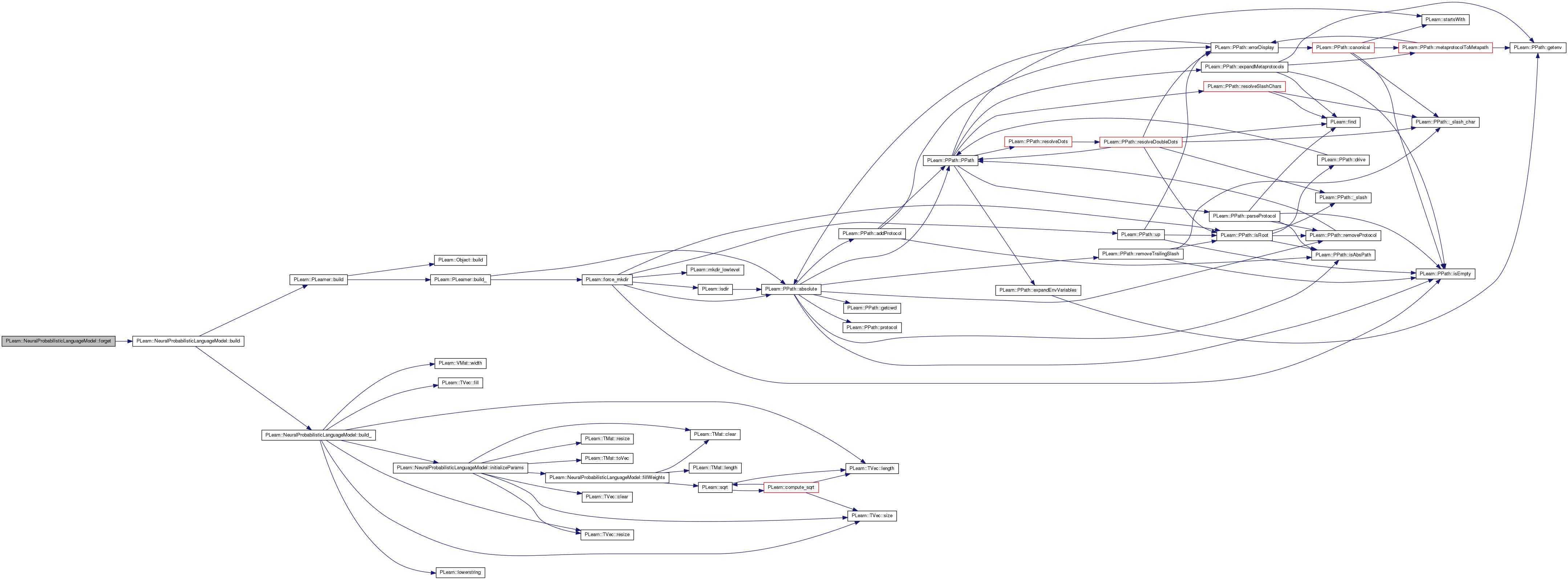
| void PLearn::NeuralProbabilisticLanguageModel::fprop | ( | const Vec & | inputv, |
| Vec & | outputv, | ||
| const Vec & | targetv, | ||
| Vec & | costsv, | ||
| real | sampleweight = 1 |
||
| ) | const [protected] |
Forward propagation in the network.
Definition at line 449 of file NeuralProbabilisticLanguageModel.cc.
References fpropCostsFromOutput(), and fpropOutput().
Referenced by train(), verify_gradient(), and verify_gradient_affine_transform().
{
fpropOutput(inputv,outputv);
//if(is_missing(outputv[0]))
// cout << "What the fuck" << endl;
fpropCostsFromOutput(inputv, outputv, targetv, costsv, sampleweight);
//if(is_missing(costsv[0]))
// cout << "Re-What the fuck" << endl;
}
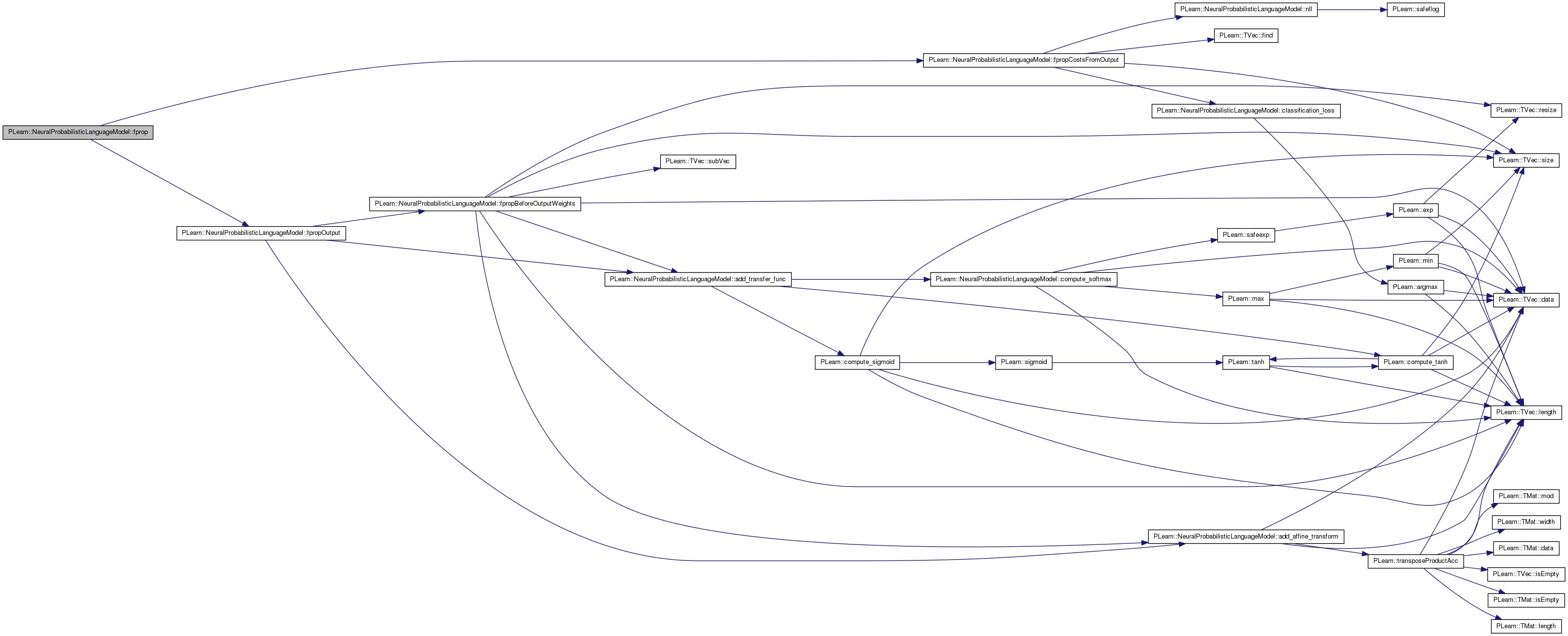

| void PLearn::NeuralProbabilisticLanguageModel::fpropBeforeOutputWeights | ( | const Vec & | inputv | ) | const [protected] |
Forward propagation until output weights are reached (called by fpropOutput(...) and importance_sampling_gradient_update(...)
Definition at line 499 of file NeuralProbabilisticLanguageModel.cc.
References add_affine_transform(), add_transfer_func(), b1, b2, bout_dist_rep, PLearn::TVec< T >::data(), dist_rep_dim, f, feat_input, feat_sets, feats, hidden2v, hiddenv, i, ifeats, PLearn::PLearner::inputsize_, j, last_layer, PLearn::TVec< T >::length(), n_feat_sets, nfeats, nhidden, nhidden2, ni, nj, nnet_input, offset, possible_targets_vary, PLearn::TVec< T >::resize(), row, PLearn::TVec< T >::size(), str, PLearn::TVec< T >::subVec(), target_values, target_values_reference_set, val_string_reference_set, w1, w2, and wout_dist_rep.
Referenced by fpropOutput(), and importance_sampling_gradient_update().
{
// Get possible target values
if(possible_targets_vary)
{
row.subVec(0,inputsize_) << inputv;
target_values_reference_set->getValues(row,inputsize_,target_values);
outputv.resize(target_values.length());
}
// Get features
ni = inputsize_;
nfeats = 0;
for(int i=0; i<ni; i++)
{
str = val_string_reference_set->getValString(i,inputv[i]);
feat_sets[i%n_feat_sets]->getFeatures(str,feats[i]);
nfeats += feats[i].length();
}
feat_input.resize(nfeats);
offset = 0;
id = 0;
for(int i=0; i<ni; i++)
{
f = feats[i].data();
nj = feats[i].length();
for(int j=0; j<nj; j++)
feat_input[id++] = offset + *f++;
if(dist_rep_dim <= 0 || ((i+1) % n_feat_sets != 0))
offset += feat_sets[i % n_feat_sets]->size();
else
offset = 0;
}
// Fprop up to output weights
if(dist_rep_dim > 0) // x -> d(x)
{
nfeats = 0;
id = 0;
for(int i=0; i<inputsize_;)
{
ifeats = 0;
for(int j=0; j<n_feat_sets; j++,i++)
ifeats += feats[i].length();
add_affine_transform(feat_input.subVec(nfeats,ifeats),
wout_dist_rep, bout_dist_rep,
nnet_input.subVec(id*dist_rep_dim,dist_rep_dim),
true, false);
nfeats += ifeats;
id++;
}
if(nhidden>0) // d(x) -> h1(d(x))
{
add_affine_transform(nnet_input,w1,b1,hiddenv,false,false);
add_transfer_func(hiddenv);
if(nhidden2>0) // h1(d(x)) -> h2(h1(d(x)))
{
add_affine_transform(hiddenv,w2,b2,hidden2v,false,false);
add_transfer_func(hidden2v);
last_layer = hidden2v;
}
else
last_layer = hiddenv;
}
else
last_layer = nnet_input;
}
else
{
if(nhidden>0) // x -> h1(x)
{
add_affine_transform(feat_input,w1,b1,hiddenv,true,false);
// Transfert function
add_transfer_func(hiddenv);
if(nhidden2>0) // h1(x) -> h2(h1(x))
{
add_affine_transform(hiddenv,w2,b2,hidden2v,true,false);
add_transfer_func(hidden2v);
last_layer = hidden2v;
}
else
last_layer = hiddenv;
}
else
last_layer = feat_input;
}
}
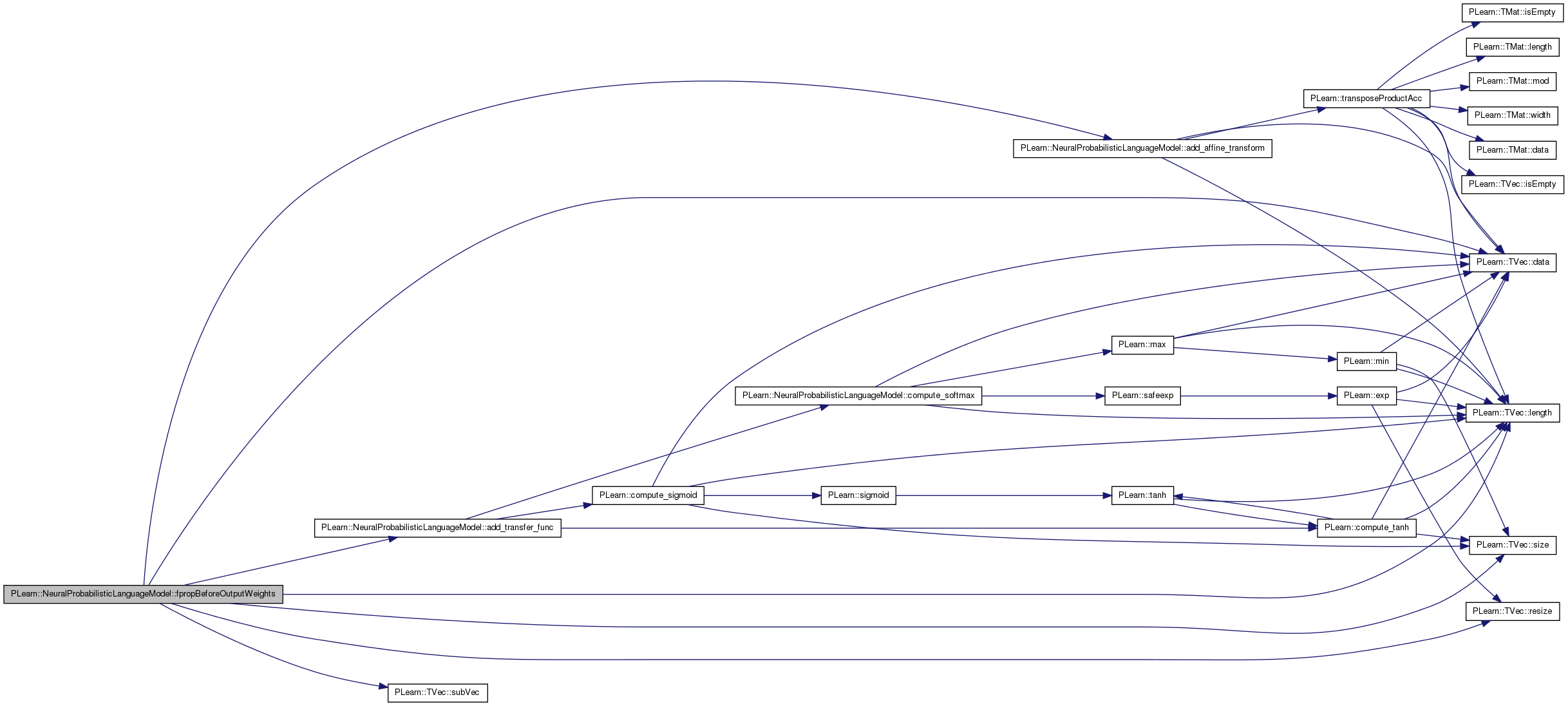

| void PLearn::NeuralProbabilisticLanguageModel::fpropCostsFromOutput | ( | const Vec & | inputv, |
| const Vec & | outputv, | ||
| const Vec & | targetv, | ||
| Vec & | costsv, | ||
| real | sampleweight = 1 |
||
| ) | const [protected] |
Forward propagation to compute the costs from the output.
Definition at line 594 of file NeuralProbabilisticLanguageModel.cc.
References classification_loss(), cost_funcs, PLearn::TVec< T >::find(), nll(), PLERROR, possible_targets_vary, reind_target, PLearn::TVec< T >::size(), and target_values.
Referenced by fprop().
{
//Compute cost
if(possible_targets_vary)
{
reind_target = target_values.find(targetv[0]);
if(reind_target<0)
PLERROR("In NeuralProbabilisticLanguageModel::fprop(): target %d is not in possible targets", targetv[0]);
}
else
reind_target = (int)targetv[0];
// Build cost function
int ncosts = cost_funcs.size();
for(int k=0; k<ncosts; k++)
{
if(cost_funcs[k]=="NLL")
{
costsv[k] = sampleweight*nll(outputv,reind_target);
}
else if(cost_funcs[k]=="class_error")
costsv[k] = sampleweight*classification_loss(outputv, reind_target);
else
PLERROR("In NeuralProbabilisticLanguageModel::fprop(): "
"unknown cost_func option: %s",cost_funcs[k].c_str());
}
}


| void PLearn::NeuralProbabilisticLanguageModel::fpropOutput | ( | const Vec & | inputv, |
| Vec & | outputv | ||
| ) | const [protected] |
Forward propagation to compute the output.
Definition at line 463 of file NeuralProbabilisticLanguageModel.cc.
References add_affine_transform(), add_transfer_func(), bout, direct_bout, direct_in_to_out, direct_wout, dist_rep_dim, feat_input, fpropBeforeOutputWeights(), last_layer, nhidden, nhidden2, nnet_input, output_transfer_func, PLERROR, possible_targets_vary, target_values, and wout.
Referenced by computeOutput(), and fprop().
{
// Forward propagation until reaches output weights, sets last_layer
fpropBeforeOutputWeights(inputv);
if(dist_rep_dim > 0) // x -> d(x)
{
// d(x),h1(d(x)),h2(h1(d(x))) -> o(x)
add_affine_transform(last_layer,wout,bout,outputv,false,
possible_targets_vary,target_values);
if(direct_in_to_out && nhidden>0)
add_affine_transform(nnet_input,direct_wout,direct_bout,
outputv,false,possible_targets_vary,
target_values);
}
else
{
// x, h1(x),h2(h1(x)) -> o(x)
add_affine_transform(last_layer,wout,bout,outputv,nhidden<=0,
possible_targets_vary,target_values);
if(direct_in_to_out && nhidden>0)
add_affine_transform(feat_input,direct_wout,direct_bout,
outputv,true,possible_targets_vary,
target_values);
}
if (nhidden2>0 && nhidden<=0)
PLERROR("NeuralProbabilisticLanguageModel::fprop(): "
"can't have nhidden2 (=%d) > 0 while nhidden=0",nhidden2);
if(output_transfer_func!="" && output_transfer_func!="none")
add_transfer_func(outputv, output_transfer_func);
}
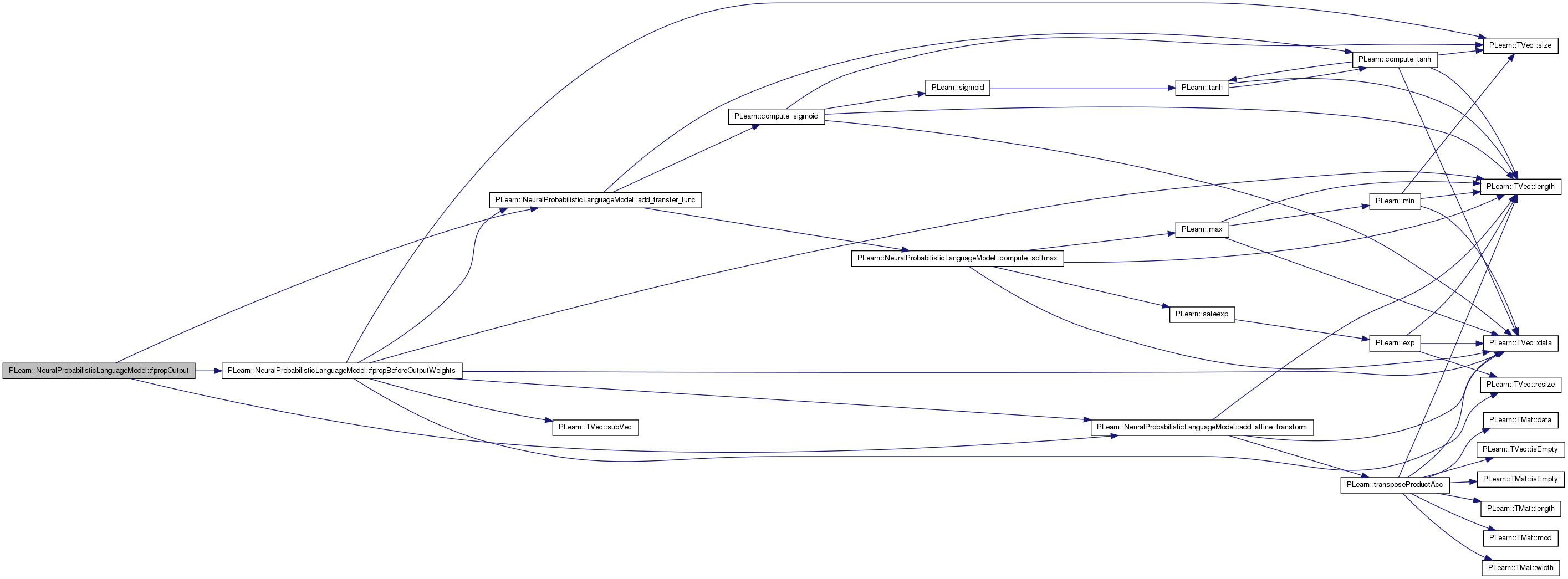

| void PLearn::NeuralProbabilisticLanguageModel::getNegativeEnergyValues | ( | Vec | samples, |
| Vec | neg_energies | ||
| ) | [protected] |
Gives scalar negative energy values for some samples (words).
Assumes fpropBeforeOutputWeights has been called previously.
Definition at line 2114 of file NeuralProbabilisticLanguageModel.cc.
References add_affine_transform(), bout, direct_bout, direct_in_to_out, direct_wout, dist_rep_dim, feat_input, last_layer, nhidden, nnet_input, and wout.
Referenced by importance_sampling_gradient_update().
{
if(dist_rep_dim > 0) // x -> d(x)
{
// d(x),h1(d(x)),h2(h1(d(x))) -> o(x)
add_affine_transform(last_layer,wout,bout,neg_energies,false,
true,samples);
if(direct_in_to_out && nhidden>0)
add_affine_transform(nnet_input,direct_wout,direct_bout,
neg_energies,false,true,
samples);
}
else
{
// x, h1(x),h2(h1(x)) -> o(x)
add_affine_transform(last_layer,wout,bout,samples,nhidden<=0,
true,samples);
if(direct_in_to_out && nhidden>0)
add_affine_transform(feat_input,direct_wout,direct_bout,
neg_energies,true,true,
samples);
}
}


| OptionList & PLearn::NeuralProbabilisticLanguageModel::getOptionList | ( | ) | const [virtual] |
Reimplemented from PLearn::Object.
Definition at line 60 of file NeuralProbabilisticLanguageModel.cc.
| OptionMap & PLearn::NeuralProbabilisticLanguageModel::getOptionMap | ( | ) | const [virtual] |
Reimplemented from PLearn::Object.
Definition at line 60 of file NeuralProbabilisticLanguageModel.cc.
| RemoteMethodMap & PLearn::NeuralProbabilisticLanguageModel::getRemoteMethodMap | ( | ) | const [virtual] |
Reimplemented from PLearn::Object.
Definition at line 60 of file NeuralProbabilisticLanguageModel.cc.
| TVec< string > PLearn::NeuralProbabilisticLanguageModel::getTestCostNames | ( | ) | const [virtual] |
*** SUBCLASS WRITING: ***
This should return the names of the costs computed by computeCostsFromOutputs.
Implements PLearn::PLearner.
Definition at line 1075 of file NeuralProbabilisticLanguageModel.cc.
References cost_funcs.
{
return cost_funcs;
}
| TVec< string > PLearn::NeuralProbabilisticLanguageModel::getTrainCostNames | ( | ) | const [virtual] |
*** SUBCLASS WRITING: ***
This should return the names of the objective costs that the train method computes and for which it updates the VecStatsCollector train_stats.
Implements PLearn::PLearner.
Definition at line 1067 of file NeuralProbabilisticLanguageModel.cc.
References cost_funcs.
Referenced by train(), and verify_gradient().
{
return cost_funcs;
}

| void PLearn::NeuralProbabilisticLanguageModel::gradient_affine_transform | ( | Vec | input, |
| Mat | weights, | ||
| Vec | bias, | ||
| Vec | ginput, | ||
| Mat | gweights, | ||
| Vec | gbias, | ||
| Vec | goutput, | ||
| bool | input_is_sparse, | ||
| bool | output_is_sparse, | ||
| real | learning_rate, | ||
| real | weight_decay, | ||
| real | bias_decay, | ||
| Vec | output_indices = Vec(0) |
||
| ) | [protected] |
Propagate gradient through affine transform on input using provided weights and bias.
Information about the nature of the input and output need to be provided. If bias.length() == 0, then no backprop is made to bias.
Definition at line 1287 of file NeuralProbabilisticLanguageModel.cc.
References bias_decay, PLearn::TVec< T >::data(), PLearn::fast_exact_is_equal(), i, j, PLearn::TVec< T >::length(), ni, nj, penalty_type, pval1, pval2, pval3, pval4, pval5, PLearn::two(), val, val2, and weight_decay.
Referenced by bprop(), and importance_sampling_gradient_update().
{
// Bias
if(bias.length() != 0)
{
if(output_is_sparse)
{
pval1 = gbias.data();
pval2 = goutput.data();
pval3 = output_indices.data();
ni = goutput.length();
if(fast_exact_is_equal(bias_decay, 0))
{
// Without bias decay
for(int i=0; i<ni; i++)
pval1[(int)*pval3++] += *pval2++;
}
else
{
// With bias decay
if(penalty_type == "L2_square")
{
pval4 = bias.data();
val = -two(learning_rate)*bias_decay;
for(int i=0; i<ni; i++)
{
pval1[(int)*pval3] += *pval2++ + val*(pval4[(int)*pval3]);
pval3++;
}
}
else if(penalty_type == "L1")
{
pval4 = bias.data();
val = -learning_rate*bias_decay;
for(int i=0; i<ni; i++)
{
val2 = pval4[(int)*pval3];
if(val2 > 0 )
pval1[(int)*pval3] += *pval2 + val;
else if(val2 < 0)
pval1[(int)*pval3] += *pval2 - val;
pval2++;
pval3++;
}
}
}
}
else
{
pval1 = gbias.data();
pval2 = goutput.data();
ni = goutput.length();
if(fast_exact_is_equal(bias_decay, 0))
{
// Without bias decay
for(int i=0; i<ni; i++)
*pval1++ += *pval2++;
}
else
{
// With bias decay
if(penalty_type == "L2_square")
{
pval3 = bias.data();
val = -two(learning_rate)*bias_decay;
for(int i=0; i<ni; i++)
{
*pval1++ += *pval2++ + val * (*pval3++);
}
}
else if(penalty_type == "L1")
{
pval3 = bias.data();
val = -learning_rate*bias_decay;
for(int i=0; i<ni; i++)
{
if(*pval3 > 0)
*pval1 += *pval2 + val;
else if(*pval3 < 0)
*pval1 += *pval2 - val;
pval1++;
pval2++;
pval3++;
}
}
}
}
}
// Weights and input (when appropriate)
if(!input_is_sparse && !output_is_sparse)
{
// Input
//productAcc(ginput, weights, goutput);
// Weights
//externalProductAcc(gweights, input, goutput);
// Faster code to do this, which limits the accesses
// to memory
ni = input.length();
nj = goutput.length();
pval3 = ginput.data();
pval5 = input.data();
if(fast_exact_is_equal(weight_decay, 0))
{
// Without weight decay
for(int i=0; i<ni; i++) {
pval1 = goutput.data();
pval2 = weights[i];
pval4 = gweights[i];
for(int j=0; j<nj; j++) {
*pval3 += *pval2 * (*pval1);
*pval4 += *pval5 * (*pval1);
pval1++;
pval2++;
pval4++;
}
pval3++;
pval5++;
}
}
else
{
//With weight decay
if(penalty_type == "L2_square")
{
val = -two(learning_rate)*weight_decay;
for(int i=0; i<ni; i++) {
pval1 = goutput.data();
pval2 = weights[i];
pval4 = gweights[i];
for(int j=0; j<nj; j++) {
*pval3 += *pval2 * (*pval1);
*pval4 += *pval5 * (*pval1) + val * (*pval2);
pval1++;
pval2++;
pval4++;
}
pval3++;
pval5++;
}
}
else if(penalty_type == "L1")
{
val = -learning_rate*weight_decay;
for(int i=0; i<ni; i++) {
pval1 = goutput.data();
pval2 = weights[i];
pval4 = gweights[i];
for(int j=0; j<nj; j++) {
*pval3 += *pval2 * (*pval1);
if(*pval2 > 0)
*pval4 += *pval5 * (*pval1) + val;
else if(*pval2 < 0)
*pval4 += *pval5 * (*pval1) - val;
pval1++;
pval2++;
pval4++;
}
pval3++;
pval5++;
}
}
}
}
else if(!input_is_sparse && output_is_sparse)
{
ni = goutput.length();
nj = input.length();
pval1 = goutput.data();
pval3 = output_indices.data();
if(fast_exact_is_equal(weight_decay, 0))
{
// Without weight decay
for(int i=0; i<ni; i++)
{
pval2 = input.data();
pval4 = ginput.data();
for(int j=0; j<nj; j++)
{
// Input
*pval4++ += weights(j,(int)(*pval3))*(*pval1);
// Weights
gweights(j,(int)(*pval3)) += (*pval2++)*(*pval1);
}
pval1++;
pval3++;
}
}
else
{
// With weight decay
if(penalty_type == "L2_square")
{
val = -two(learning_rate)*weight_decay;
for(int i=0; i<ni; i++)
{
pval2 = input.data();
pval4 = ginput.data();
for(int j=0; j<nj; j++)
{
val2 = weights(j,(int)(*pval3));
// Input
*pval4++ += val2*(*pval1);
// Weights
gweights(j,(int)(*pval3)) += (*pval2++)*(*pval1)
+ val*val2;
}
pval1++;
pval3++;
}
}
else if(penalty_type == "L1")
{
val = -learning_rate*weight_decay;
for(int i=0; i<ni; i++)
{
pval2 = input.data();
pval4 = ginput.data();
for(int j=0; j<nj; j++)
{
val2 = weights(j,(int)(*pval3));
// Input
*pval4++ += val2*(*pval1);
// Weights
if(val2 > 0)
gweights(j,(int)(*pval3)) += (*pval2)*(*pval1) + val;
else if(val2 < 0)
gweights(j,(int)(*pval3)) += (*pval2)*(*pval1) - val;
pval2++;
}
pval1++;
pval3++;
}
}
}
}
else if(input_is_sparse && !output_is_sparse)
{
ni = input.length();
nj = goutput.length();
if(fast_exact_is_equal(weight_decay, 0))
{
// Without weight decay
if(ni != 0)
{
pval3 = input.data();
for(int i=0; i<ni; i++)
{
pval1 = goutput.data();
pval2 = gweights[(int)(*pval3++)];
for(int j=0; j<nj;j++)
*pval2++ += *pval1++;
}
}
}
else
{
// With weight decay
if(penalty_type == "L2_square")
{
if(ni != 0)
{
pval3 = input.data();
val = -two(learning_rate)*weight_decay;
for(int i=0; i<ni; i++)
{
pval1 = goutput.data();
pval2 = gweights[(int)(*pval3)];
pval4 = weights[(int)(*pval3++)];
for(int j=0; j<nj;j++)
{
*pval2++ += *pval1++ + val * (*pval4++);
}
}
}
}
else if(penalty_type == "L1")
{
if(ni != 0)
{
pval3 = input.data();
val = learning_rate*weight_decay;
for(int i=0; i<ni; i++)
{
pval1 = goutput.data();
pval2 = gweights[(int)(*pval3)];
pval4 = weights[(int)(*pval3++)];
for(int j=0; j<nj;j++)
{
if(*pval4 > 0)
*pval2 += *pval1 + val;
else if(*pval4 < 0)
*pval2 += *pval1 - val;
pval1++;
pval2++;
pval4++;
}
}
}
}
}
}
else if(input_is_sparse && output_is_sparse)
{
ni = input.length();
nj = goutput.length();
if(fast_exact_is_equal(weight_decay, 0))
{
// Without weight decay
if(ni != 0)
{
pval2 = input.data();
for(int i=0; i<ni; i++)
{
pval1 = goutput.data();
pval3 = output_indices.data();
for(int j=0; j<nj; j++)
gweights((int)(*pval2),(int)*pval3++) += *pval1++;
pval2++;
}
}
}
else
{
// With weight decay
if(penalty_type == "L2_square")
{
if(ni != 0)
{
pval2 = input.data();
val = -two(learning_rate)*weight_decay;
for(int i=0; i<ni; i++)
{
pval1 = goutput.data();
pval3 = output_indices.data();
for(int j=0; j<nj; j++)
{
gweights((int)(*pval2),(int)*pval3)
+= *pval1++
+ val * weights((int)(*pval2),(int)*pval3);
pval3++;
}
pval2++;
}
}
}
else if(penalty_type == "L1")
{
if(ni != 0)
{
pval2 = input.data();
val = -learning_rate*weight_decay;
for(int i=0; i<ni; i++)
{
pval1 = goutput.data();
pval3 = output_indices.data();
for(int j=0; j<nj; j++)
{
val2 = weights((int)(*pval2),(int)*pval3);
if(val2 > 0)
gweights((int)(*pval2),(int)*pval3)
+= *pval1 + val;
else if(val2 < 0)
gweights((int)(*pval2),(int)*pval3)
+= *pval1 - val;
pval1++;
pval3++;
}
pval2++;
}
}
}
}
}
// gradient_penalty(input,weights,bias,gweights,gbias,input_is_sparse,output_is_sparse,
// learning_rate,weight_decay,bias_decay,output_indices);
}


| void PLearn::NeuralProbabilisticLanguageModel::gradient_penalty | ( | Vec | input, |
| Mat | weights, | ||
| Vec | bias, | ||
| Mat | gweights, | ||
| Vec | gbias, | ||
| bool | input_is_sparse, | ||
| bool | output_is_sparse, | ||
| real | learning_rate, | ||
| real | weight_decay, | ||
| real | bias_decay, | ||
| Vec | output_indices = Vec(0) |
||
| ) | [protected] |
Propagate penalty gradient through weights and bias, scaled by -learning rate.
Definition at line 1682 of file NeuralProbabilisticLanguageModel.cc.
References PLearn::TMat< T >::begin(), bias_decay, PLearn::TMat< T >::compact_begin(), PLearn::TMat< T >::compact_end(), PLearn::TVec< T >::data(), PLearn::TMat< T >::end(), PLearn::fast_exact_is_equal(), i, PLearn::TMat< T >::isCompact(), j, PLearn::TVec< T >::length(), PLearn::multiplyAcc(), ni, nj, penalty_type, pval1, pval2, pval3, PLearn::two(), val, val2, and weight_decay.
{
// Bias
if(!fast_exact_is_equal(bias_decay, 0) && !fast_exact_is_equal(bias.length(),
0) )
{
if(output_is_sparse)
{
pval1 = gbias.data();
pval2 = bias.data();
pval3 = output_indices.data();
ni = output_indices.length();
if(penalty_type == "L2_square")
{
val = -two(learning_rate)*bias_decay;
for(int i=0; i<ni; i++)
{
pval1[(int)*pval3] += val*(pval2[(int)*pval3]);
pval3++;
}
}
else if(penalty_type == "L1")
{
val = -learning_rate*bias_decay;
for(int i=0; i<ni; i++)
{
val2 = pval2[(int)*pval3];
if(val2 > 0 )
pval1[(int)*pval3++] += val;
else if(val2 < 0)
pval1[(int)*pval3++] -= val;
}
}
}
else
{
pval1 = gbias.data();
pval2 = bias.data();
ni = output_indices.length();
if(penalty_type == "L2_square")
{
val = -two(learning_rate)*bias_decay;
for(int i=0; i<ni; i++)
*pval1++ += val*(*pval2++);
}
else if(penalty_type == "L1")
{
val = -learning_rate*bias_decay;
for(int i=0; i<ni; i++)
{
if(*pval2 > 0)
*pval1 += val;
else if(*pval2 < 0)
*pval1 -= val;
pval1++;
pval2++;
}
}
}
}
// Weights
if(!fast_exact_is_equal(weight_decay, 0))
{
if(!input_is_sparse && !output_is_sparse)
{
if(penalty_type == "L2_square")
{
multiplyAcc(gweights, weights,-two(learning_rate)*weight_decay);
}
else if(penalty_type == "L1")
{
val = -learning_rate*weight_decay;
if(gweights.isCompact() && weights.isCompact())
{
Mat::compact_iterator itm = gweights.compact_begin();
Mat::compact_iterator itmend = gweights.compact_end();
Mat::compact_iterator itx = weights.compact_begin();
for(; itm!=itmend; ++itm, ++itx)
{
if(*itx > 0)
*itm += val;
else if(*itx < 0)
*itm -= val;
}
}
else // use non-compact iterators
{
Mat::iterator itm = gweights.begin();
Mat::iterator itmend = gweights.end();
Mat::iterator itx = weights.begin();
for(; itm!=itmend; ++itm, ++itx)
{
if(*itx > 0)
*itm += val;
else if(*itx < 0)
*itm -= val;
}
}
}
}
else if(!input_is_sparse && output_is_sparse)
{
ni = output_indices.length();
nj = input.length();
pval1 = output_indices.data();
if(penalty_type == "L2_square")
{
val = -two(learning_rate)*weight_decay;
for(int i=0; i<ni; i++)
{
for(int j=0; j<nj; j++)
{
gweights(j,(int)(*pval1)) += val *
weights(j,(int)(*pval1));
}
pval1++;
}
}
else if(penalty_type == "L1")
{
val = -learning_rate*weight_decay;
for(int i=0; i<ni; i++)
{
for(int j=0; j<nj; j++)
{
val2 = weights(j,(int)(*pval1));
if(val2 > 0)
gweights(j,(int)(*pval1)) += val;
else if(val2 < 0)
gweights(j,(int)(*pval1)) -= val;
}
pval1++;
}
}
}
else if(input_is_sparse && !output_is_sparse)
{
ni = input.length();
nj = output_indices.length();
if(ni != 0)
{
pval3 = input.data();
if(penalty_type == "L2_square")
{
val = -two(learning_rate)*weight_decay;
for(int i=0; i<ni; i++)
{
pval1 = weights[(int)(*pval3)];
pval2 = gweights[(int)(*pval3++)];
for(int j=0; j<nj;j++)
*pval2++ += val * *pval1++;
}
}
else if(penalty_type == "L1")
{
val = -learning_rate*weight_decay;
for(int i=0; i<ni; i++)
{
pval1 = weights[(int)(*pval3)];
pval2 = gweights[(int)(*pval3++)];
for(int j=0; j<nj;j++)
{
if(*pval1 > 0)
*pval2 += val;
else if(*pval1 < 0)
*pval2 -= val;
pval2++;
pval1++;
}
}
}
}
}
else if(input_is_sparse && output_is_sparse)
{
ni = input.length();
nj = output_indices.length();
if(ni != 0)
{
pval1 = input.data();
if(penalty_type == "L2_square")
{
val = -two(learning_rate)*weight_decay;
for(int i=0; i<ni; i++)
{
pval2 = output_indices.data();
for(int j=0; j<nj; j++)
{
gweights((int)(*pval1),(int)*pval2) += val*
weights((int)(*pval1),(int)*pval2);
pval2++;
}
pval1++;
}
}
else if(penalty_type == "L1")
{
val = -learning_rate*weight_decay;
for(int i=0; i<ni; i++)
{
pval2 = output_indices.data();
for(int j=0; j<nj; j++)
{
val2 = weights((int)(*pval1),(int)*pval2);
if(val2 > 0)
gweights((int)(*pval1),(int)*pval2) += val;
else if(val2 < 0)
gweights((int)(*pval1),(int)*pval2) -= val;
pval2++;
}
pval1++;
}
}
}
}
}
}
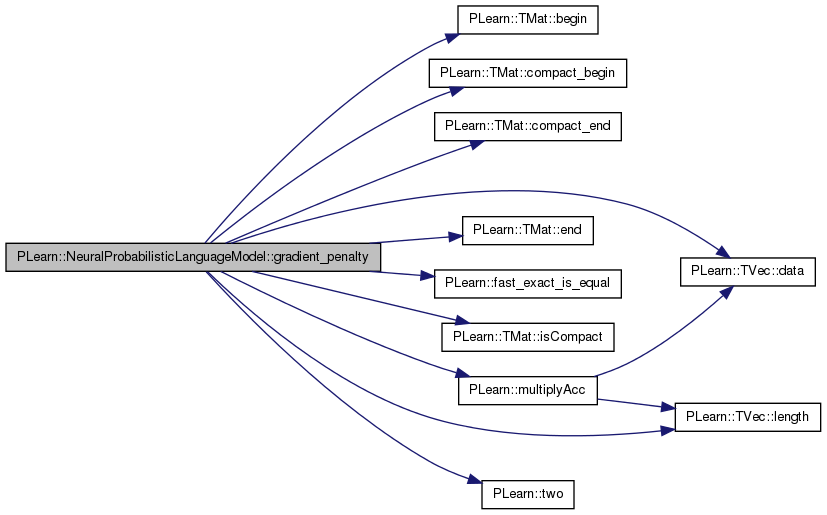
| void PLearn::NeuralProbabilisticLanguageModel::gradient_transfer_func | ( | Vec & | output, |
| Vec & | gradient_input, | ||
| Vec & | gradient_output, | ||
| string | transfer_func = "default", |
||
| int | nll_softmax_speed_up_target = -1 |
||
| ) | [protected] |
Computes the gradient through the given activation function, the output value and the initial gradient on that output (i.e.
before the activation function). After calling this function, gradient_act_output corresponds the gradient after the activation function. nll_softmax_speed_up_target is to speed up the gradient computation for the output layer using the softmax transfert function and the NLL cost function is applied.
Definition at line 1113 of file NeuralProbabilisticLanguageModel.cc.
References PLearn::TVec< T >::data(), grad, hidden_transfer_func, i, PLearn::TVec< T >::length(), ni, nk, PLERROR, pval1, pval2, pval3, PLearn::square(), and val.
Referenced by bprop(), and importance_sampling_gradient_update().
{
if (transfer_func == "default")
transfer_func = hidden_transfer_func;
if(transfer_func=="linear")
{
pval1 = gradient_output.data();
pval2 = gradient_input.data();
ni = output.length();
for(int i=0; i<ni; i++)
*pval2++ += *pval1++;
return;
}
else if(transfer_func=="tanh")
{
pval1 = gradient_output.data();
pval2 = output.data();
pval3 = gradient_input.data();
ni = output.length();
for(int i=0; i<ni; i++)
*pval3++ += (*pval1++)*(1.0-square(*pval2++));
return;
}
else if(transfer_func=="sigmoid")
{
pval1 = gradient_output.data();
pval2 = output.data();
pval3 = gradient_input.data();
ni = output.length();
for(int i=0; i<ni; i++)
{
*pval3++ += (*pval1++)*(*pval2)*(1.0-*pval2);
pval2++;
}
return;
}
else if(transfer_func=="softmax")
{
if(nll_softmax_speed_up_target<0)
{
pval3 = gradient_input.data();
ni = nk = output.length();
for(int i=0; i<ni; i++)
{
val = output[i];
pval1 = gradient_output.data();
pval2 = output.data();
for(int k=0; k<nk; k++)
if(k!=i)
*pval3 -= *pval1++ * val * (*pval2++);
else
{
*pval3 += *pval1++ * val * (1.0-val);
pval2++;
}
pval3++;
}
}
else // Permits speedup and avoids numerical precision errors
{
pval2 = output.data();
pval3 = gradient_input.data();
ni = output.length();
grad = gradient_output[nll_softmax_speed_up_target];
val = output[nll_softmax_speed_up_target];
for(int i=0; i<ni; i++)
{
if(nll_softmax_speed_up_target!=i)
//*pval3++ -= grad * val * (*pval2++);
*pval3++ -= grad * (*pval2++);
else
{
//*pval3++ += grad * val * (1.0-val);
*pval3++ += grad * (1.0-val);
pval2++;
}
}
}
return;
}
else PLERROR("In NeuralProbabilisticLanguageModel::gradient_transfer_func():"
"Unknown value for transfer_func: %s",transfer_func.c_str());
}


| void PLearn::NeuralProbabilisticLanguageModel::importance_sampling_gradient_update | ( | Vec & | inputv, |
| Vec & | targetv, | ||
| real | learning_rate, | ||
| int | n_samples, | ||
| real | train_sample_weight = 1 |
||
| ) | [protected] |
Update the neural network parameters using the importance sampling estimate of the gradient, based on n_samples of the proposal distribution.
Definition at line 1909 of file NeuralProbabilisticLanguageModel.cc.
References b1, b2, bias_decay, bout, bout_dist_rep, clearProppathGradient(), PLearn::TVec< T >::data(), densities, direct_bout, direct_in_to_out, direct_in_to_out_weight_decay, direct_wout, dist_rep_dim, PLearn::exp(), feat_input, feats, fpropBeforeOutputWeights(), generated_samples, getNegativeEnergyValues(), gradient_act_hidden2v, gradient_act_hiddenv, gradient_affine_transform(), gradient_b1, gradient_b2, gradient_bout, gradient_bout_dist_rep, gradient_direct_bout, gradient_direct_wout, gradient_feat_input, gradient_hidden2v, gradient_hiddenv, gradient_last_layer, gradient_nnet_input, gradient_transfer_func(), gradient_w1, gradient_w2, gradient_wout, gradient_wout_dist_rep, hidden2v, hiddenv, i, ifeats, importance_sampling_ratios, PLearn::PLearner::inputsize_, j, layer1_bias_decay, layer1_weight_decay, layer2_bias_decay, layer2_weight_decay, PLearn::TVec< T >::length(), n_feat_sets, neg_energies, nfeats, nhidden, nhidden2, nnet_input, output_layer_bias_decay, output_layer_dist_rep_bias_decay, output_layer_dist_rep_weight_decay, output_layer_weight_decay, proposal_distribution, pval1, pval2, pval3, PLearn::TVec< T >::resize(), sample, stochastic_gradient_descent_speedup, PLearn::TVec< T >::subVec(), PLearn::sum(), update(), w1, w2, weight_decay, wout, and wout_dist_rep.
Referenced by train().
{
// TODO: implement NGramDistribution::generate()
// adjust deepcopy(...)
// Do forward propagation that is common to all computations
fpropBeforeOutputWeights(inputv);
// Generate the n_samples samples from proposal_distribution
generated_samples.resize(n_samples+1);
densities.resize(n_samples);
proposal_distribution->setPredictor(inputv);
pval1 = generated_samples.data();
pval2 = sample.data();
pval3 = densities.data();
for(int i=0; i<n_samples; i++)
{
proposal_distribution->generate(sample);
*pval1++ = *pval2;
*pval3++ = proposal_distribution->density(sample);
}
real sum = 0;
generated_samples[n_samples] = targetv[0];
neg_energies.resize(n_samples+1);
getNegativeEnergyValues(generated_samples, neg_energies);
importance_sampling_ratios.resize(
importance_sampling_ratios.length() + n_samples);
pval1 = importance_sampling_ratios.subVec(
importance_sampling_ratios.length() - n_samples).data();
pval2 = neg_energies.data();
pval3 = densities.data();
for(int i=0; i<n_samples; i++)
{
*pval1 = exp(*pval2++)/ (*pval3++);
sum += *pval1;
}
// Compute importance sampling estimate of the gradient
// Training sample contribution...
gradient_last_layer.resize(1);
gradient_last_layer[0] = learning_rate*train_sample_weight;
if(nhidden2 > 0) {
gradient_affine_transform(hidden2v, wout, bout, gradient_hidden2v,
gradient_wout, gradient_bout,
gradient_last_layer,
false, true, learning_rate*train_sample_weight,
weight_decay+output_layer_weight_decay,
bias_decay+output_layer_bias_decay,
generated_samples.subVec(n_samples,1));
}
else if(nhidden > 0)
{
gradient_affine_transform(hiddenv, wout, bout, gradient_hiddenv,
gradient_wout, gradient_bout,
gradient_last_layer,
false, true, learning_rate*train_sample_weight,
weight_decay+output_layer_weight_decay,
bias_decay+output_layer_bias_decay,
generated_samples.subVec(n_samples,1));
}
else
{
gradient_affine_transform(nnet_input, wout, bout, gradient_nnet_input,
gradient_wout, gradient_bout,
gradient_last_layer,
(dist_rep_dim <= 0), true,
learning_rate*train_sample_weight,
weight_decay+output_layer_weight_decay,
bias_decay+output_layer_bias_decay,
generated_samples.subVec(n_samples,1));
}
if(nhidden>0 && direct_in_to_out)
{
gradient_affine_transform(nnet_input, direct_wout, direct_bout,
gradient_nnet_input,
gradient_direct_wout, gradient_direct_bout,
gradient_last_layer,
dist_rep_dim<=0, true,
learning_rate*train_sample_weight,
weight_decay+direct_in_to_out_weight_decay,
0,
generated_samples.subVec(n_samples,1));
}
// Importance sampling contributions
for(int i=0; i<n_samples; i++)
{
gradient_last_layer.resize(1);
gradient_last_layer[0] = -learning_rate*train_sample_weight*
importance_sampling_ratios[i]/sum;
if(nhidden2 > 0) {
gradient_affine_transform(hidden2v, wout, bout, gradient_hidden2v,
gradient_wout, gradient_bout,
gradient_last_layer,
false, true,
learning_rate*train_sample_weight,
weight_decay+output_layer_weight_decay,
bias_decay+output_layer_bias_decay,
generated_samples.subVec(i,1));
}
else if(nhidden > 0)
{
gradient_affine_transform(hiddenv, wout, bout, gradient_hiddenv,
gradient_wout, gradient_bout,
gradient_last_layer,
false, true,
learning_rate*train_sample_weight,
weight_decay+output_layer_weight_decay,
bias_decay+output_layer_bias_decay,
generated_samples.subVec(i,1));
}
else
{
gradient_affine_transform(nnet_input, wout, bout,
gradient_nnet_input,
gradient_wout, gradient_bout,
gradient_last_layer,
(dist_rep_dim <= 0), true,
learning_rate*train_sample_weight,
weight_decay+output_layer_weight_decay,
bias_decay+output_layer_bias_decay,
generated_samples.subVec(i,1));
}
if(nhidden>0 && direct_in_to_out)
{
gradient_affine_transform(nnet_input, direct_wout, direct_bout,
gradient_nnet_input,
gradient_direct_wout, gradient_direct_bout,
gradient_last_layer,
dist_rep_dim<=0, true,
learning_rate*train_sample_weight,
weight_decay+direct_in_to_out_weight_decay,
0,
generated_samples.subVec(i,1));
}
}
// Propagate all contributions through rest of the network
if(nhidden2 > 0)
{
gradient_transfer_func(hidden2v,gradient_act_hidden2v,gradient_hidden2v);
gradient_affine_transform(hiddenv, w2, b2, gradient_hiddenv,
gradient_w2, gradient_b2, gradient_act_hidden2v,
false, false,learning_rate*train_sample_weight,
weight_decay+layer2_weight_decay,
bias_decay+layer2_bias_decay);
}
if(nhidden > 0)
{
gradient_transfer_func(hiddenv,gradient_act_hiddenv,gradient_hiddenv);
gradient_affine_transform(nnet_input, w1, b1, gradient_nnet_input,
gradient_w1, gradient_b1, gradient_act_hiddenv,
dist_rep_dim<=0, false,learning_rate*train_sample_weight,
weight_decay+layer1_weight_decay,
bias_decay+layer1_bias_decay);
}
if(dist_rep_dim > 0)
{
nfeats = 0;
id = 0;
for(int i=0; i<inputsize_; )
{
ifeats = 0;
for(int j=0; j<n_feat_sets; j++,i++)
ifeats += feats[i].length();
gradient_affine_transform(feat_input.subVec(nfeats,ifeats),
wout_dist_rep, bout_dist_rep,
gradient_feat_input,// Useless anyways...
gradient_wout_dist_rep,
gradient_bout_dist_rep,
gradient_nnet_input.subVec(
id*dist_rep_dim,dist_rep_dim),
true, false,
learning_rate*train_sample_weight,
weight_decay+
output_layer_dist_rep_weight_decay,
bias_decay
+output_layer_dist_rep_bias_decay);
nfeats += ifeats;
id++;
}
}
clearProppathGradient();
// Update parameters and clear gradient
if(!stochastic_gradient_descent_speedup)
update();
}
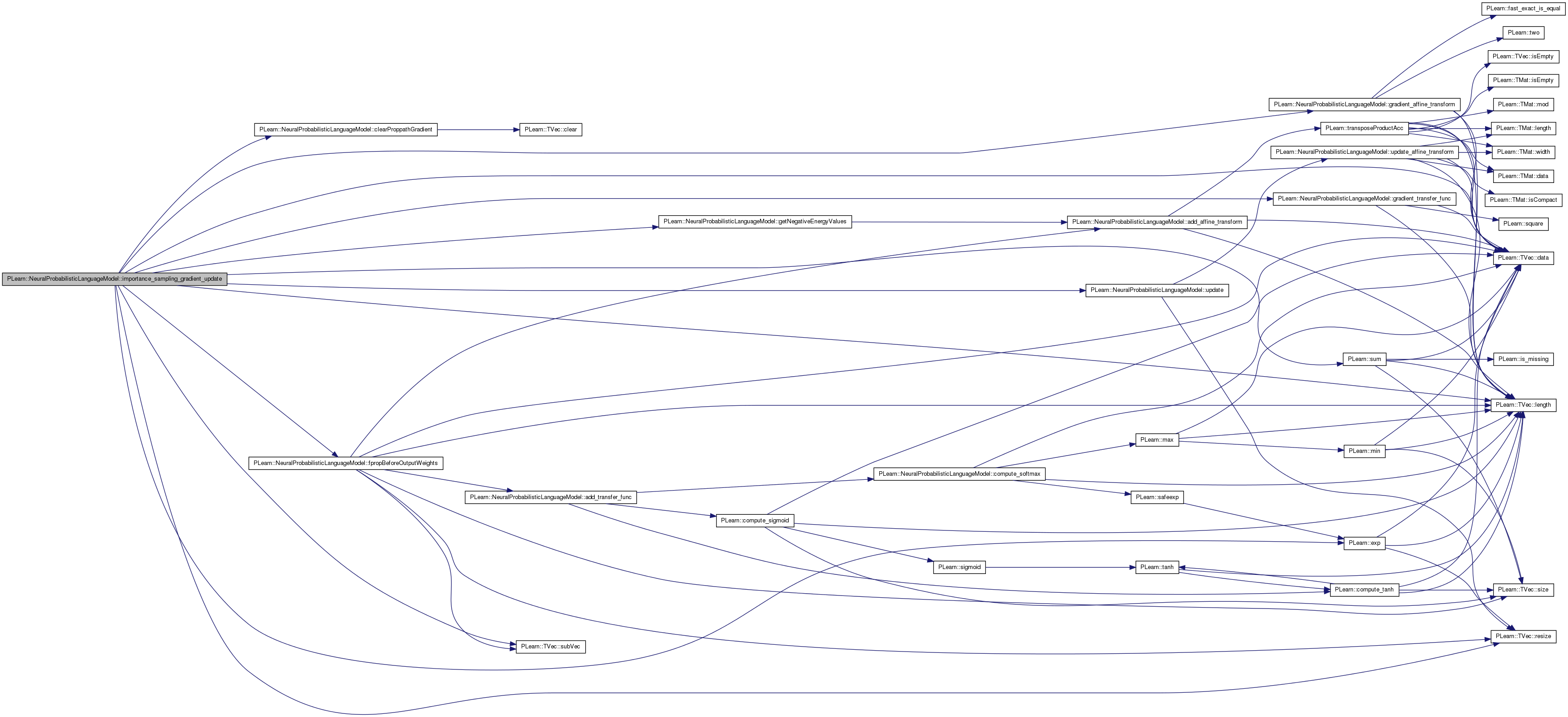

| void PLearn::NeuralProbabilisticLanguageModel::initializeParams | ( | bool | set_seed = true | ) | [protected, virtual] |
Initialize the parameters.
If 'set_seed' is set to false, the seed will not be set in this method (it will be assumed to be already initialized according to the 'seed' option). The index of the extra task (-1 if main task) also needs to be provided.
Definition at line 2180 of file NeuralProbabilisticLanguageModel.cc.
References b1, b2, bout, bout_dist_rep, PLearn::TMat< T >::clear(), PLearn::TVec< T >::clear(), direct_bout, direct_in_to_out, direct_wout, dist_rep_dim, feat_input, feat_sets, fillWeights(), fixed_output_weights, gradient_act_hidden2v, gradient_act_hiddenv, gradient_act_outputv, gradient_b1, gradient_b2, gradient_bout, gradient_bout_dist_rep, gradient_direct_bout, gradient_direct_wout, gradient_hidden2v, gradient_hiddenv, gradient_nnet_input, gradient_outputv, gradient_w1, gradient_w2, gradient_wout, gradient_wout_dist_rep, hidden2v, hiddenv, i, PLearn::PLearner::inputsize_, n_feat_sets, nhidden, nhidden2, nnet_input, PLearn::TMat< T >::resize(), PLearn::TVec< T >::resize(), rgen, PLearn::PLearner::seed_, PLearn::TVec< T >::size(), total_feats_per_token, total_output_size, PLearn::TMat< T >::toVec(), PLearn::PLearner::train_set, w1, w2, wout, and wout_dist_rep.
Referenced by build_().
{
if (set_seed) {
if (seed_>=0)
rgen->manual_seed(seed_);
}
PP<Dictionary> dict = train_set->getDictionary(inputsize_);
total_output_size = dict->size();
total_feats_per_token = 0;
for(int i=0; i<n_feat_sets; i++)
total_feats_per_token += feat_sets[i]->size();
int nnet_inputsize;
if(dist_rep_dim > 0)
{
wout_dist_rep.resize(total_feats_per_token,dist_rep_dim);
bout_dist_rep.resize(dist_rep_dim);
nnet_inputsize = dist_rep_dim*inputsize_/n_feat_sets;
nnet_input.resize(nnet_inputsize);
fillWeights(wout_dist_rep);
bout_dist_rep.clear();
gradient_wout_dist_rep.resize(total_feats_per_token,dist_rep_dim);
gradient_bout_dist_rep.resize(dist_rep_dim);
gradient_nnet_input.resize(nnet_inputsize);
gradient_wout_dist_rep.clear();
gradient_bout_dist_rep.clear();
gradient_nnet_input.clear();
}
else
{
nnet_inputsize = total_feats_per_token*inputsize_/n_feat_sets;
nnet_input = feat_input;
}
if(nhidden>0)
{
w1.resize(nnet_inputsize,nhidden);
b1.resize(nhidden);
hiddenv.resize(nhidden);
fillWeights(w1);
b1.clear();
gradient_w1.resize(nnet_inputsize,nhidden);
gradient_b1.resize(nhidden);
gradient_hiddenv.resize(nhidden);
gradient_act_hiddenv.resize(nhidden);
gradient_w1.clear();
gradient_b1.clear();
gradient_hiddenv.clear();
gradient_act_hiddenv.clear();
if(nhidden2>0)
{
w2.resize(nhidden,nhidden2);
b2.resize(nhidden2);
hidden2v.resize(nhidden2);
wout.resize(nhidden2,total_output_size);
bout.resize(total_output_size);
fillWeights(w2);
b2.clear();
gradient_w2.resize(nhidden,nhidden2);
gradient_b2.resize(nhidden2);
gradient_hidden2v.resize(nhidden2);
gradient_act_hidden2v.resize(nhidden2);
gradient_wout.resize(nhidden2,total_output_size);
gradient_bout.resize(total_output_size);
gradient_w2.clear();
gradient_b2.clear();
gradient_hidden2v.clear();
gradient_act_hidden2v.clear();
gradient_wout.clear();
gradient_bout.clear();
}
else
{
wout.resize(nhidden,total_output_size);
bout.resize(total_output_size);
gradient_wout.resize(nhidden,total_output_size);
gradient_bout.resize(total_output_size);
gradient_wout.clear();
gradient_bout.clear();
}
if(direct_in_to_out)
{
direct_wout.resize(nnet_inputsize,total_output_size);
direct_bout.resize(0); // Because it is not used
fillWeights(direct_wout);
gradient_direct_wout.resize(nnet_inputsize,total_output_size);
gradient_direct_wout.clear();
gradient_direct_bout.resize(0); // idem
}
}
else
{
wout.resize(nnet_inputsize,total_output_size);
bout.resize(total_output_size);
gradient_wout.resize(nnet_inputsize,total_output_size);
gradient_bout.resize(total_output_size);
gradient_wout.clear();
gradient_bout.clear();
}
//fillWeights(wout);
if (fixed_output_weights) {
static Vec values;
if (values.size()==0)
{
values.resize(2);
values[0]=-1;
values[1]=1;
}
rgen->fill_random_discrete(wout.toVec(), values);
}
else
fillWeights(wout);
bout.clear();
gradient_outputv.resize(total_output_size);
gradient_act_outputv.resize(total_output_size);
gradient_outputv.clear();
gradient_act_outputv.clear();
}


| void PLearn::NeuralProbabilisticLanguageModel::makeDeepCopyFromShallowCopy | ( | CopiesMap & | copies | ) | [virtual] |
Transforms a shallow copy into a deep copy.
Reimplemented from PLearn::PLearner.
Definition at line 2320 of file NeuralProbabilisticLanguageModel.cc.
References b1, b2, bout, bout_dist_rep, cost_funcs, PLearn::deepCopyField(), densities, direct_bout, direct_wout, feat_input, feat_sets, feats, feats_since_last_update, generated_samples, gradient, gradient_act_hidden2v, gradient_act_hiddenv, gradient_act_outputv, gradient_b1, gradient_b2, gradient_bout, gradient_bout_dist_rep, gradient_direct_bout, gradient_direct_wout, gradient_feat_input, gradient_hidden2v, gradient_hiddenv, gradient_last_layer, gradient_nnet_input, gradient_outputv, gradient_w1, gradient_w2, gradient_wout, gradient_wout_dist_rep, hidden2v, hiddenv, importance_sampling_ratios, last_layer, PLearn::PLearner::makeDeepCopyFromShallowCopy(), neg_energies, nnet_input, output_comp, PLERROR, proposal_distribution, rgen, row, sample, target_values, target_values_reference_set, target_values_since_last_update, val_string_reference_set, w1, w2, wout, and wout_dist_rep.
{
inherited::makeDeepCopyFromShallowCopy(copies);
// Private variables
deepCopyField(target_values,copies);
deepCopyField(output_comp,copies);
deepCopyField(row,copies);
deepCopyField(last_layer,copies);
deepCopyField(gradient_last_layer,copies);
deepCopyField(feats,copies);
deepCopyField(gradient,copies);
deepCopyField(neg_energies,copies);
deepCopyField(densities,copies);
// Protected variables
deepCopyField(feat_input,copies);
deepCopyField(gradient_feat_input,copies);
deepCopyField(nnet_input,copies);
deepCopyField(gradient_nnet_input,copies);
deepCopyField(hiddenv,copies);
deepCopyField(gradient_hiddenv,copies);
deepCopyField(gradient_act_hiddenv,copies);
deepCopyField(hidden2v,copies);
deepCopyField(gradient_hidden2v,copies);
deepCopyField(gradient_act_hidden2v,copies);
deepCopyField(gradient_outputv,copies);
deepCopyField(gradient_act_outputv,copies);
deepCopyField(rgen,copies);
deepCopyField(feats_since_last_update,copies);
deepCopyField(target_values_since_last_update,copies);
deepCopyField(val_string_reference_set,copies);
deepCopyField(target_values_reference_set,copies);
deepCopyField(importance_sampling_ratios,copies);
deepCopyField(sample,copies);
deepCopyField(generated_samples,copies);
// Public variables
deepCopyField(w1,copies);
deepCopyField(gradient_w1,copies);
deepCopyField(b1,copies);
deepCopyField(gradient_b1,copies);
deepCopyField(w2,copies);
deepCopyField(gradient_w2,copies);
deepCopyField(b2,copies);
deepCopyField(gradient_b2,copies);
deepCopyField(wout,copies);
deepCopyField(gradient_wout,copies);
deepCopyField(bout,copies);
deepCopyField(gradient_bout,copies);
deepCopyField(direct_wout,copies);
deepCopyField(gradient_direct_wout,copies);
deepCopyField(direct_bout,copies);
deepCopyField(gradient_direct_bout,copies);
deepCopyField(wout_dist_rep,copies);
deepCopyField(gradient_wout_dist_rep,copies);
deepCopyField(bout_dist_rep,copies);
deepCopyField(gradient_bout_dist_rep,copies);
// Public build options
deepCopyField(cost_funcs,copies);
deepCopyField(feat_sets,copies);
deepCopyField(proposal_distribution,copies);
PLERROR("not up to date");
}

| int PLearn::NeuralProbabilisticLanguageModel::my_argmax | ( | const Vec & | vec, |
| int | default_compare = 0 |
||
| ) | const [private] |
Argmax function that lets you define the default (first) component used for comparisons.
This is useful to avoid bias in the prediction when the getValues() provides some information about the prior distribution of the targets (e.g. the first target given by getValues() is the most likely) and the output of the model is the same for all targets.
Definition at line 974 of file NeuralProbabilisticLanguageModel.cc.
References PLearn::TVec< T >::data(), i, PLearn::TVec< T >::length(), and PLERROR.
Referenced by computeOutput().
{
#ifdef BOUNDCHECK
if(vec.length()==0)
PLERROR("IN int argmax(const TVec<T>& vec) vec has zero length");
#endif
real* v = vec.data();
int indexmax = default_compare;
real maxval = v[default_compare];
for(int i=0; i<vec.length(); i++)
if(v[i]>maxval)
{
maxval = v[i];
indexmax = i;
}
return indexmax;
}


| real PLearn::NeuralProbabilisticLanguageModel::nll | ( | const Vec & | outputv, |
| int | target | ||
| ) | const [private] |
Negative log-likelihood loss.
Definition at line 2169 of file NeuralProbabilisticLanguageModel.cc.
References PLearn::safeflog().
Referenced by fpropCostsFromOutput().
{
return -safeflog(outputv[target]);
}


| void PLearn::NeuralProbabilisticLanguageModel::output_gradient_verification | ( | Vec | grad, |
| Vec | est_grad | ||
| ) | [protected] |
Definition at line 3046 of file NeuralProbabilisticLanguageModel.cc.
References PLearn::apply(), PLearn::argmax(), PLearn::dot(), PLearn::endl(), PLearn::FABS(), PLearn::fast_exact_is_equal(), i, PLearn::is_missing(), PLearn::TVec< T >::length(), PLearn::max(), MISSING_VALUE, and PLearn::norm().
Referenced by verify_gradient().
{
// Inspired from Func::verifyGradient()
Vec num = apply(grad - est_grad,(tRealFunc)FABS);
Vec denom = real(0.5)*apply(grad + est_grad,(tRealFunc)FABS);
for (int i = 0; i < num.length(); i++)
{
if (!fast_exact_is_equal(num[i], 0))
num[i] /= denom[i];
else
if(!fast_exact_is_equal(denom[i],0))
cout << "at position " << i << " num[i] == 0 but denom[i] = "
<< denom[i] << endl;
}
int pos = argmax(num);
cout << max(num) << " (at position " << pos << "/" << num.length()
<< ", computed = " << grad[pos] << " and estimated = "
<< est_grad[pos] << ")" << endl;
real norm_grad = norm(grad);
real norm_est_grad = norm(est_grad);
real cos_angle = fast_exact_is_equal(norm_grad*norm_est_grad,
0)
? MISSING_VALUE
: dot(grad,est_grad) /
(norm_grad*norm_est_grad);
if (cos_angle > 1)
cos_angle = 1; // Numerical imprecisions can lead to such situation.
cout << "grad.length() = " << grad.length() << endl;
cout << "cos(angle) : " << cos_angle << endl;
cout << "angle : " << ( is_missing(cos_angle) ? MISSING_VALUE
: acos(cos_angle) ) << endl;
}
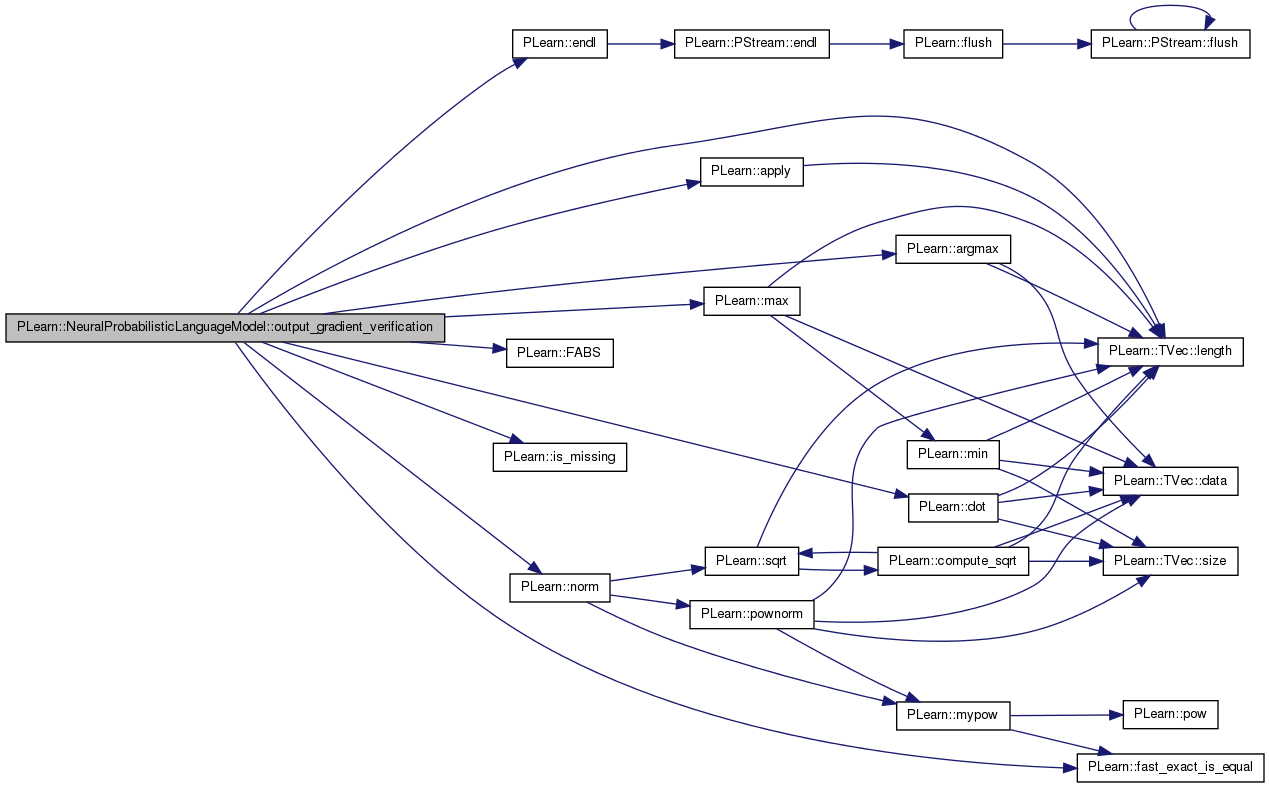

| int PLearn::NeuralProbabilisticLanguageModel::outputsize | ( | ) | const [virtual] |
SUBCLASS WRITING: override this so that it returns the size of this learner's output, as a function of its inputsize(), targetsize() and set options.
Implements PLearn::PLearner.
Definition at line 2390 of file NeuralProbabilisticLanguageModel.cc.
References PLearn::PLearner::targetsize_.
{
return targetsize_;
}
| VMat PLearn::NeuralProbabilisticLanguageModel::processDataSet | ( | VMat | dataset | ) | const [protected, virtual] |
Changes the reference_set and then calls the parent's class method.
Reimplemented from PLearn::PLearner.
Definition at line 3116 of file NeuralProbabilisticLanguageModel.cc.
References PLearn::PLearner::processDataSet(), target_values_reference_set, PLearn::PLearner::train_set, val_string_reference_set, and PLearn::VMat::width().
{
VMat ret;
val_string_reference_set = dataset;
// Assumes it contains the target part information
if(dataset->width() > train_set->inputsize())
target_values_reference_set = dataset;
ret = inherited::processDataSet(dataset);
val_string_reference_set = train_set;
if(dataset->width() > train_set->inputsize())
target_values_reference_set = train_set;
return ret;
}

| void PLearn::NeuralProbabilisticLanguageModel::test | ( | VMat | testset, |
| PP< VecStatsCollector > | test_stats, | ||
| VMat | testoutputs = 0, |
||
| VMat | testcosts = 0 |
||
| ) | const [protected, virtual] |
Changes the reference_set and then calls the parent's class method.
Reimplemented from PLearn::PLearner.
Definition at line 3105 of file NeuralProbabilisticLanguageModel.cc.
References target_values_reference_set, PLearn::PLearner::test(), PLearn::PLearner::train_set, and val_string_reference_set.
{
val_string_reference_set = testset;
target_values_reference_set = testset;
inherited::test(testset,test_stats,testoutputs,testcosts);
val_string_reference_set = train_set;
target_values_reference_set = train_set;
}
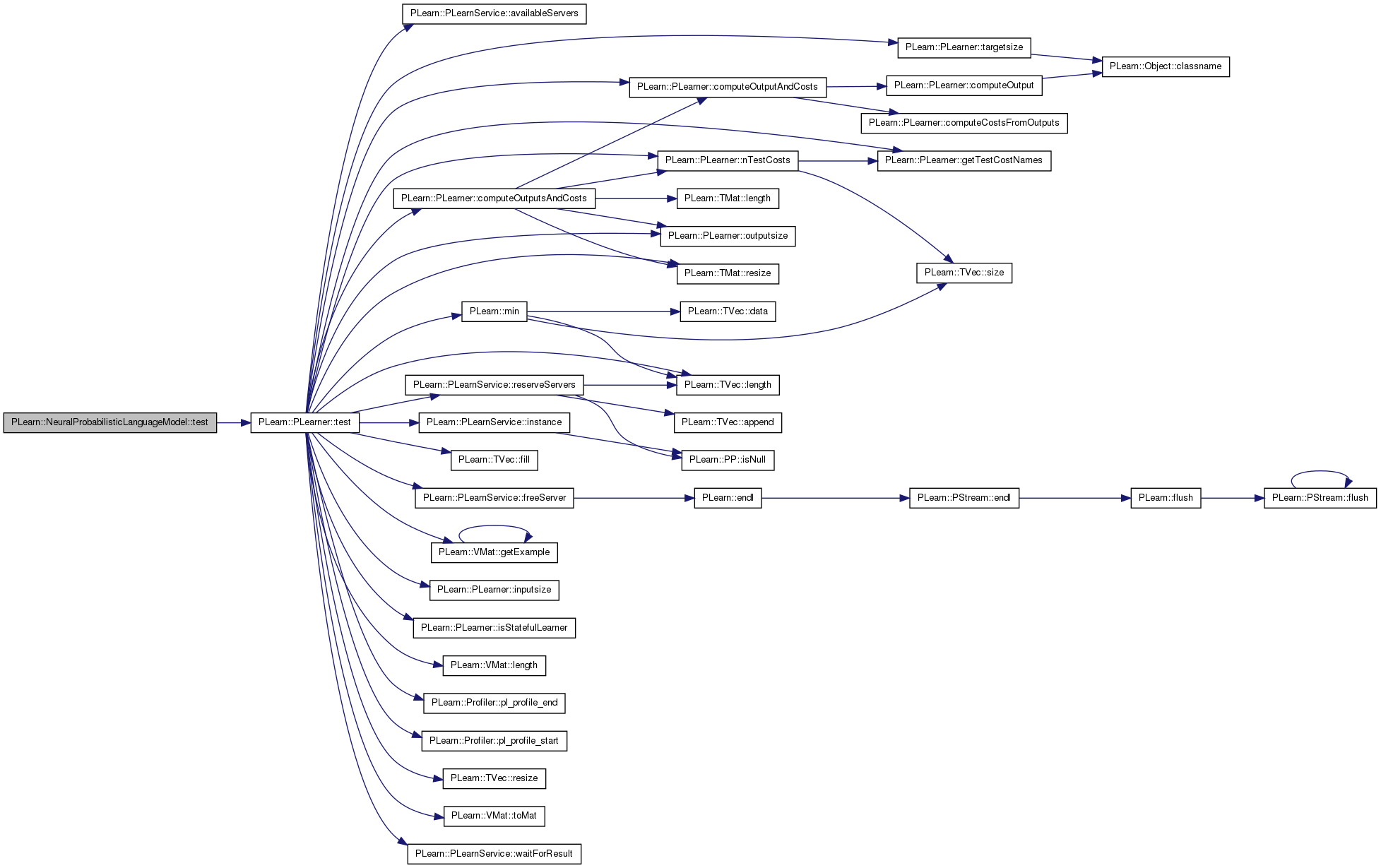
| void PLearn::NeuralProbabilisticLanguageModel::train | ( | ) | [virtual] |
*** SUBCLASS WRITING: ***
The role of the train method is to bring the learner up to stage==nstages, updating the stats with training costs measured on-line in the process.
TYPICAL CODE:
static Vec input; // static so we don't reallocate/deallocate memory each time... static Vec target; // (but be careful that static means shared!) input.resize(inputsize()); // the train_set's inputsize() target.resize(targetsize()); // the train_set's targetsize() real weight; if(!train_stats) // make a default stats collector, in case there's none train_stats = new VecStatsCollector(); if(nstages<stage) // asking to revert to a previous stage! forget(); // reset the learner to stage=0 while(stage<nstages) { // clear statistics of previous epoch train_stats->forget(); //... train for 1 stage, and update train_stats, // using train_set->getSample(input, target, weight); // and train_stats->update(train_costs) ++stage; train_stats->finalize(); // finalize statistics for this epoch }
Implements PLearn::PLearner.
Definition at line 2397 of file NeuralProbabilisticLanguageModel.cc.
References b1, b2, batch_size, bout, bout_dist_rep, bprop(), classname(), PLearn::TVec< T >::data(), decrease_constant, direct_in_to_out, direct_wout, dist_rep_dim, PLearn::endl(), fprop(), PLearn::VMat::getExample(), getTrainCostNames(), gradient_b1, gradient_b2, gradient_bout, gradient_bout_dist_rep, gradient_direct_wout, gradient_last_layer, gradient_w1, gradient_w2, gradient_wout, gradient_wout_dist_rep, i, importance_sampling_gradient_update(), importance_sampling_ratios, PLearn::VMat::length(), minimum_effective_sample_size, nhidden, nhidden2, PLearn::PLearner::nstages, PLERROR, pval1, PLearn::PLearner::report_progress, PLearn::TVec< T >::resize(), sampling_block_size, PLearn::PLearner::stage, start_learning_rate, stochastic_gradient_descent_speedup, PLearn::TVec< T >::subVec(), PLearn::tostring(), total_output_size, total_updates, PLearn::PLearner::train_set, PLearn::PLearner::train_stats, update(), PLearn::PLearner::verbosity, w1, w2, wout, and wout_dist_rep.
{
//Profiler::activate();
if(!train_set)
PLERROR("In NeuralProbabilisticLanguageModel::train, "
"you did not setTrainingSet");
if(!train_stats)
PLERROR("In NeuralProbabilisticLanguageModel::train, "
"you did not setTrainStatsCollector");
Vec outputv(total_output_size);
Vec costsv(getTrainCostNames().length());
Vec inputv(train_set->inputsize());
Vec targetv(train_set->targetsize());
real sample_weight = 1;
int l = train_set->length();
int bs = batch_size>0 ? batch_size : l;
// Importance sampling speedup variables
// Effective sample size statistics
real effective_sample_size_sum = 0;
real effective_sample_size_square_sum = 0;
real importance_sampling_ratio_k = 0;
// Current true sample size;
int n_samples = 0;
real
PP<ProgressBar> pb;
if(report_progress)
pb = new ProgressBar("Training " + classname() + " from stage "
+ tostring(stage) + " to "
+ tostring(nstages), nstages-stage);
//if(stage == 0)
//{
// for(int t=0; t<l;t++)
// {
// cout << "t=" << t << " ";
// train_set->getExample(t,inputv,targetv,sample_weight);
// row.subVec(0,inputsize_) << inputv;
// train_set->getValues(row,inputsize_,target_values);
// if(target_values.length() != 1)
// verify_gradient(inputv,targetv,1e-6);
// }
// return;
//}
Mat old_gradient_wout;
Vec old_gradient_bout;
Mat old_gradient_wout_dist_rep;
Vec old_gradient_bout_dist_rep;
Mat old_gradient_w1;
Vec old_gradient_b1;
Mat old_gradient_w2;
Vec old_gradient_b2;
Mat old_gradient_direct_wout;
if(stochastic_gradient_descent_speedup)
{
// Trick to make stochastic gradient descent faster
old_gradient_wout = gradient_wout;
old_gradient_bout = gradient_bout;
gradient_wout = wout;
gradient_bout = bout;
if(dist_rep_dim > 0)
{
old_gradient_wout_dist_rep = gradient_wout_dist_rep;
old_gradient_bout_dist_rep = gradient_bout_dist_rep;
gradient_wout_dist_rep = wout_dist_rep;
gradient_bout_dist_rep = bout_dist_rep;
}
if(nhidden>0)
{
old_gradient_w1 = gradient_w1;
old_gradient_b1 = gradient_b1;
gradient_w1 = w1;
gradient_b1 = b1;
if(nhidden2>0)
{
old_gradient_w2 = gradient_w2;
old_gradient_b2 = gradient_b2;
gradient_w2 = w2;
gradient_b2 = b2;
}
if(direct_in_to_out)
{
old_gradient_direct_wout = gradient_direct_wout;
gradient_direct_wout = direct_wout;
}
}
}
int initial_stage = stage;
while(stage<nstages)
{
for(int t=0; t<l;)
{
//if(t%1000 == 0)
//{
// cout << "Time: " << clock()/CLOCKS_PER_SEC << " seconds." << endl;
//}
for(int i=0; i<bs; i++)
{
//if(t == 71705)
// cout << "It's going to fuck !!!" << endl;
//if(t == 71704)
// cout << "It's going to fuck !!!" << endl;
train_set->getExample(t%l,inputv,targetv,sample_weight);
if(proposal_distributions)
{
n_samples = 0;
importance_sampling_ratios.resize(0);
effective_sample_size_sum = 0;
effective_sample_size_square_sum = 0;
while(effective_sample_size < minimum_effective_sample_size)
{
if(n_samples >= total_output_size)
{
gradient_last_layer.resize(total_output_size);
fprop(inputv,outputv,targetv,costsv,sample_weight);
bprop(inputv,outputv,targetv,costsv,
start_learning_rate/
(bs*(1.0+decrease_constant*total_updates)),
sample_weight);
train_stats->update(costsv);
break;
}
importance_sampling_gradient_update(
inputv,targetv,
start_learning_rate/
(bs*(1.0+decrease_constant*total_updates)),
sampling_block_size,
sampleweight
);
// Update effective sample size
pval1 = importance_sampling_ratios.subVec(
nsamples,sampling_block_size).data();
for(int k=0; k<sampling_block_size; k++)
{
effective_sample_size_sum += *pval1;
effective_sample_size_square_sum += *pval1 * (*pval1);
pval1++;
}
effective_sample_size =
(effective_sample_size_sum*effective_sample_size_sum)/
effective_sample_size_square_sum;
n_samples += sampling_block_size;
}
}
else
{
//Profiler::start("fprop()");
fprop(inputv,outputv,targetv,costsv,sample_weight);
//Profiler::end("fprop()");
//Profiler::start("bprop()");
bprop(inputv,outputv,targetv,costsv,
start_learning_rate/
(bs*(1.0+decrease_constant*total_updates)),
sample_weight);
//Profiler::end("bprop()");
train_stats->update(costsv);
}
t++;
}
// Update
if(!stochastic_gradient_descent_speedup)
update();
total_updates++;
}
train_stats->finalize();
++stage;
if(verbosity>2)
cout << "Epoch " << stage << " train objective: "
<< train_stats->getMean() << endl;
if(pb) pb->update(stage-initial_stage);
}
if(stochastic_gradient_descent_speedup)
{
// Trick to make stochastic gradient descent faster
gradient_wout = old_gradient_wout;
gradient_bout = old_gradient_bout;
if(dist_rep_dim > 0)
{
gradient_wout_dist_rep = old_gradient_wout_dist_rep;
gradient_bout_dist_rep = old_gradient_bout_dist_rep;
}
if(nhidden>0)
{
gradient_w1 = old_gradient_w1;
gradient_b1 = old_gradient_b1;
if(nhidden2>0)
{
gradient_w2 = old_gradient_w2;
gradient_b2 = old_gradient_b2;
}
if(direct_in_to_out)
{
gradient_direct_wout = old_gradient_direct_wout;
}
}
}
//Profiler::report(cout);
}
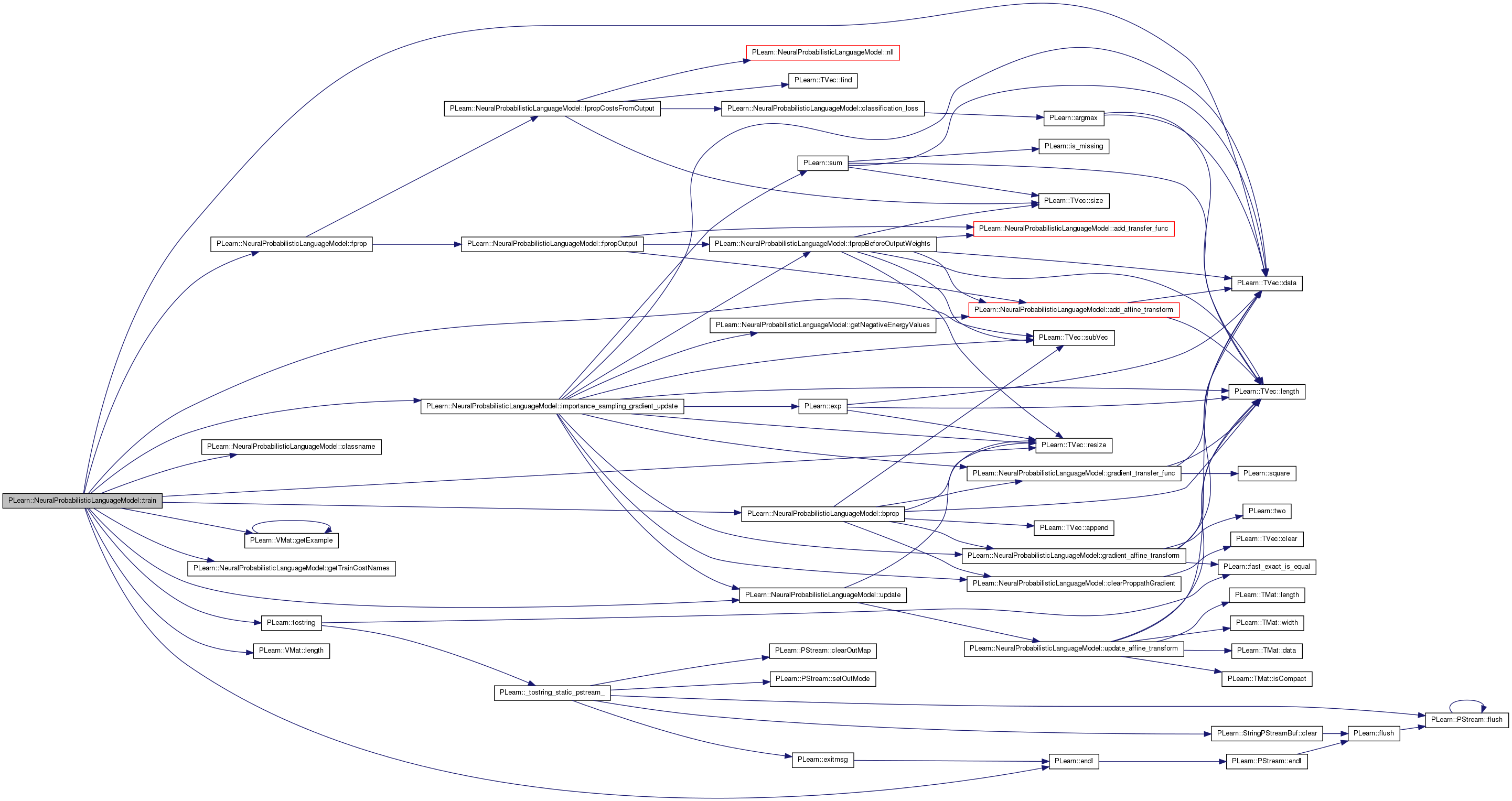
| void PLearn::NeuralProbabilisticLanguageModel::update | ( | ) | [protected] |
Update network's parameters.
Definition at line 775 of file NeuralProbabilisticLanguageModel.cc.
References b1, b2, bout, bout_dist_rep, direct_bout, direct_in_to_out, direct_wout, dist_rep_dim, feats_since_last_update, gradient_b1, gradient_b2, gradient_bout, gradient_bout_dist_rep, gradient_direct_bout, gradient_direct_wout, gradient_w1, gradient_w2, gradient_wout, gradient_wout_dist_rep, nhidden, nhidden2, possible_targets_vary, PLearn::TVec< T >::resize(), target_values_since_last_update, update_affine_transform(), w1, w2, wout, and wout_dist_rep.
Referenced by importance_sampling_gradient_update(), and train().
{
if(dist_rep_dim > 0)
{
update_affine_transform(feats_since_last_update, wout_dist_rep,
bout_dist_rep, gradient_wout_dist_rep,
gradient_bout_dist_rep, true, false,
target_values_since_last_update);
}
if(nhidden>0)
{
update_affine_transform(feats_since_last_update, w1, b1,
gradient_w1, gradient_b1,
dist_rep_dim<=0, false,
target_values_since_last_update);
if(nhidden2>0)
{
update_affine_transform(feats_since_last_update, w2, b2,
gradient_w2, gradient_b2,
false, false,
target_values_since_last_update);
}
update_affine_transform(feats_since_last_update, wout, bout,
gradient_wout, gradient_bout,
false, possible_targets_vary,
target_values_since_last_update);
if(direct_in_to_out)
{
update_affine_transform(feats_since_last_update, direct_wout,
direct_bout,
gradient_direct_wout, gradient_direct_bout,
false, possible_targets_vary,
target_values_since_last_update);
}
}
else
{
update_affine_transform(feats_since_last_update, wout, bout,
gradient_wout, gradient_bout,
dist_rep_dim<=0, possible_targets_vary,
target_values_since_last_update);
}
feats_since_last_update.resize(0);
target_values_since_last_update.resize(0);
}


| void PLearn::NeuralProbabilisticLanguageModel::update_affine_transform | ( | Vec | input, |
| Mat | weights, | ||
| Vec | bias, | ||
| Mat | gweights, | ||
| Vec | gbias, | ||
| bool | input_is_sparse, | ||
| bool | output_is_sparse, | ||
| Vec | output_indices | ||
| ) | [protected] |
Update affine transformation's parameters.
Definition at line 825 of file NeuralProbabilisticLanguageModel.cc.
References PLearn::TMat< T >::data(), PLearn::TVec< T >::data(), i, PLearn::TMat< T >::isCompact(), j, PLearn::TMat< T >::length(), PLearn::TVec< T >::length(), ni, nj, PLERROR, pval1, pval2, pval3, and PLearn::TMat< T >::width().
Referenced by update().
{
// Bias
if(bias.length() != 0)
{
if(output_is_sparse)
{
pval1 = gbias.data();
pval2 = bias.data();
pval3 = output_indices.data();
ni = output_indices.length();
for(int i=0; i<ni; i++)
{
pval2[(int)*pval3] += pval1[(int)*pval3];
pval1[(int)*pval3] = 0;
pval3++;
}
}
else
{
pval1 = gbias.data();
pval2 = bias.data();
ni = bias.length();
for(int i=0; i<ni; i++)
{
*pval2 += *pval1;
*pval1 = 0;
pval1++;
pval2++;
}
}
}
// Weights
if(!input_is_sparse && !output_is_sparse)
{
if(!gweights.isCompact() || !weights.isCompact())
PLERROR("In NeuralProbabilisticLanguageModel::"
"update_affine_transform(): weights or gweights is"
"not a compact TMat");
ni = weights.length();
nj = weights.width();
pval1 = gweights.data();
pval2 = weights.data();
for(int i=0; i<ni; i++)
for(int j=0; j<nj; j++)
{
*pval2 += *pval1;
*pval1 = 0;
pval1++;
pval2++;
}
}
else if(!input_is_sparse && output_is_sparse)
{
ni = output_indices.length();
nj = input.length();
pval3 = output_indices.data();
for(int i=0; i<ni; i++)
{
for(int j=0; j<nj; j++)
{
weights(j,(int)*pval3) += gweights(j,(int)*pval3);
gweights(j,(int)*pval3) = 0;
}
pval3++;
}
}
else if(input_is_sparse && !output_is_sparse)
{
ni = input.length();
nj = weights.width();
pval3 = input.data();
for(int i=0; i<ni; i++)
{
pval1 = gweights[(int)(*pval3)];
pval2 = weights[(int)(*pval3++)];
for(int j=0; j<nj;j++)
{
*pval2 += *pval1;
*pval1 = 0;
pval1++;
pval2++;
}
}
}
else if(input_is_sparse && output_is_sparse)
{
// Weights
ni = input.length();
nj = output_indices.length();
pval2 = input.data();
for(int i=0; i<ni; i++)
{
pval3 = output_indices.data();
for(int j=0; j<nj; j++)
{
weights((int)(*pval2),(int)*pval3) +=
gweights((int)(*pval2),(int)*pval3);
gweights((int)(*pval2),(int)*pval3) = 0;
pval3++;
}
pval2++;
}
}
}
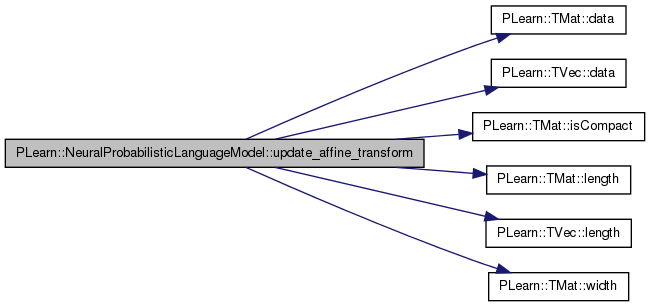

| void PLearn::NeuralProbabilisticLanguageModel::use | ( | VMat | testset, |
| VMat | outputs | ||
| ) | const [protected, virtual] |
Changes the reference_set and then calls the parent's class method.
Reimplemented from PLearn::PLearner.
Definition at line 3093 of file NeuralProbabilisticLanguageModel.cc.
References target_values_reference_set, PLearn::PLearner::train_set, PLearn::PLearner::use(), val_string_reference_set, and PLearn::VMat::width().
{
val_string_reference_set = testset;
if(testset->width() > train_set->inputsize())
target_values_reference_set = testset;
target_values_reference_set = testset;
inherited::use(testset,outputs);
val_string_reference_set = train_set;
if(testset->width() > train_set->inputsize())
target_values_reference_set = train_set;
}
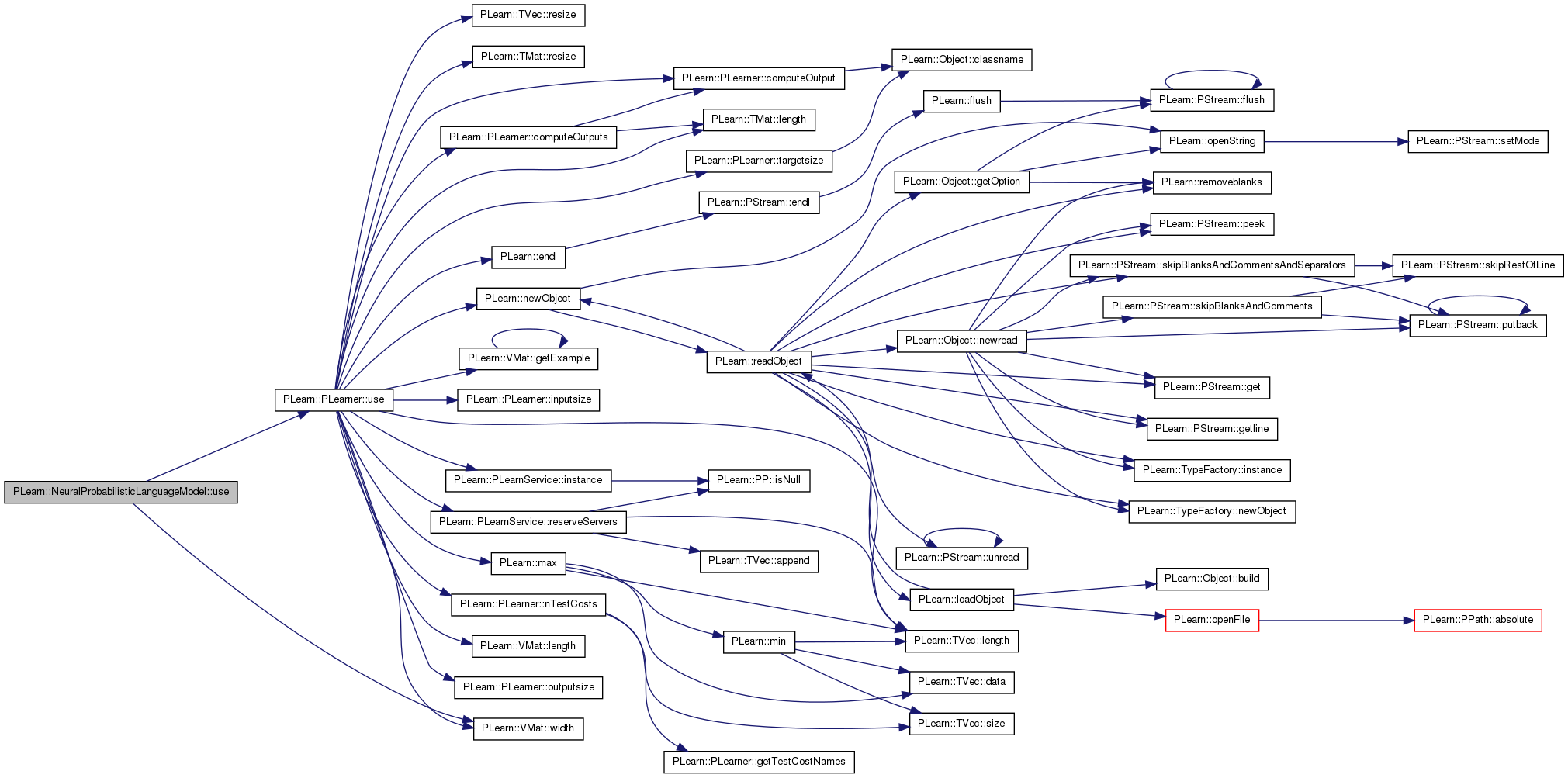
| void PLearn::NeuralProbabilisticLanguageModel::verify_gradient | ( | Vec & | input, |
| Vec | target, | ||
| real | step | ||
| ) | [protected] |
Verify gradient of propagation path.
Definition at line 2621 of file NeuralProbabilisticLanguageModel.cc.
References b1, b2, bout, bout_dist_rep, bprop(), PLearn::TMat< T >::clear(), PLearn::TVec< T >::clear(), clearProppathGradient(), direct_bout, direct_in_to_out, direct_wout, dist_rep_dim, PLearn::endl(), feat_input, feats, fprop(), getTrainCostNames(), gradient_b1, gradient_b2, gradient_bout, gradient_bout_dist_rep, gradient_direct_bout, gradient_direct_wout, gradient_w1, gradient_w2, gradient_wout, gradient_wout_dist_rep, hidden2v, hiddenv, i, ifeats, PLearn::PLearner::inputsize_, j, last_layer, n_feat_sets, nfeats, nhidden, nhidden2, nnet_input, output_comp, output_gradient_verification(), possible_targets_vary, PLearn::TMat< T >::resize(), PLearn::TVec< T >::resize(), PLearn::TVec< T >::subVec(), target_values, total_feats_per_token, total_output_size, PLearn::TMat< T >::toVec(), verify_gradient_affine_transform(), w1, w2, wout, and wout_dist_rep.
{
Vec costsv(getTrainCostNames().length());
real sampleweight = 1;
real verify_step = step;
// To avoid the interaction between fprop and this function
int nfeats = 0;
int id = 0;
int ifeats = 0;
Vec est_gradient_bout;
Mat est_gradient_wout;
Vec est_gradient_bout_dist_rep;
Mat est_gradient_wout_dist_rep;
Vec est_gradient_b1;
Mat est_gradient_w1;
Vec est_gradient_b2;
Mat est_gradient_w2;
Vec est_gradient_direct_bout;
Mat est_gradient_direct_wout;
int nnet_inputsize;
if(dist_rep_dim > 0)
{
nnet_inputsize = dist_rep_dim*inputsize_/n_feat_sets;
est_gradient_wout_dist_rep.resize(total_feats_per_token,dist_rep_dim);
est_gradient_bout_dist_rep.resize(dist_rep_dim);
est_gradient_wout_dist_rep.clear();
est_gradient_bout_dist_rep.clear();
gradient_wout_dist_rep.clear();
gradient_bout_dist_rep.clear();
}
else
{
nnet_inputsize = total_feats_per_token*inputsize_/n_feat_sets;
}
if(nhidden>0)
{
est_gradient_w1.resize(nnet_inputsize,nhidden);
est_gradient_b1.resize(nhidden);
est_gradient_w1.clear();
est_gradient_b1.clear();
gradient_w1.clear();
gradient_b1.clear();
if(nhidden2>0)
{
est_gradient_w2.resize(nhidden,nhidden2);
est_gradient_b2.resize(nhidden2);
est_gradient_wout.resize(nhidden2,total_output_size);
est_gradient_bout.resize(total_output_size);
est_gradient_w2.clear();
est_gradient_b2.clear();
est_gradient_wout.clear();
est_gradient_bout.clear();
gradient_w2.clear();
gradient_b2.clear();
gradient_wout.clear();
gradient_bout.clear();
}
else
{
est_gradient_wout.resize(nhidden,total_output_size);
est_gradient_bout.resize(total_output_size);
est_gradient_wout.clear();
est_gradient_bout.clear();
gradient_wout.clear();
gradient_bout.clear();
}
if(direct_in_to_out)
{
est_gradient_direct_wout.resize(nnet_inputsize,total_output_size);
est_gradient_direct_wout.clear();
est_gradient_direct_bout.resize(0); // idem
gradient_direct_wout.clear();
}
}
else
{
est_gradient_wout.resize(nnet_inputsize,total_output_size);
est_gradient_bout.resize(total_output_size);
est_gradient_wout.clear();
est_gradient_bout.clear();
gradient_wout.clear();
gradient_bout.clear();
}
fprop(input, output_comp, targetv, costsv);
bprop(input,output_comp,targetv,costsv,
-1, sampleweight);
clearProppathGradient();
// Compute estimated gradient
if(dist_rep_dim > 0)
{
nfeats = 0;
id = 0;
for(int i=0; i<inputsize_;)
{
ifeats = 0;
for(int j=0; j<n_feat_sets; j++,i++)
ifeats += feats[i].length();
verify_gradient_affine_transform(
input,output_comp, targetv, costsv, sampleweight,
feat_input.subVec(nfeats,ifeats),
wout_dist_rep, bout_dist_rep,
est_gradient_wout_dist_rep, est_gradient_bout_dist_rep,
true, false, verify_step);
nfeats += ifeats;
id++;
}
cout << "Verify wout_dist_rep" << endl;
output_gradient_verification(gradient_wout_dist_rep.toVec(),
est_gradient_wout_dist_rep.toVec());
cout << "Verify bout_dist_rep" << endl;
output_gradient_verification(gradient_bout_dist_rep,
est_gradient_bout_dist_rep);
gradient_wout_dist_rep.clear();
gradient_bout_dist_rep.clear();
if(nhidden>0)
{
verify_gradient_affine_transform(
input,output_comp, targetv, costsv, sampleweight,
nnet_input,w1,b1,
est_gradient_w1, est_gradient_b1, false,false, verify_step);
cout << "Verify w1" << endl;
output_gradient_verification(gradient_w1.toVec(),
est_gradient_w1.toVec());
cout << "Verify b1" << endl;
output_gradient_verification(gradient_b1, est_gradient_b1);
if(nhidden2>0)
{
verify_gradient_affine_transform(
input,output_comp, targetv, costsv, sampleweight,
hiddenv,w2,b2,
est_gradient_w2, est_gradient_b2,
false,false, verify_step);
cout << "Verify w2" << endl;
output_gradient_verification(gradient_w2.toVec(),
est_gradient_w2.toVec());
cout << "Verify b2" << endl;
output_gradient_verification(gradient_b2, est_gradient_b2);
last_layer = hidden2v;
}
else
last_layer = hiddenv;
}
else
last_layer = nnet_input;
verify_gradient_affine_transform(
input,output_comp, targetv, costsv, sampleweight,
last_layer,wout,bout,
est_gradient_wout, est_gradient_bout, false,
possible_targets_vary,verify_step,target_values);
cout << "Verify wout" << endl;
output_gradient_verification(gradient_wout.toVec(),
est_gradient_wout.toVec());
cout << "Verify bout" << endl;
output_gradient_verification(gradient_bout, est_gradient_bout);
if(direct_in_to_out && nhidden>0)
{
verify_gradient_affine_transform(
input,output_comp, targetv, costsv, sampleweight,
nnet_input,direct_wout,direct_bout,
est_gradient_direct_wout, est_gradient_direct_bout,false,
possible_targets_vary, verify_step, target_values);
cout << "Verify direct_wout" << endl;
output_gradient_verification(gradient_direct_wout.toVec(),
est_gradient_direct_wout.toVec());
//cout << "Verify direct_bout" << endl;
//output_gradient_verification(gradient_direct_bout, est_gradient_direct_bout);
}
}
else
{
if(nhidden>0)
{
verify_gradient_affine_transform(
input,output_comp, targetv, costsv, sampleweight,
feat_input,w1,b1,
est_gradient_w1, est_gradient_b1,
true,false, verify_step);
cout << "Verify w1" << endl;
output_gradient_verification(gradient_w1.toVec(),
est_gradient_w1.toVec());
cout << "Verify b1" << endl;
output_gradient_verification(gradient_b1, est_gradient_b1);
if(nhidden2>0)
{
verify_gradient_affine_transform(
input,output_comp, targetv, costsv, sampleweight,
hiddenv,w2,b2,
est_gradient_w2, est_gradient_b2,true,false,
verify_step);
cout << "Verify w2" << endl;
output_gradient_verification(gradient_w2.toVec(),
est_gradient_w2.toVec());
cout << "Verify b2" << endl;
output_gradient_verification(gradient_b2, est_gradient_b2);
last_layer = hidden2v;
}
else
last_layer = hiddenv;
}
else
last_layer = feat_input;
verify_gradient_affine_transform(
input,output_comp, targetv, costsv, sampleweight,
last_layer,wout,bout,
est_gradient_wout, est_gradient_bout, nhidden<=0,
possible_targets_vary,verify_step, target_values);
cout << "Verify wout" << endl;
output_gradient_verification(gradient_wout.toVec(),
est_gradient_wout.toVec());
cout << "Verify bout" << endl;
output_gradient_verification(gradient_bout, est_gradient_bout);
if(direct_in_to_out && nhidden>0)
{
verify_gradient_affine_transform(
input,output_comp, targetv, costsv, sampleweight,
feat_input,direct_wout,direct_bout,
est_gradient_wout, est_gradient_bout,true,
possible_targets_vary, verify_step,target_values);
cout << "Verify direct_wout" << endl;
output_gradient_verification(gradient_direct_wout.toVec(),
est_gradient_direct_wout.toVec());
cout << "Verify direct_bout" << endl;
output_gradient_verification(gradient_direct_bout,
est_gradient_direct_bout);
}
}
}
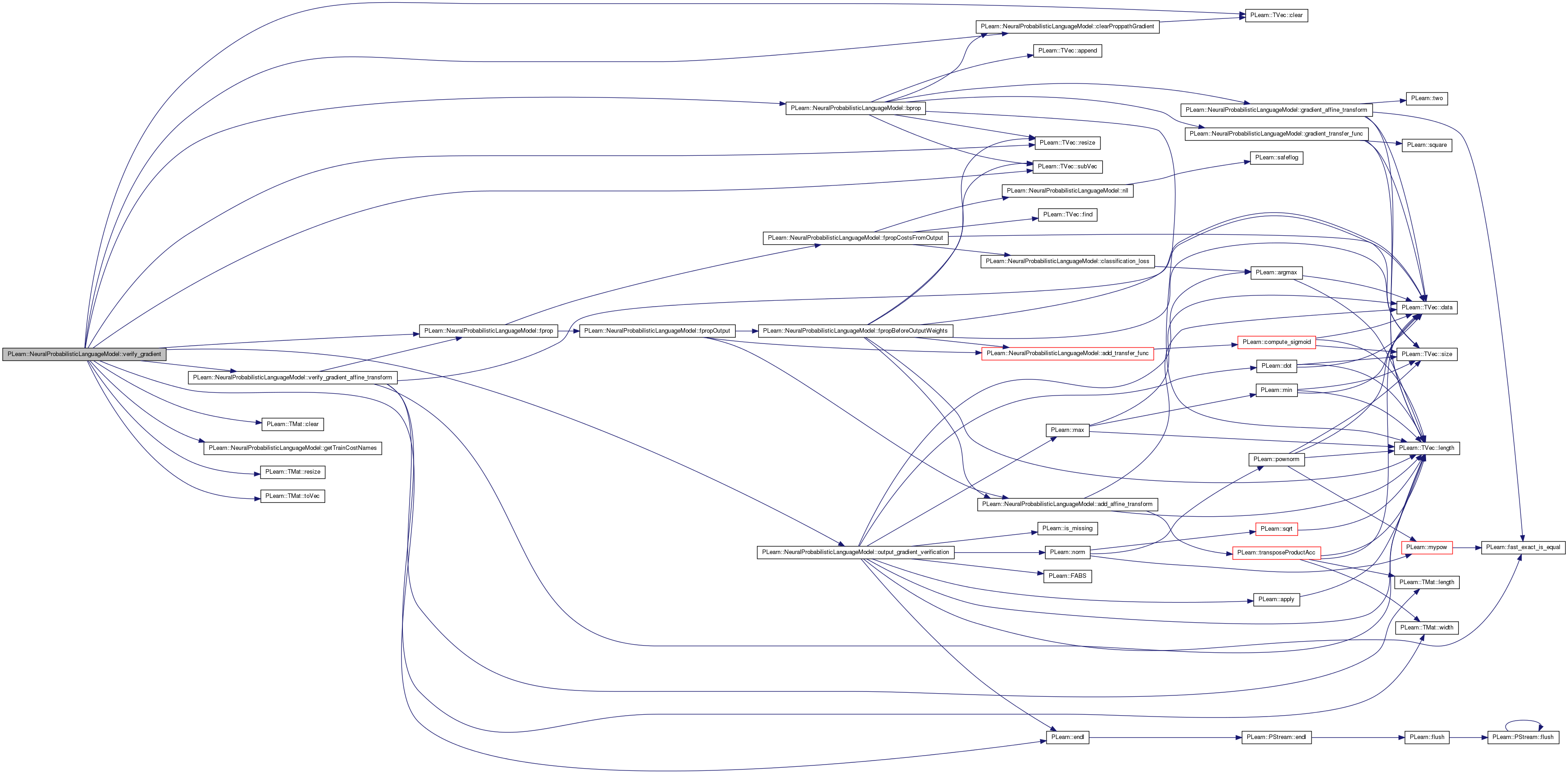
| void PLearn::NeuralProbabilisticLanguageModel::verify_gradient_affine_transform | ( | Vec | global_input, |
| Vec & | global_output, | ||
| Vec & | global_targetv, | ||
| Vec & | global_costs, | ||
| real | sampleweight, | ||
| Vec | input, | ||
| Mat | weights, | ||
| Vec | bias, | ||
| Mat | est_gweights, | ||
| Vec | est_gbias, | ||
| bool | input_is_sparse, | ||
| bool | output_is_sparse, | ||
| real | step, | ||
| Vec | output_indices = Vec(0) |
||
| ) | const [protected] |
Verify gradient of affine_transform parameters.
Definition at line 2874 of file NeuralProbabilisticLanguageModel.cc.
References PLearn::TVec< T >::data(), fprop(), i, j, PLearn::TMat< T >::length(), PLearn::TVec< T >::length(), ni, nj, pval1, pval2, pval3, and PLearn::TMat< T >::width().
Referenced by verify_gradient().
{
real *pval1, *pval2, *pval3;
int ni,nj;
real out1,out2;
// Bias
if(bias.length() != 0)
{
if(output_is_sparse)
{
pval1 = est_gbias.data();
pval2 = bias.data();
pval3 = output_indices.data();
ni = output_indices.length();
for(int i=0; i<ni; i++)
{
pval2[(int)*pval3] += step;
fprop(global_input, global_output, global_targetv,
global_costs, sampleweight);
out1 = global_costs[0];
pval2[(int)*pval3] -= 2*step;
fprop(global_input, global_output, global_targetv,
global_costs, sampleweight);
out2 = global_costs[0];
pval1[(int)*pval3] = (out1-out2)/(2*step);
pval2[(int)*pval3] += step;
pval3++;
}
}
else
{
pval1 = est_gbias.data();
pval2 = bias.data();
ni = bias.length();
for(int i=0; i<ni; i++)
{
*pval2 += step;
fprop(global_input, global_output, global_targetv,
global_costs, sampleweight);
out1 = global_costs[0];
*pval2 -= 2*step;
fprop(global_input, global_output, global_targetv,
global_costs, sampleweight);
out2 = global_costs[0];
*pval1 = (out1-out2)/(2*step);
*pval2 += step;
pval1++;
pval2++;
}
}
}
// Weights
if(!input_is_sparse && !output_is_sparse)
{
ni = weights.length();
nj = weights.width();
for(int i=0; i<ni; i++)
for(int j=0; j<nj; j++)
{
weights(i,j) += step;
fprop(global_input, global_output, global_targetv,
global_costs, sampleweight);
out1 = global_costs[0];
weights(i,j) -= 2*step;
fprop(global_input, global_output, global_targetv,
global_costs, sampleweight);
out2 = global_costs[0];
weights(i,j) += step;
est_gweights(i,j) = (out1-out2)/(2*step);
}
}
else if(!input_is_sparse && output_is_sparse)
{
ni = output_indices.length();
nj = input.length();
pval3 = output_indices.data();
for(int i=0; i<ni; i++)
{
for(int j=0; j<nj; j++)
{
weights(j,(int)*pval3) += step;
fprop(global_input, global_output, global_targetv,
global_costs, sampleweight);
out1 = global_costs[0];
weights(j,(int)*pval3) -= 2*step;
fprop(global_input, global_output, global_targetv,
global_costs, sampleweight);
out2 = global_costs[0];
weights(j,(int)*pval3) += step;
est_gweights(j,(int)*pval3) = (out1-out2)/(2*step);
// if(target_values.length() != 1 && input[j] != 0 && (out1-out2)/(2*step) == 0)
// {
// print_what_the_fuck();
// weights(j,(int)*pval3) += 1;
// fprop(global_input, global_output, global_targetv, global_costs, sampleweight);
// weights(j,(int)*pval3) -= 1;
// cout << "out1 - global_costs[0] =" << out1-global_costs[0] << endl;
// }
}
pval3++;
}
}
else if(input_is_sparse && !output_is_sparse)
{
ni = input.length();
nj = weights.width();
if(ni != 0 )
{
pval3 = input.data();
for(int i=0; i<ni; i++)
{
pval1 = est_gweights[(int)(*pval3)];
pval2 = weights[(int)(*pval3++)];
for(int j=0; j<nj;j++)
{
*pval2 += step;
fprop(global_input, global_output, global_targetv,
global_costs, sampleweight);
out1 = global_costs[0];
*pval2 -= 2*step;
fprop(global_input, global_output, global_targetv,
global_costs, sampleweight);
out2 = global_costs[0];
*pval1 = (out1-out2)/(2*step);
*pval2 += step;
pval1++;
pval2++;
}
}
}
}
else if(input_is_sparse && output_is_sparse)
{
// Weights
ni = input.length();
nj = output_indices.length();
if(ni != 0)
{
pval2 = input.data();
for(int i=0; i<ni; i++)
{
pval3 = output_indices.data();
for(int j=0; j<nj; j++)
{
weights((int)(*pval2),(int)*pval3) += step;
fprop(global_input, global_output, global_targetv,
global_costs, sampleweight);
out1 = global_costs[0];
weights((int)(*pval2),(int)*pval3) -= 2*step;
fprop(global_input, global_output, global_targetv,
global_costs, sampleweight);
out2 = global_costs[0];
est_gweights((int)(*pval2),(int)*pval3) =
(out1-out2)/(2*step);
weights((int)(*pval2),(int)*pval3) += step;
pval3++;
}
pval2++;
}
}
}
}
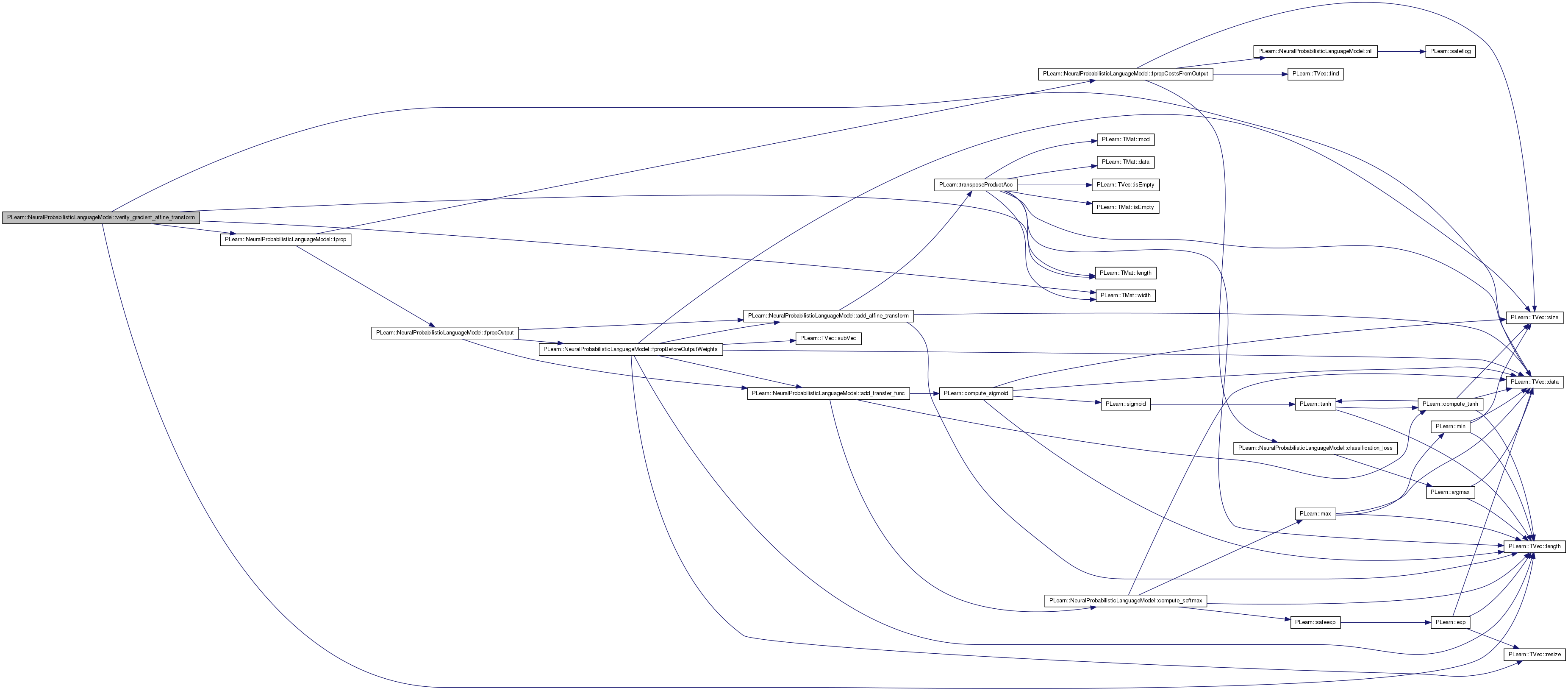

Reimplemented from PLearn::PLearner.
Definition at line 311 of file NeuralProbabilisticLanguageModel.h.
Bias of first hidden layer.
Definition at line 151 of file NeuralProbabilisticLanguageModel.h.
Referenced by bprop(), declareOptions(), fpropBeforeOutputWeights(), importance_sampling_gradient_update(), initializeParams(), makeDeepCopyFromShallowCopy(), train(), update(), and verify_gradient().
Bias of second hidden layer.
Definition at line 159 of file NeuralProbabilisticLanguageModel.h.
Referenced by bprop(), declareOptions(), fpropBeforeOutputWeights(), importance_sampling_gradient_update(), initializeParams(), makeDeepCopyFromShallowCopy(), train(), update(), and verify_gradient().
Number of samples to use to estimate gradient before an update.
0 means the whole training set (default: 1)
Definition at line 255 of file NeuralProbabilisticLanguageModel.h.
Referenced by build_(), declareOptions(), and train().
Bias decay (default:0)
Definition at line 202 of file NeuralProbabilisticLanguageModel.h.
Referenced by bprop(), declareOptions(), gradient_affine_transform(), gradient_penalty(), and importance_sampling_gradient_update().
Bias of output layer.
Definition at line 167 of file NeuralProbabilisticLanguageModel.h.
Referenced by bprop(), declareOptions(), fpropOutput(), getNegativeEnergyValues(), importance_sampling_gradient_update(), initializeParams(), makeDeepCopyFromShallowCopy(), train(), update(), and verify_gradient().
Bias of output layer for distributed representation predictor.
Definition at line 186 of file NeuralProbabilisticLanguageModel.h.
Referenced by bprop(), declareOptions(), fpropBeforeOutputWeights(), importance_sampling_gradient_update(), initializeParams(), makeDeepCopyFromShallowCopy(), train(), update(), and verify_gradient().
Cost functions.
Definition at line 248 of file NeuralProbabilisticLanguageModel.h.
Referenced by bprop(), build_(), clearProppathGradient(), declareOptions(), fpropCostsFromOutput(), getTestCostNames(), getTrainCostNames(), and makeDeepCopyFromShallowCopy().
Decrease constant of gradietn descent.
Definition at line 252 of file NeuralProbabilisticLanguageModel.h.
Referenced by declareOptions(), and train().
Vec PLearn::NeuralProbabilisticLanguageModel::densities [mutable, private] |
Definition at line 82 of file NeuralProbabilisticLanguageModel.h.
Referenced by importance_sampling_gradient_update(), and makeDeepCopyFromShallowCopy().
Direct input to output bias (empty, since no bias is used)
Definition at line 175 of file NeuralProbabilisticLanguageModel.h.
Referenced by bprop(), declareOptions(), fpropOutput(), getNegativeEnergyValues(), importance_sampling_gradient_update(), initializeParams(), makeDeepCopyFromShallowCopy(), update(), and verify_gradient().
If true then direct input to output weights will be added (if nhidden > 0)
Definition at line 238 of file NeuralProbabilisticLanguageModel.h.
Referenced by bprop(), declareOptions(), fpropOutput(), getNegativeEnergyValues(), importance_sampling_gradient_update(), initializeParams(), train(), update(), and verify_gradient().
Weight decay for weights from input directly to output layer (default:0)
Definition at line 223 of file NeuralProbabilisticLanguageModel.h.
Referenced by bprop(), declareOptions(), and importance_sampling_gradient_update().
Direct input to output weights.
Definition at line 171 of file NeuralProbabilisticLanguageModel.h.
Referenced by bprop(), declareOptions(), fpropOutput(), getNegativeEnergyValues(), importance_sampling_gradient_update(), initializeParams(), makeDeepCopyFromShallowCopy(), train(), update(), and verify_gradient().
Dimensionality (number of components) of distributed representations If <= 0, than distributed representations will not be used.
Definition at line 263 of file NeuralProbabilisticLanguageModel.h.
Referenced by bprop(), clearProppathGradient(), declareOptions(), fpropBeforeOutputWeights(), fpropOutput(), getNegativeEnergyValues(), importance_sampling_gradient_update(), initializeParams(), train(), update(), and verify_gradient().
int* PLearn::NeuralProbabilisticLanguageModel::f [mutable, private] |
Definition at line 88 of file NeuralProbabilisticLanguageModel.h.
Referenced by fpropBeforeOutputWeights().
Vec PLearn::NeuralProbabilisticLanguageModel::feat_input [mutable, protected] |
Feature input;.
Definition at line 105 of file NeuralProbabilisticLanguageModel.h.
Referenced by bprop(), fpropBeforeOutputWeights(), fpropOutput(), getNegativeEnergyValues(), importance_sampling_gradient_update(), initializeParams(), makeDeepCopyFromShallowCopy(), and verify_gradient().
FeatureSets to apply on input.
Definition at line 268 of file NeuralProbabilisticLanguageModel.h.
Referenced by build_(), declareOptions(), fpropBeforeOutputWeights(), initializeParams(), and makeDeepCopyFromShallowCopy().
TVec< TVec<int> > PLearn::NeuralProbabilisticLanguageModel::feats [mutable, private] |
Features for each token.
Definition at line 77 of file NeuralProbabilisticLanguageModel.h.
Referenced by bprop(), build_(), fpropBeforeOutputWeights(), importance_sampling_gradient_update(), makeDeepCopyFromShallowCopy(), and verify_gradient().
Features seen in input since last update.
Definition at line 131 of file NeuralProbabilisticLanguageModel.h.
Referenced by bprop(), makeDeepCopyFromShallowCopy(), and update().
If true then the output weights are not learned.
They are initialized to +1 or -1 randomly (default:false)
Definition at line 235 of file NeuralProbabilisticLanguageModel.h.
Referenced by build_(), declareOptions(), and initializeParams().
Set of generated samples from the proposal distribution.
Definition at line 143 of file NeuralProbabilisticLanguageModel.h.
Referenced by importance_sampling_gradient_update(), and makeDeepCopyFromShallowCopy().
real PLearn::NeuralProbabilisticLanguageModel::grad [mutable, private] |
Definition at line 85 of file NeuralProbabilisticLanguageModel.h.
Referenced by gradient_transfer_func().
Vec PLearn::NeuralProbabilisticLanguageModel::gradient [mutable, private] |
Temporary computations variable, used in fprop() and bprop() Care must be taken when using these variables, since they are used by many different functions.
Definition at line 82 of file NeuralProbabilisticLanguageModel.h.
Referenced by makeDeepCopyFromShallowCopy().
Gradient through second hidden layer activation.
Definition at line 123 of file NeuralProbabilisticLanguageModel.h.
Referenced by bprop(), clearProppathGradient(), importance_sampling_gradient_update(), initializeParams(), and makeDeepCopyFromShallowCopy().
Gradient through first hidden layer activation.
Definition at line 117 of file NeuralProbabilisticLanguageModel.h.
Referenced by bprop(), clearProppathGradient(), importance_sampling_gradient_update(), initializeParams(), and makeDeepCopyFromShallowCopy().
Gradient throught output layer activation.
Definition at line 127 of file NeuralProbabilisticLanguageModel.h.
Referenced by bprop(), clearProppathGradient(), initializeParams(), and makeDeepCopyFromShallowCopy().
Gradient on bias of first hidden layer.
Definition at line 153 of file NeuralProbabilisticLanguageModel.h.
Referenced by bprop(), importance_sampling_gradient_update(), initializeParams(), makeDeepCopyFromShallowCopy(), train(), update(), and verify_gradient().
Gradient on bias of second hidden layer.
Definition at line 161 of file NeuralProbabilisticLanguageModel.h.
Referenced by bprop(), importance_sampling_gradient_update(), initializeParams(), makeDeepCopyFromShallowCopy(), train(), update(), and verify_gradient().
Gradient on bias of output layer.
Definition at line 169 of file NeuralProbabilisticLanguageModel.h.
Referenced by bprop(), importance_sampling_gradient_update(), initializeParams(), makeDeepCopyFromShallowCopy(), train(), update(), and verify_gradient().
Gradient on bias of output layer for distributed representation predictor.
Definition at line 189 of file NeuralProbabilisticLanguageModel.h.
Referenced by bprop(), importance_sampling_gradient_update(), initializeParams(), makeDeepCopyFromShallowCopy(), train(), update(), and verify_gradient().
Gradient on direct input to output bias (empty, since no bias is used)
Definition at line 177 of file NeuralProbabilisticLanguageModel.h.
Referenced by bprop(), importance_sampling_gradient_update(), initializeParams(), makeDeepCopyFromShallowCopy(), update(), and verify_gradient().
Gradient on direct input to output weights.
Definition at line 173 of file NeuralProbabilisticLanguageModel.h.
Referenced by bprop(), importance_sampling_gradient_update(), initializeParams(), makeDeepCopyFromShallowCopy(), train(), update(), and verify_gradient().
Gradient on feature input (useless for now)
Definition at line 107 of file NeuralProbabilisticLanguageModel.h.
Referenced by bprop(), importance_sampling_gradient_update(), and makeDeepCopyFromShallowCopy().
Gradient of second hidden layer.
Definition at line 121 of file NeuralProbabilisticLanguageModel.h.
Referenced by bprop(), clearProppathGradient(), importance_sampling_gradient_update(), initializeParams(), and makeDeepCopyFromShallowCopy().
Gradient of first hidden layer.
Definition at line 115 of file NeuralProbabilisticLanguageModel.h.
Referenced by bprop(), clearProppathGradient(), importance_sampling_gradient_update(), initializeParams(), and makeDeepCopyFromShallowCopy().
Vec PLearn::NeuralProbabilisticLanguageModel::gradient_last_layer [mutable, private] |
Gradient of last layer in back propagation.
Definition at line 75 of file NeuralProbabilisticLanguageModel.h.
Referenced by bprop(), importance_sampling_gradient_update(), makeDeepCopyFromShallowCopy(), and train().
Gradient for vector to NNet.
Definition at line 111 of file NeuralProbabilisticLanguageModel.h.
Referenced by bprop(), clearProppathGradient(), importance_sampling_gradient_update(), initializeParams(), and makeDeepCopyFromShallowCopy().
Gradient on output.
Definition at line 125 of file NeuralProbabilisticLanguageModel.h.
Referenced by bprop(), clearProppathGradient(), initializeParams(), and makeDeepCopyFromShallowCopy().
Gradient on weights of first hidden layer.
Definition at line 149 of file NeuralProbabilisticLanguageModel.h.
Referenced by bprop(), importance_sampling_gradient_update(), initializeParams(), makeDeepCopyFromShallowCopy(), train(), update(), and verify_gradient().
gradient on weights of second hidden layer
Definition at line 157 of file NeuralProbabilisticLanguageModel.h.
Referenced by bprop(), importance_sampling_gradient_update(), initializeParams(), makeDeepCopyFromShallowCopy(), train(), update(), and verify_gradient().
Gradient on weights of output layer.
Definition at line 165 of file NeuralProbabilisticLanguageModel.h.
Referenced by bprop(), importance_sampling_gradient_update(), initializeParams(), makeDeepCopyFromShallowCopy(), train(), update(), and verify_gradient().
Gradient on weights of output layer for distributed representation predictor.
Definition at line 183 of file NeuralProbabilisticLanguageModel.h.
Referenced by bprop(), importance_sampling_gradient_update(), initializeParams(), makeDeepCopyFromShallowCopy(), train(), update(), and verify_gradient().
Second hidden layer value.
Definition at line 119 of file NeuralProbabilisticLanguageModel.h.
Referenced by bprop(), fpropBeforeOutputWeights(), importance_sampling_gradient_update(), initializeParams(), makeDeepCopyFromShallowCopy(), and verify_gradient().
Transfer function to use for hidden units (default:"tanh") tanh, sigmoid, softplus, softmax, etc...
Definition at line 246 of file NeuralProbabilisticLanguageModel.h.
Referenced by add_transfer_func(), declareOptions(), and gradient_transfer_func().
Vec PLearn::NeuralProbabilisticLanguageModel::hiddenv [protected] |
First hidden layer value.
Definition at line 113 of file NeuralProbabilisticLanguageModel.h.
Referenced by bprop(), fpropBeforeOutputWeights(), importance_sampling_gradient_update(), initializeParams(), makeDeepCopyFromShallowCopy(), and verify_gradient().
int PLearn::NeuralProbabilisticLanguageModel::id [mutable, private] |
Definition at line 87 of file NeuralProbabilisticLanguageModel.h.
int PLearn::NeuralProbabilisticLanguageModel::ifeats [mutable, private] |
Definition at line 87 of file NeuralProbabilisticLanguageModel.h.
Referenced by bprop(), fpropBeforeOutputWeights(), importance_sampling_gradient_update(), and verify_gradient().
Importance sampling ratios of the samples.
Definition at line 139 of file NeuralProbabilisticLanguageModel.h.
Referenced by importance_sampling_gradient_update(), makeDeepCopyFromShallowCopy(), and train().
Method of initialization for neural network's weights.
Definition at line 260 of file NeuralProbabilisticLanguageModel.h.
Referenced by declareOptions(), and fillWeights().
Vec PLearn::NeuralProbabilisticLanguageModel::last_layer [mutable, private] |
Last layer of network (pointer to either nnet_input, vnhidden or vnhidden2)
Definition at line 73 of file NeuralProbabilisticLanguageModel.h.
Referenced by fpropBeforeOutputWeights(), fpropOutput(), getNegativeEnergyValues(), makeDeepCopyFromShallowCopy(), and verify_gradient().
Bias decay for weights from input layer to first hidden layer (default:0)
Definition at line 208 of file NeuralProbabilisticLanguageModel.h.
Referenced by bprop(), declareOptions(), and importance_sampling_gradient_update().
Weight decay for weights from input layer to first hidden layer (default:0)
Definition at line 205 of file NeuralProbabilisticLanguageModel.h.
Referenced by bprop(), declareOptions(), and importance_sampling_gradient_update().
Bias decay for weights from first hidden layer to second hidden layer (default:0)
Definition at line 214 of file NeuralProbabilisticLanguageModel.h.
Referenced by bprop(), declareOptions(), and importance_sampling_gradient_update().
Weight decay for weights from first hidden layer to second hidden layer (default:0)
Definition at line 211 of file NeuralProbabilisticLanguageModel.h.
Referenced by bprop(), declareOptions(), and importance_sampling_gradient_update().
Margin requirement, used only with the margin_perceptron_cost cost function (default:1)
Definition at line 232 of file NeuralProbabilisticLanguageModel.h.
Minimum effective sample size.
Definition at line 282 of file NeuralProbabilisticLanguageModel.h.
Referenced by declareOptions(), and train().
Number of feature sets.
Definition at line 97 of file NeuralProbabilisticLanguageModel.h.
Referenced by bprop(), build_(), fpropBeforeOutputWeights(), importance_sampling_gradient_update(), initializeParams(), and verify_gradient().
Vec PLearn::NeuralProbabilisticLanguageModel::neg_energies [mutable, private] |
Definition at line 82 of file NeuralProbabilisticLanguageModel.h.
Referenced by importance_sampling_gradient_update(), and makeDeepCopyFromShallowCopy().
int PLearn::NeuralProbabilisticLanguageModel::nfeats [mutable, private] |
Definition at line 87 of file NeuralProbabilisticLanguageModel.h.
Referenced by bprop(), fpropBeforeOutputWeights(), importance_sampling_gradient_update(), and verify_gradient().
Number of hidden nunits in first hidden layer (default:0)
Definition at line 196 of file NeuralProbabilisticLanguageModel.h.
Referenced by bprop(), clearProppathGradient(), declareOptions(), fpropBeforeOutputWeights(), fpropOutput(), getNegativeEnergyValues(), importance_sampling_gradient_update(), initializeParams(), train(), update(), and verify_gradient().
Number of hidden units in second hidden layer (default:0)
Definition at line 198 of file NeuralProbabilisticLanguageModel.h.
Referenced by bprop(), clearProppathGradient(), declareOptions(), fpropBeforeOutputWeights(), fpropOutput(), importance_sampling_gradient_update(), initializeParams(), train(), update(), and verify_gradient().
int PLearn::NeuralProbabilisticLanguageModel::ni [mutable, private] |
Definition at line 87 of file NeuralProbabilisticLanguageModel.h.
Referenced by add_affine_transform(), fpropBeforeOutputWeights(), gradient_affine_transform(), gradient_penalty(), gradient_transfer_func(), update_affine_transform(), and verify_gradient_affine_transform().
int PLearn::NeuralProbabilisticLanguageModel::nj [mutable, private] |
Definition at line 87 of file NeuralProbabilisticLanguageModel.h.
Referenced by add_affine_transform(), fpropBeforeOutputWeights(), gradient_affine_transform(), gradient_penalty(), update_affine_transform(), and verify_gradient_affine_transform().
int PLearn::NeuralProbabilisticLanguageModel::nk [mutable, private] |
Definition at line 87 of file NeuralProbabilisticLanguageModel.h.
Referenced by gradient_transfer_func().
Input vector to NNet (after mapping into distributed representations)
Definition at line 109 of file NeuralProbabilisticLanguageModel.h.
Referenced by bprop(), fpropBeforeOutputWeights(), fpropOutput(), getNegativeEnergyValues(), importance_sampling_gradient_update(), initializeParams(), makeDeepCopyFromShallowCopy(), and verify_gradient().
int PLearn::NeuralProbabilisticLanguageModel::offset [mutable, private] |
Definition at line 86 of file NeuralProbabilisticLanguageModel.h.
Referenced by fpropBeforeOutputWeights().
Vec PLearn::NeuralProbabilisticLanguageModel::output_comp [mutable, private] |
Vector for output computations.
Definition at line 68 of file NeuralProbabilisticLanguageModel.h.
Referenced by build_(), computeOutput(), makeDeepCopyFromShallowCopy(), and verify_gradient().
Bias decay for weights from last hidden layer to output layer (default:0)
Definition at line 220 of file NeuralProbabilisticLanguageModel.h.
Referenced by bprop(), declareOptions(), and importance_sampling_gradient_update().
Bias decay for weights from last hidden layer to output layer of distributed representation predictor (default:0)
Definition at line 229 of file NeuralProbabilisticLanguageModel.h.
Referenced by bprop(), declareOptions(), and importance_sampling_gradient_update().
Weight decay for weights from last hidden layer to output layer of distributed representation predictor (default:0)
Definition at line 226 of file NeuralProbabilisticLanguageModel.h.
Referenced by bprop(), declareOptions(), and importance_sampling_gradient_update().
Weight decay for weights from last hidden layer to output layer (default:0)
Definition at line 217 of file NeuralProbabilisticLanguageModel.h.
Referenced by bprop(), declareOptions(), and importance_sampling_gradient_update().
Transfer function to use for ouput layer (default:"")
Definition at line 243 of file NeuralProbabilisticLanguageModel.h.
Referenced by bprop(), declareOptions(), and fpropOutput().
Penalty to use on the weights (for weight and bias decay) (default:"L2_square")
Definition at line 241 of file NeuralProbabilisticLanguageModel.h.
Referenced by build_(), declareOptions(), gradient_affine_transform(), and gradient_penalty().
Indication that the set of possible targets vary from one input vector to another.
Definition at line 266 of file NeuralProbabilisticLanguageModel.h.
Referenced by bprop(), computeOutput(), declareOptions(), fpropBeforeOutputWeights(), fpropCostsFromOutput(), fpropOutput(), update(), and verify_gradient().
Proposal distribution for importance sampling speedup method (Bengio and Senecal 2006).
If NULL, then this speedup method won't be used. This proposal distribution should use the same symbol int/string mapping as this class uses.
Definition at line 275 of file NeuralProbabilisticLanguageModel.h.
Referenced by build_(), importance_sampling_gradient_update(), and makeDeepCopyFromShallowCopy().
real* PLearn::NeuralProbabilisticLanguageModel::pval1 [mutable, private] |
Definition at line 84 of file NeuralProbabilisticLanguageModel.h.
Referenced by add_affine_transform(), gradient_affine_transform(), gradient_penalty(), gradient_transfer_func(), importance_sampling_gradient_update(), train(), update_affine_transform(), and verify_gradient_affine_transform().
real * PLearn::NeuralProbabilisticLanguageModel::pval2 [mutable, private] |
Definition at line 84 of file NeuralProbabilisticLanguageModel.h.
Referenced by add_affine_transform(), gradient_affine_transform(), gradient_penalty(), gradient_transfer_func(), importance_sampling_gradient_update(), update_affine_transform(), and verify_gradient_affine_transform().
real * PLearn::NeuralProbabilisticLanguageModel::pval3 [mutable, private] |
Definition at line 84 of file NeuralProbabilisticLanguageModel.h.
Referenced by add_affine_transform(), gradient_affine_transform(), gradient_penalty(), gradient_transfer_func(), importance_sampling_gradient_update(), update_affine_transform(), and verify_gradient_affine_transform().
real * PLearn::NeuralProbabilisticLanguageModel::pval4 [mutable, private] |
Definition at line 84 of file NeuralProbabilisticLanguageModel.h.
Referenced by gradient_affine_transform().
real * PLearn::NeuralProbabilisticLanguageModel::pval5 [mutable, private] |
Definition at line 84 of file NeuralProbabilisticLanguageModel.h.
Referenced by gradient_affine_transform().
int PLearn::NeuralProbabilisticLanguageModel::reind_target [mutable, protected] |
Reindexed target.
Definition at line 103 of file NeuralProbabilisticLanguageModel.h.
Referenced by bprop(), clearProppathGradient(), and fpropCostsFromOutput().
PP<PRandom> PLearn::NeuralProbabilisticLanguageModel::rgen [protected] |
Random number generator for parameters initialization.
Definition at line 129 of file NeuralProbabilisticLanguageModel.h.
Referenced by computeOutput(), fillWeights(), initializeParams(), and makeDeepCopyFromShallowCopy().
Vec PLearn::NeuralProbabilisticLanguageModel::row [mutable, private] |
Row vector.
Definition at line 70 of file NeuralProbabilisticLanguageModel.h.
Referenced by build_(), fpropBeforeOutputWeights(), and makeDeepCopyFromShallowCopy().
Vec PLearn::NeuralProbabilisticLanguageModel::sample [protected] |
Generated sample from proposal distribution.
Definition at line 141 of file NeuralProbabilisticLanguageModel.h.
Referenced by build_(), importance_sampling_gradient_update(), and makeDeepCopyFromShallowCopy().
Size of the sampling blocks.
Definition at line 280 of file NeuralProbabilisticLanguageModel.h.
Referenced by declareOptions(), and train().
Start learning rate of gradient descent.
Definition at line 250 of file NeuralProbabilisticLanguageModel.h.
Referenced by declareOptions(), and train().
Indication that a trick to speedup stochastic gradient descent should be used.
Definition at line 258 of file NeuralProbabilisticLanguageModel.h.
Referenced by bprop(), build_(), declareOptions(), importance_sampling_gradient_update(), and train().
string PLearn::NeuralProbabilisticLanguageModel::str [mutable, private] |
Definition at line 83 of file NeuralProbabilisticLanguageModel.h.
Referenced by fpropBeforeOutputWeights().
Vec PLearn::NeuralProbabilisticLanguageModel::target_values [mutable, private] |
Vector of possible target values.
Definition at line 66 of file NeuralProbabilisticLanguageModel.h.
Referenced by bprop(), computeOutput(), fpropBeforeOutputWeights(), fpropCostsFromOutput(), fpropOutput(), makeDeepCopyFromShallowCopy(), and verify_gradient().
VMat PLearn::NeuralProbabilisticLanguageModel::target_values_reference_set [mutable, protected] |
Possible target values mapping.
Definition at line 137 of file NeuralProbabilisticLanguageModel.h.
Referenced by build_(), fpropBeforeOutputWeights(), makeDeepCopyFromShallowCopy(), processDataSet(), test(), and use().
Possible target values seen since last update.
Definition at line 133 of file NeuralProbabilisticLanguageModel.h.
Referenced by bprop(), makeDeepCopyFromShallowCopy(), and update().
Number of features per input token for which a distributed representation is computed.
Definition at line 101 of file NeuralProbabilisticLanguageModel.h.
Referenced by initializeParams(), and verify_gradient().
Total output size.
Definition at line 93 of file NeuralProbabilisticLanguageModel.h.
Referenced by build_(), initializeParams(), train(), and verify_gradient().
Total updates so far;.
Definition at line 95 of file NeuralProbabilisticLanguageModel.h.
Indication that the proposal distribution must be trained (using train_set).
Definition at line 278 of file NeuralProbabilisticLanguageModel.h.
Referenced by build_(), and declareOptions().
real PLearn::NeuralProbabilisticLanguageModel::val [mutable, private] |
Definition at line 85 of file NeuralProbabilisticLanguageModel.h.
Referenced by gradient_affine_transform(), gradient_penalty(), and gradient_transfer_func().
real PLearn::NeuralProbabilisticLanguageModel::val2 [mutable, private] |
Definition at line 85 of file NeuralProbabilisticLanguageModel.h.
Referenced by gradient_affine_transform(), and gradient_penalty().
VMat PLearn::NeuralProbabilisticLanguageModel::val_string_reference_set [mutable, protected] |
VMatrix used to get values to string mapping for input tokens.
Definition at line 135 of file NeuralProbabilisticLanguageModel.h.
Referenced by batchComputeOutputAndConfidence(), build_(), fpropBeforeOutputWeights(), makeDeepCopyFromShallowCopy(), processDataSet(), test(), and use().
Weights of first hidden layer.
Definition at line 147 of file NeuralProbabilisticLanguageModel.h.
Referenced by bprop(), declareOptions(), fpropBeforeOutputWeights(), importance_sampling_gradient_update(), initializeParams(), makeDeepCopyFromShallowCopy(), train(), update(), and verify_gradient().
Weights of second hidden layer.
Definition at line 155 of file NeuralProbabilisticLanguageModel.h.
Referenced by bprop(), declareOptions(), fpropBeforeOutputWeights(), importance_sampling_gradient_update(), initializeParams(), makeDeepCopyFromShallowCopy(), train(), update(), and verify_gradient().
Weight decay (default:0)
Definition at line 200 of file NeuralProbabilisticLanguageModel.h.
Referenced by bprop(), declareOptions(), gradient_affine_transform(), gradient_penalty(), and importance_sampling_gradient_update().
Weights of output layer.
Definition at line 163 of file NeuralProbabilisticLanguageModel.h.
Referenced by bprop(), declareOptions(), fpropOutput(), getNegativeEnergyValues(), importance_sampling_gradient_update(), initializeParams(), makeDeepCopyFromShallowCopy(), train(), update(), and verify_gradient().
Weights of output layer for distributed representation predictor.
Definition at line 180 of file NeuralProbabilisticLanguageModel.h.
Referenced by bprop(), declareOptions(), fpropBeforeOutputWeights(), importance_sampling_gradient_update(), initializeParams(), makeDeepCopyFromShallowCopy(), train(), update(), and verify_gradient().
 1.7.4
1.7.4